Many ghost towns are shells of what they were during their rough and rowdy heydays, but each leaves a clue about the history of the state and its impressive mining history. After all, it was mining that lead the masses flocking to what would become the Golden State.
Most of these California ghost towns are in remote locations, but each has a fascinating story to tell. Use this guide to find a ghost town on your next road trip route, and spend a couple hours exploring.
12 California Ghost Towns to Visit
Calico Ghost Town
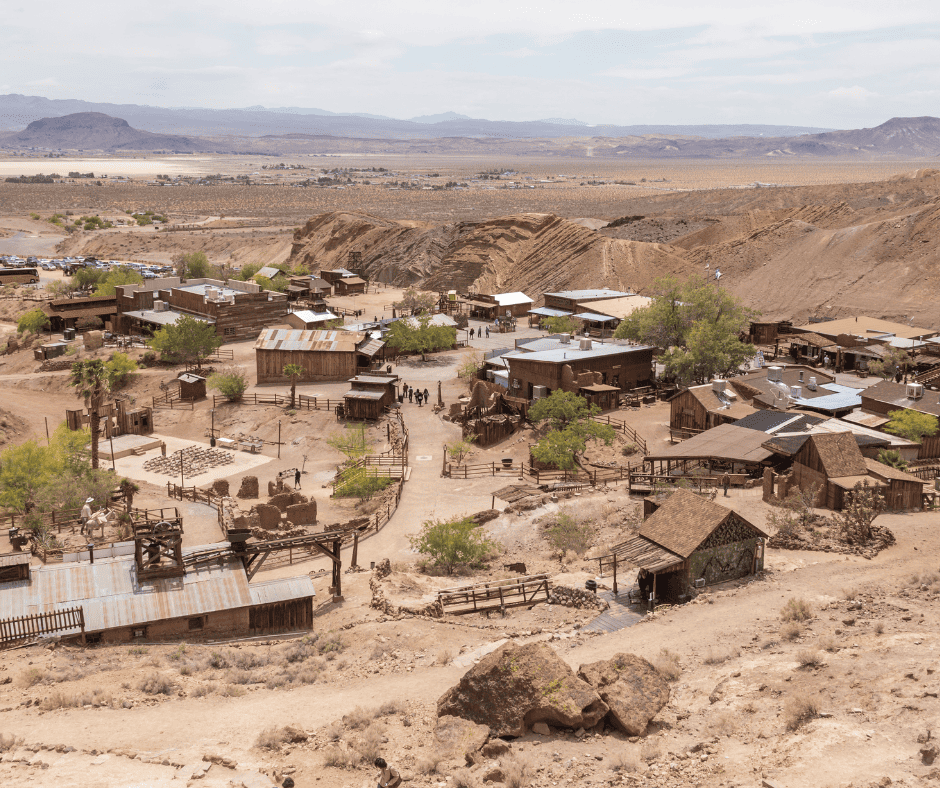
If you have driven Interstate 15 from Southern California to Las Vegas, you have passed right by Calico Ghost Town. This California ghost town is located just outside of Barstow and is the most popular ghost town in the state.
Calico was founded in 1881 during the silver mining boom in California. The town quickly grew as miners flocked to the area in search of silver. The boom in silver mining, however, was short-lived. By the mid-1890s, the price of silver dropped, leading to the closure of many mines. As a result, Calico’s population dwindled, and the town was eventually abandoned.
In the 1950s, Walter Knott, of Knott’s Berry Farm fame, purchased Calico and began to restore the town which eventually became a county park and popular tourist attraction. The town is designed to reflect its late 19th-century appearance.
The Calico Odessa Railroad is a narrow-gauge railroad which gives visitors train rides around the town. I remember taking a field trip out Calico when I was in kindergarten and abolutely loving that train ride!

There are also several historic buildings to explore including the former schoolhouse, general store, and the Maggie Mine. Visitors can walk 1000 feet into Maggie Mine as they take a self-guided tour and look at minerals in the rock and learn about the mine and the miners that worked there in the late 19th century.
If you have ever been to Knott’s Berry Farm, then you will be familiar with the Mystery Shack where water runs uphill and crooked rooms play mind tricks. Mr. Knott added a Mystery Shack to Calico Ghost Town and it is always fun to explore. There is also gold panning onsite where kids will be excited to take home some iron pyrite aka: Fool’s Gold.
For $12, adults can purchase a package that allows them to tour the mine, visit the Mystery Shack, and pan for gold. Kids 5 – 11 are just $6. The railroad is a separate cost- $5.50 for adults and $3 for kids.
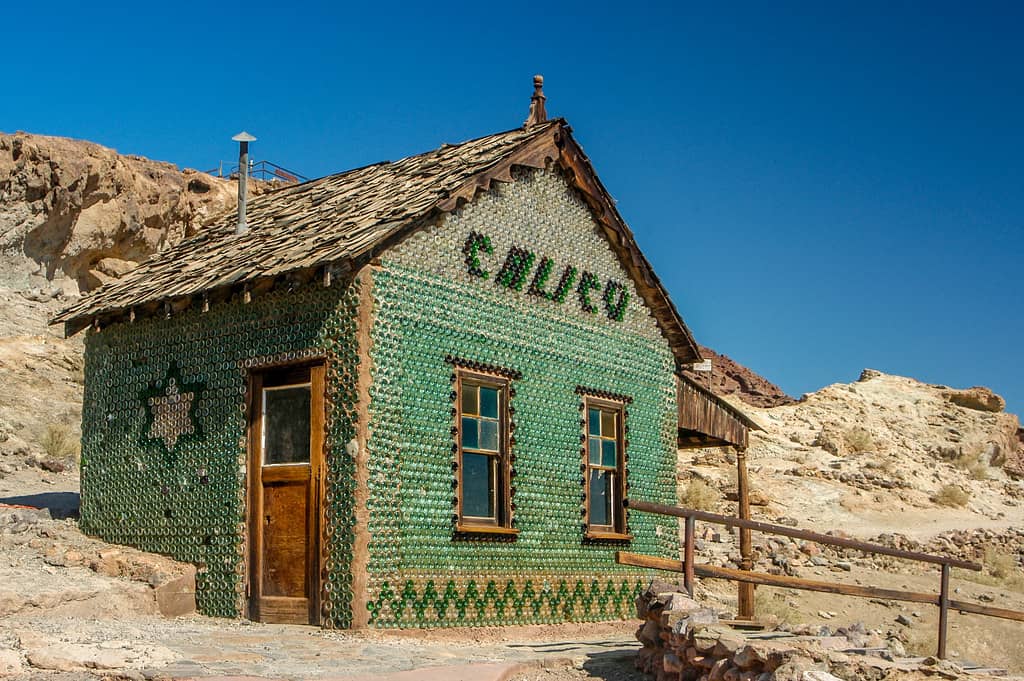
In addition to the special attractions there is a restored schoolhouse, town hall, bottle house, general store, woodworking shop, mineral shop, old-time photo store, and a handful of other shops. The Lucy Lane Museum has artifacts, photographs and documents from Calico’s origin. There are a couple restaurants serving food as well.
During last two weekends in October Calico Ghost Town hosts Town of Terror with scary attractions from 5-9pm on Fridays and 5-10pm on Saturdays. They also host three different ghost tours- Main Street, Maggie Mine, and Schoolhouse. Tours happen on Saturday nights at 6pm and 7:30pm.
Calico Ghost Town is open from 9am to 5pm daily, except on Christmas Day.
Here are 75 California landmarks you need to visit.
Bodie State Historical Park Ghost Town
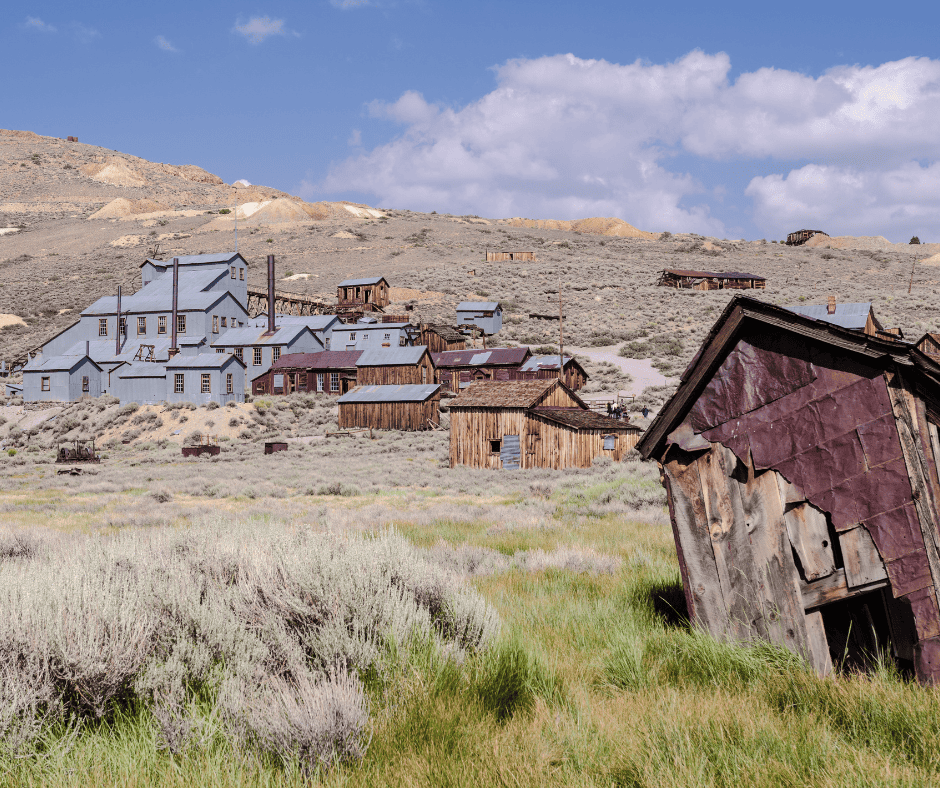
Bodie State Historical Park is a California ghost town in the Eastern Sierra, about 75 minutes north of the popular Mammoth Lakes resort area and 30 minutes east of the town of Bridgeport. It is one of the best-preserved ghost towns in the United States.
Bodie made our list of the best state parks in California. See what other parks made the list!
It began as a small mining camp after gold was discovered in the area in 1859. The town was named after Waterman S. Body (William Bodey), who discovered gold there. In the 1870s and 1880s, the town “boomed” as gold mining operations expanded. At its peak, Bodie had a population of around 10,000 people and was known for its rough and lawless reputation.
The Standard Mine, one of the most productive in Bodie, yielded millions of dollars in gold during its operation but like many other mining towns, Bodie’s prosperity was short-lived. By the early 20th century, the gold began to run out, and the town’s population started to decline. By the 1940s, Bodie was almost entirely deserted.
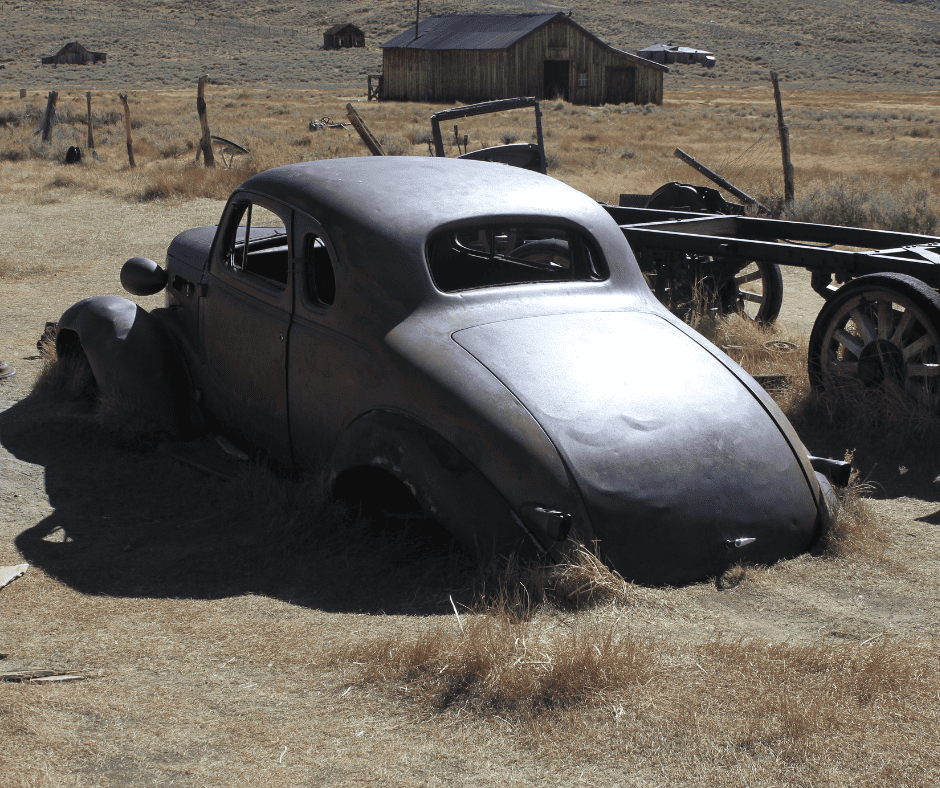
Thankfully, in 1962, the State of California took over the Bodie State Historic Park, and efforts were made to preserve the town in a state of arrested decay. This means that the buildings are maintained but not restored to a pristine condition, giving visitors a sense of how the town looked when it was abandoned. Visitors will discover cups left on tables, a wheel barrow dumped over in a yard, and even a tricycle parked on a porch.
Only about five percent remains of the original town of 2,000 buildings, but more than 100 buildings still stand, including homes, stores, a church, and a school. Visitors to Bodie can explore the streets and enter some of the buildings. Guided tours of the Stamp Mill are available during peak season and highly recommended.
Techinically, Bodie is open all year but it is accessible only by skis, snowshoes or snowmobiles during winter months because of its high elevation (8,375′).
Bodie is open to cars and fully staffed with park rangers Memorial Day through Labor Day. The road will close once it starts snowing for the season. It is a 13 mile journey off Highway 395 and the last three miles are unpaved, but most cars are fine on the road. Admission is $8 per adult and $5 per child 4 – 17.
Darwin
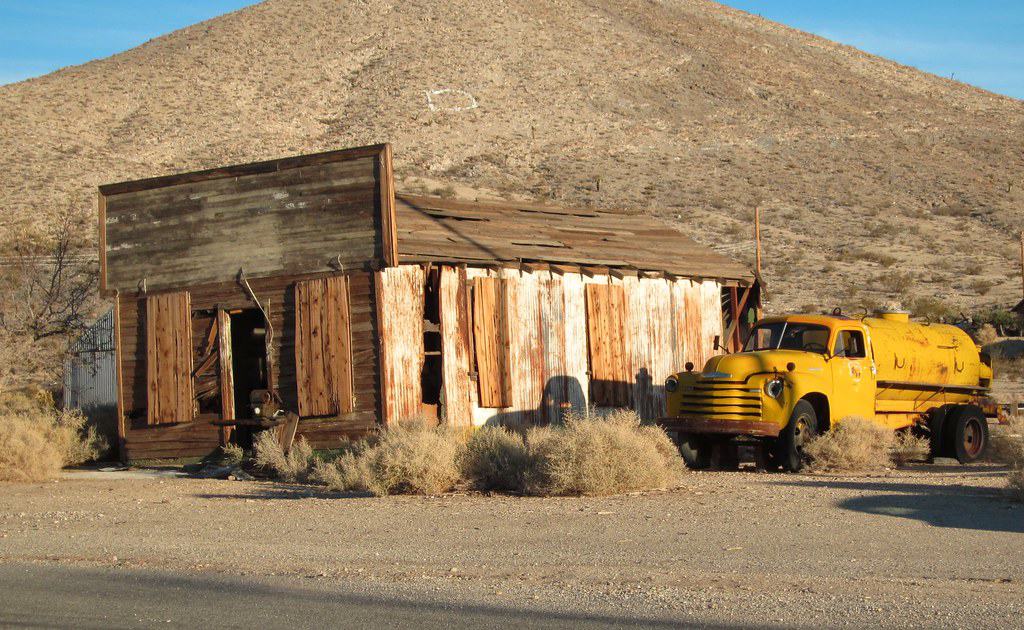
Way out in the middle of nowhere, but not far from the northern reaches of Death Valley, is the town of Darwin, a a quiet, semi-ghost town. It is located in Inyo County, about two hours north of Ridgecrest and 40 minutes south of Lone Pine. About 40 people do still live in Darwin so it isn’t technically deserted, but it might as well be.
Like most California ghost towns, Darwin’s history is tied to mining, particularly lead and zinc. The town experienced its peak during the late 1870s when it had 3500 residents and was the second largest town in the county at the time. It had about 20 operating mines, hundred of homes, a post office, saloons, restaurants, a hotel, and even a newspaper!
It was also a particularly rowdy and lawless town, thanks in big part to its isolation and gun fights and stage robberies were common.
Mining declined due to several factors including an outbreak of small pox, a countrywide economic recession, and the movement of many miners up north to Bodie. An arson fire in 1879 wiped out a big portion of the heart of the town and by 1880, just 85 people remained. Despite the small population, mining did contiinue on some level in the area thorugh the 1970s.
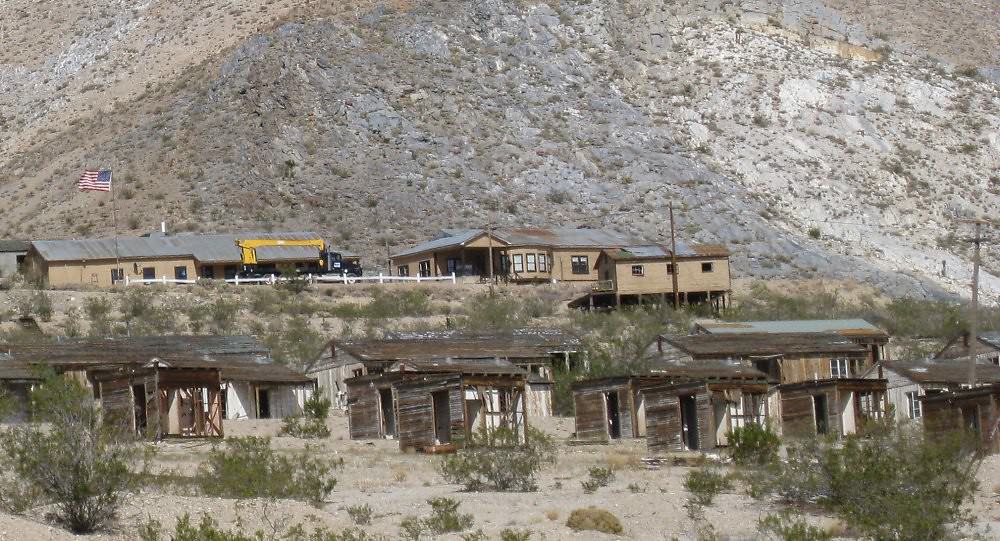
Visitors can explore the remnants of old buildings, mining structures, vehicles, and equipment. The town has an authentic, weathered feel, providing a sense of what life was like during its mining heyday. The remains of the old Defiance smelter still exist as well. On the hillside of Mt. Ophir there are remnants of the company camp, including decaying rows of company houses.
Be respectful of private property and residences when you visit this semi-ghost town.
Panamint City
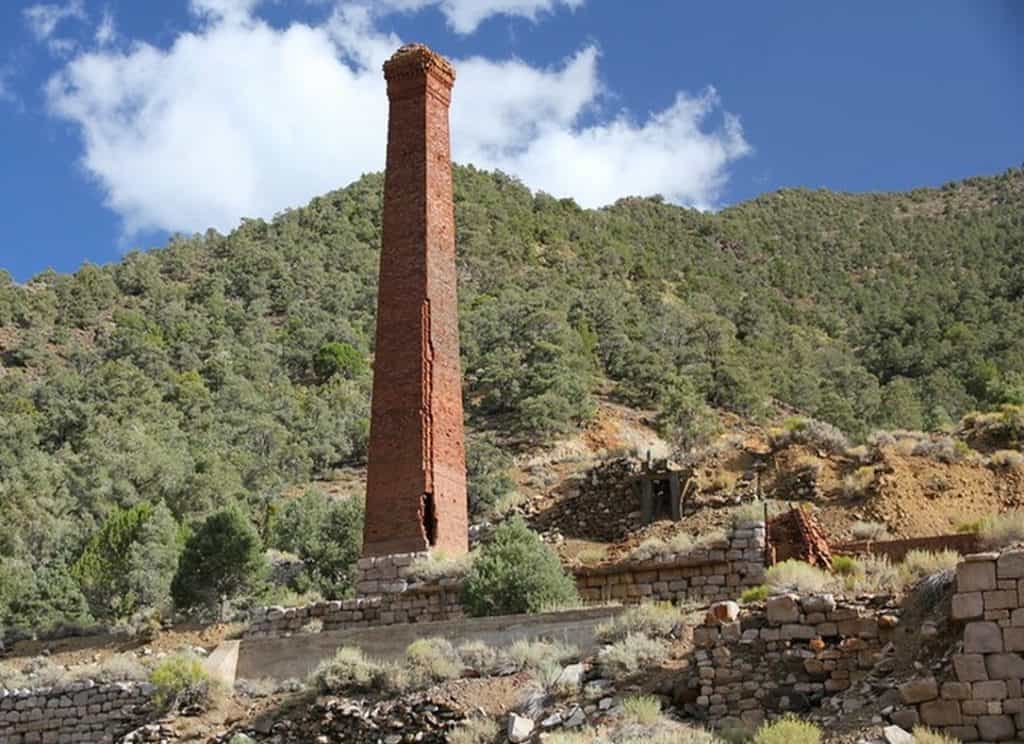
Death Valley has its very own ghost town in the Panamint Mountains of the northern portion of the park. Panamint City was founded by a trio of prospectors in the early 1870s who found a deposit of silver ore in Surprise Canyon. Unfortunately, they were followed into the area by bandits who forced them into a partnership on the profits made by the mine.
It didn’t take long for word to get out about the newly formed Panamint Mining Company and soon hundreds of miners flocked to the area. Soon there were 2,000 people in town, along with saloons, a bank, restaurants, a brewery, a newspaper, and lots of ramshackle houses.
It was an especially wild and lawless area, complete with its very own red light district and dozens of shootings. Alas, the town did not last long. In 1876 two of the main mines were exhausted of ore and a large flood wiped out much of the town.
Not much of this ghost town remains except for some foundations, and the crumbling smokestack of Surprise Valley Mill and Water Company.
Access is challenging, involving a steep and strenuous five-mile hike which should only be attempted by seasoned hikers in the cool season. Here are some of the animals in Death Valley which you may encounter on your hike.
Ballarat
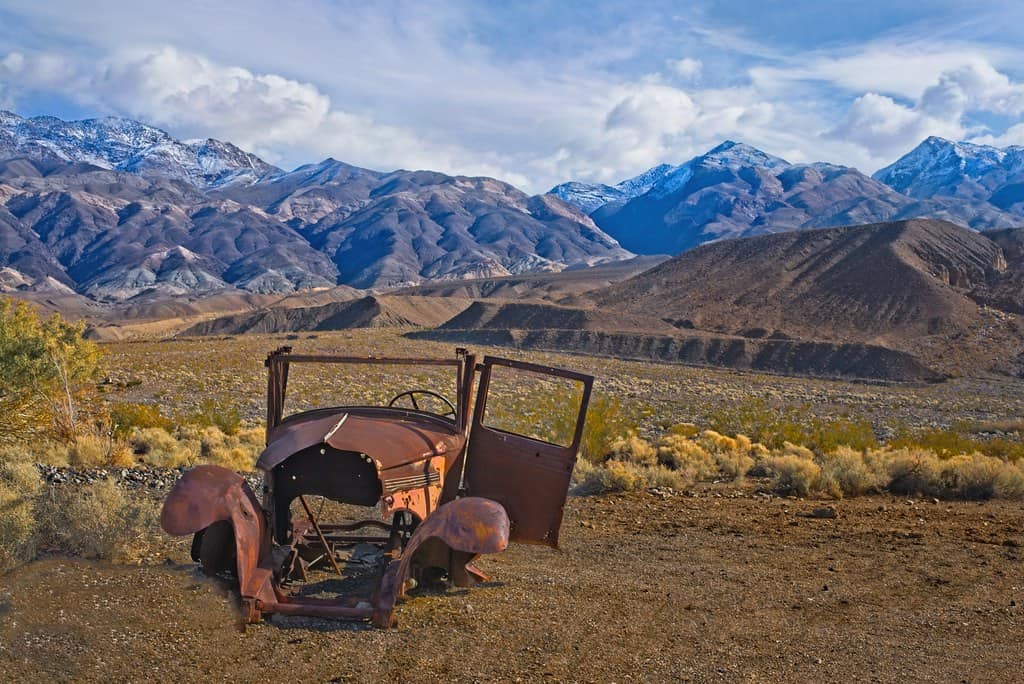
Ballarat is a ghost town in Death Valley National Park at the base of the Panamint Range. It was founded in 1897 to serve as a supply point for the mines in the Panamint Range, including the nearby Ratliff Mine. It was named after the Australian gold mining camp of Ballarat.
Ballarat experienced a boom during the early 1900s as mining activity increased in the Panamint Range. Life was especially tough in the summer, when temperatures would soar over 120 degrees, but 500 hardy folks endured the heat at the town’s peak.
And of course these 500 residents needed seven saloons, because this was the Wild West after all! However, like many other mining towns in the region, its prosperity was short-lived.
What makes this California ghost town especially interesting and unique is its connection with the Manson Family. In the late 1960s, Charles Manson and his followers lived in the area at Barker Ranch south of Ballarat, and members of the Manson Family left graffiti in an old truck they abandoned in town.
Seldom Seen Slim is Ballarat’s most famous resident, who lived in town from around 1918 until his 1968 when he died. He was the last to be buried the town’s cemetary, aka Boot Hill. He claimed to be “half coyote and half wild burro” and said he hadn’t take a bath for 20 years!
There are still a couple people that live in Ballarat and operate a small store. There are remains of old adobe structures to visit as well as several miner cabins. Unlike Darwin, Ballarat is accessible by vehicle, and is located off State Route 178, approximately four miles south of the park boundary.
North Bloomfield

About 15 miles northeast of Nevada City in the heart of Sierra Nevada Gold Country is North Bloomfield, a preserved gold rush town that is now a state park. The town is closely associated with the Malakoff Diggins, one of the largest hydraulic mining operations in California history.
Nevada City is one of our favorite weekend getaways in Northern California.
Originally named Humbug because of some failed gold mining attempts, North Bloomfield was established in 1851 after a few prospectors found gold in a nearby creek. Once gold was discovered in the area, a rush of prospectors and settlers seeking their fortunes flocked to the area.
By the late 1860s, North Bloomfield Gravel Mining Company employed 1100 people, including 800 Chinese workers. The population of the town reached a height of 2000 residents. The company used hydraulic mining which uses highly pressured water to basically blast away mountainsides in the pursuit of gold.
As you can imagine, hydraulic mining was absolutely terrible for the environment and a law was passed in 1884 to make the current system illegal. Once that happened, operations at the mine should have ceased, but they didn’t. Instead they installed a new system to pull debris from the tailings and retain it in holding ponds.
Then the mine basically ignored that law as well as the law passed by Congress in 1893 requiring all hydraulic mines to be licensed. In the late 1800s the law and all the resulting fines caught up with the North Bloomfield Gravel Mining Company and operations were ceased. They left behind a massive pit.
The population continued to dwindle until less than 20 people remained. At that point, the locals urged the state to preserve and protect the historic area. In 1965 Malakoff Diggins State Historic Park was established.
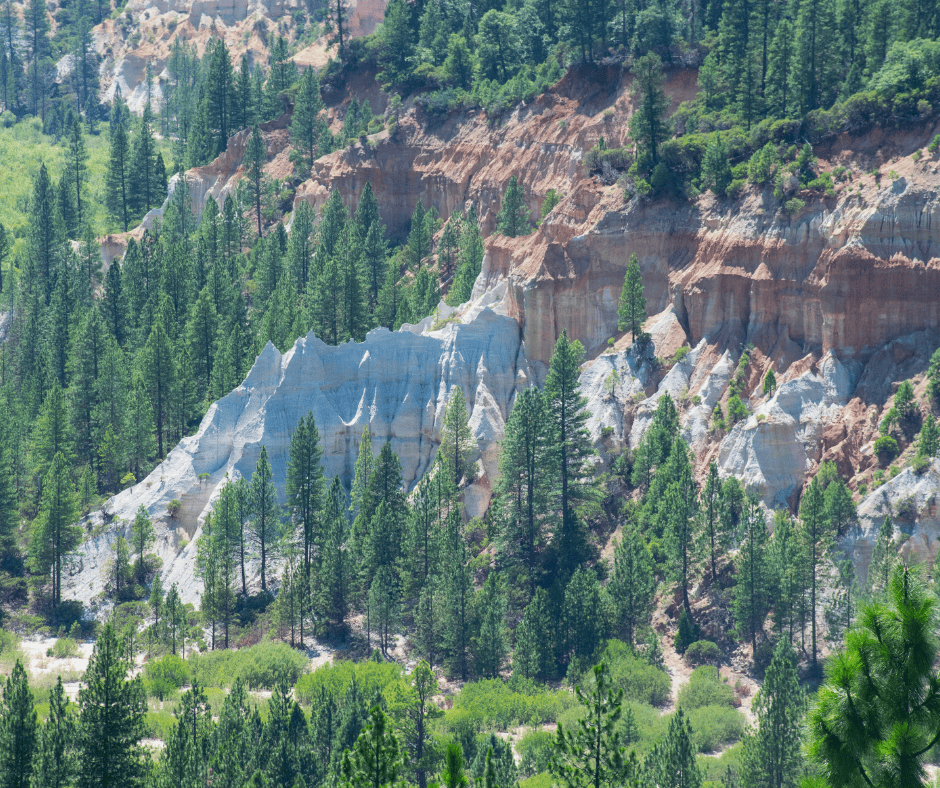
Today, the state park encompasses the remnants of the hydraulic mining infrastructure, including towering cliffs and the townsite. One of the central features of the historic park is the enormous tailings piles resulting from the hydraulic mining operations.
Visitors can also view the restored and operational Malakoff Diggins Dredge, which is a large floating gold dredge that was used to extract gold from the sediment.
Within the park, visitors can explore various historical landmarks, such as the North Bloomfield Schoolhouse, which is a well-preserved one-room schoolhouse dating back to the 1870s, and the cemetery where some early residents are buried. There is also a drug store, church, and several houses.
Three miner’s cabins in North Bloomfield may be reserved for camping. The area is quite scenic and has several miles of trails so spending a couple days here makes for a lovely getaway.
Doble
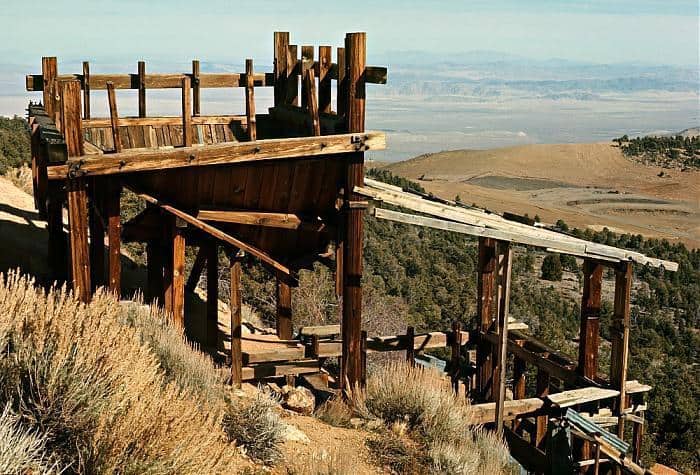
Doble is a former mining community located in the San Bernardino Mountains near Big Bear Lake. It was originally named Bairdstown but the name changed to Doble, named for horse trainer and silent movie actor, Budd Doble.
Doble’s history dates back to the late 1800s when it was primarily a mining and logging town. The area was rich in timber, and the timber industry played a significant role in the town’s early development. In 1875 there was a butcher shop, a bakery, several saloons, three general stores, two livery stables, three restaurants, two hotels, a black smith shop, a cemetery, and much more. This town was legit!
It did experience a brief period of silver mining activity when several mines operated in the surrounding mountains. At that time, the Doble Mine Mill processed 100 tons of ore per day. However, the mining boom was short-lived and last only about 8 months .Another attempt was made to rebuild the mill (the original burned down) in 1899 with a promising new “Cyanide Process” to mine the region’s poor quality ore but the mine shut down in 1903 and the town became a ghost town.
Ruins of the 1875 Stamp Mill and the cemetery are all that remain today. Still, if you are exploring in the Big Bear Lake area, it is worth a stop. Baldwin Lake is within view of the ruins because most of the trees in the area were cut down to help run the steam engine for the stamp mill. Most of the trees in the area these days are second generation growth.
Big Bear Lake is one of our favorite weekend getaways in Southern California.
Laws

Laws is a historic site and former railroad town located in the Owens Valley, a few miles north of the town of Bishop on Highway 395. It is not a traditional ghost town, but rather a preserved area that showcases the history of the Owens Valley and the Eastern Sierra.
Laws began as a station on the Carson and Colorado Railroad in the late 19th century. The railroad played a crucial role in the development of the Owens Valley by providing transportation for mining and agricultural products. It became a hub for maintenance, repairs, and other services related to the operation of the narrow-gauge railroad and an essential stop for trains traveling through the Owens Valley.
The Great Depression hit Laws hard and in 1938, Southern Pacific tore up the rail lines north of town. Still, the town persisted as the northern terminus until the railroad fully shut down the narrow gauge line between Keeler and Laws in 1960.
Today, Laws is home to the Laws Railroad Museum and Historic Site. The museum features a collection of historic buildings, vintage railroad equipment, and artifacts from the late 19th and early 20th centuries. Visitors can explore the original depot, a schoolhouse, a blacksmith shop, and various railway cars. Some of the buildings were moved to their current location inside the museum.
Paramount Pictures made the film, Nevada Smith, on the site in 1966 and the Laws Railroad Museum protects buildings from that set as well. It also houses a collection of steam and diesel locomotives, as well as a variety of rolling stock.
Laws is listed on the National Registry of Historic Places. It is open from 10am – 4pm except for Thanksgiving, Christmas, and New Years Day. Admission is a $10 donation.
Amboy
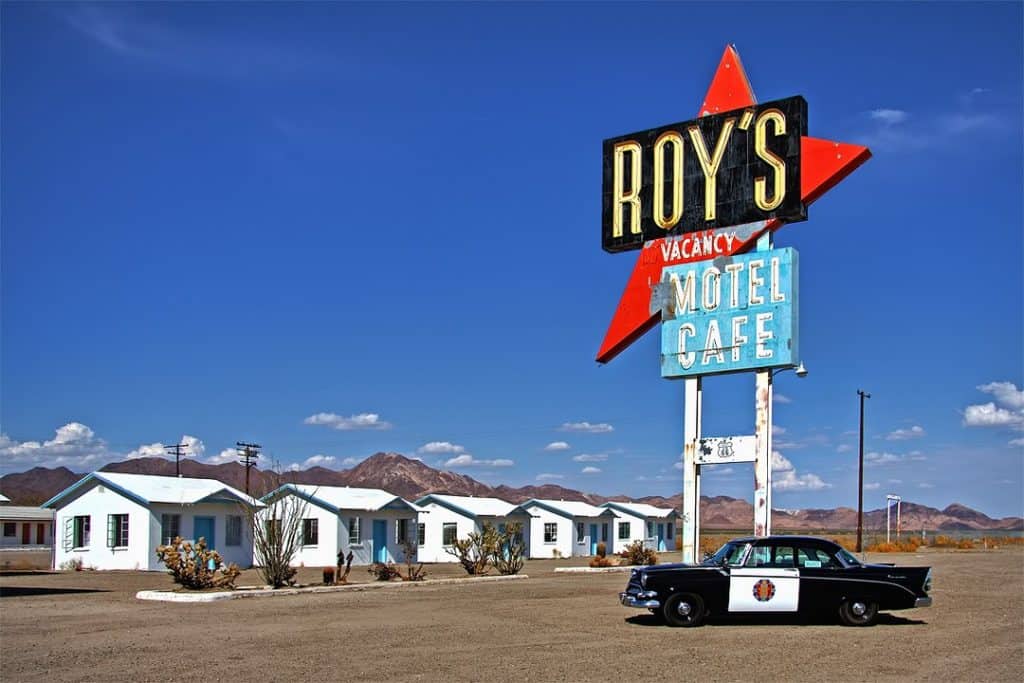
Amboy was founded as a railroad and mining town in the Mojave Desert. However, its location halfway between Barstow and Needle on Route 66, the most popular route out west back before the advent of the Interstate Highway system, made the town a popular tourist stop for travelers heading to California.
When Interstate 40 opened in 1973, 100 miles of Route 66 in the Mojave Desert were basically deserted. And with it went all the towns that lined that stretch, including Amboy.
Amboy began as a mining camp in 1858 and was named in 1883 when the first railway tracks were being built in the area. It was never a big town. Only 200 people lived there during its heyday of the 1930s and 40s. At that time the town had 13 businesses, three gas stations, three motels, a couple cafes, a post office, a church and even a small school.
Amboy is best known for Roy’s Motel and Café, an iconic roadside stop along Route 66. Roy’s became a symbol of the classic American road trip, featuring the distinctive Googie architecture and neon signs that were popular in the mid-20th century.
With the construction of Interstate 40 which bypassed Route 66, traffic through Amboy declined significantly. The town’s businesses struggled, and by the late 20th century, Amboy had become a near-ghost town.
In 2005, Amboy was purchased by Albert Okura, the founder of the Juan Pollo restaurant chain, for just $425,000. Okura aims to restore and preserve the town’s historic features, including Roy’s Motel and Café.
Roy’s, with its classic mid-century design, includes a motel, café, and gas station. While the motel is no longer operational, the café is occasionally open, and the site attracts visitors interested in its nostalgic appeal.
Roy’s famed neon sign was relit in 2019 after many decades of disrepair. There are continued plans to renovate the motel, add a gift shop, update the gas station to be a 24-hour self serve establishment, and get a food permit so the restuarant can once again sell more than food. Installing a water system is another key aspect of the rehab to be tackled.
While in Amboy, make time to visit Amboy Crater, a volcanic cinder cone that rises prominently from the desert landscape. It is a popular hiking destination, offering panoramic views of the surrounding desert.
Randsburg
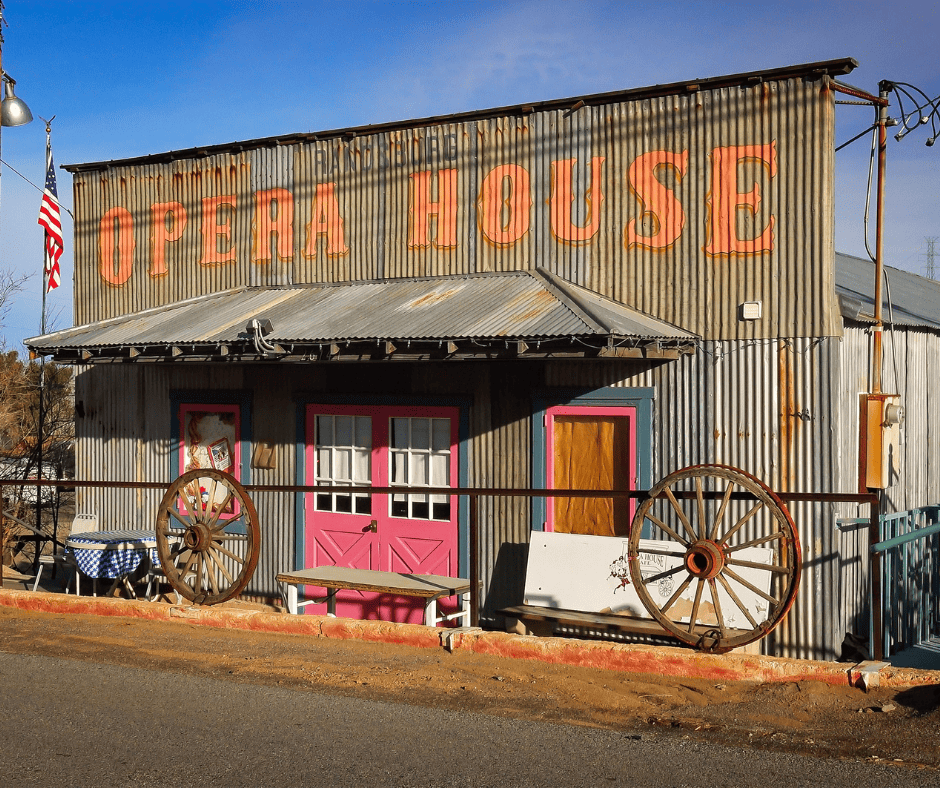
Known as the “Living Ghost Town,” Randsburg has a mix of abandoned and occupied buildings, showcasing its mining and Old West history near the junction of Highway 395 and Highway 14 in the Mojave Desert of Kern County about 17 miles south of Ridgecrest. Less than 50 people live in the area today.
Randsburg’s history began with the discovery of gold in 1895 by three prospectors: John Singleton, Charles Burcham, and Henry Singleton. The discovery sparked a gold rush, leading to the rapid growth of the town.
Randsburg was unique in that it was situated at the junction of three major mining districts: Randsburg, Johannesburg, and Red Mountain. The combined output of these districts contributed significantly to the town’s prosperity.
As the town grew, it developed essential infrastructure such as schools, churches, saloons, and stores. The Yellow Aster Mine, one of the most successful gold mines in the region, brought considerable wealth to the area. The population grew to over 4000 people in the early 1900s.
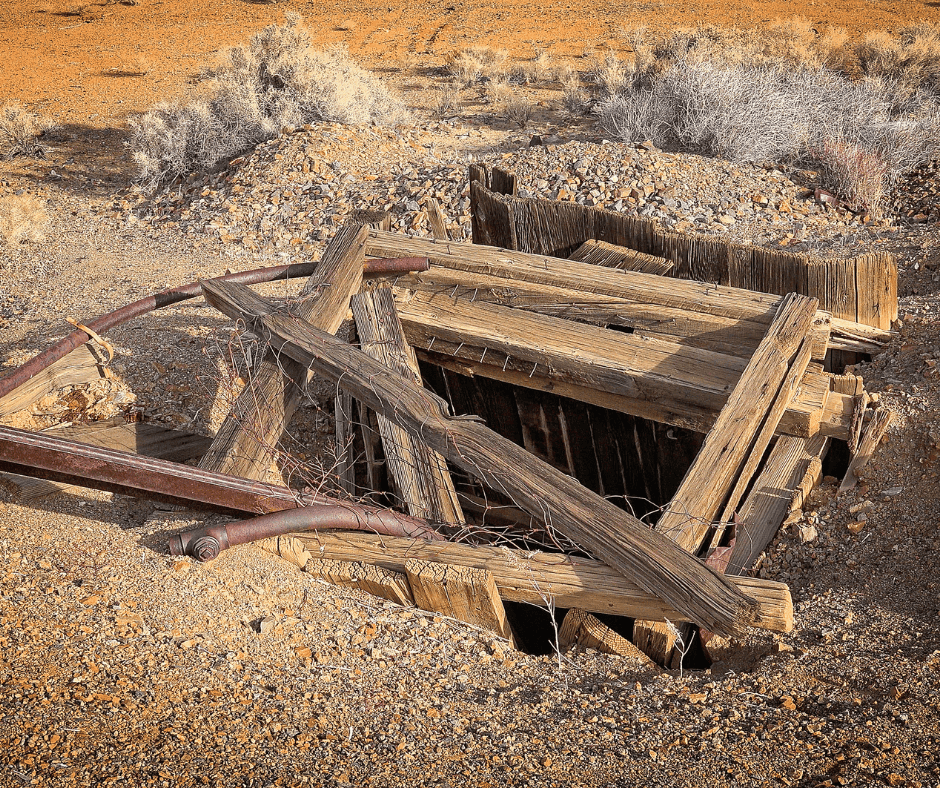
Like many mining towns, Randsburg faced a decline in the early 20th century as the easily accessible gold was depleted. The town’s population dwindled, and many businesses closed, especially during World War II when mining for gold was considered non-essential. However, some mining operations continued into the mid-20th century.
In the latter part of the 20th century, there was renewed interest in preserving and restoring Randsburg’s historic buildings. Many structures from the town’s heyday still stand, providing visitors with a glimpse into its past. Randsburg has been designated a California Historical Landmark (#285) due to its significance in the state’s history as a major mining town during the Gold Rush era.
Today, Randsburg is a popular tourist attraction, drawing visitors with its well-preserved ghost town atmosphere. Visitors can explore the historic district, including the 1896 White House Saloon, opera house, a tiny jail cell, and other vintage and dilapidated structures and rusted-out abandoned vehicles.
Be sure to visit the Randsburg General Store which opened in the 1930s. It has a soda fountain from 1904 where you can still order soda, shakes, and ice cream sundaes.
Shasta State Historic Park
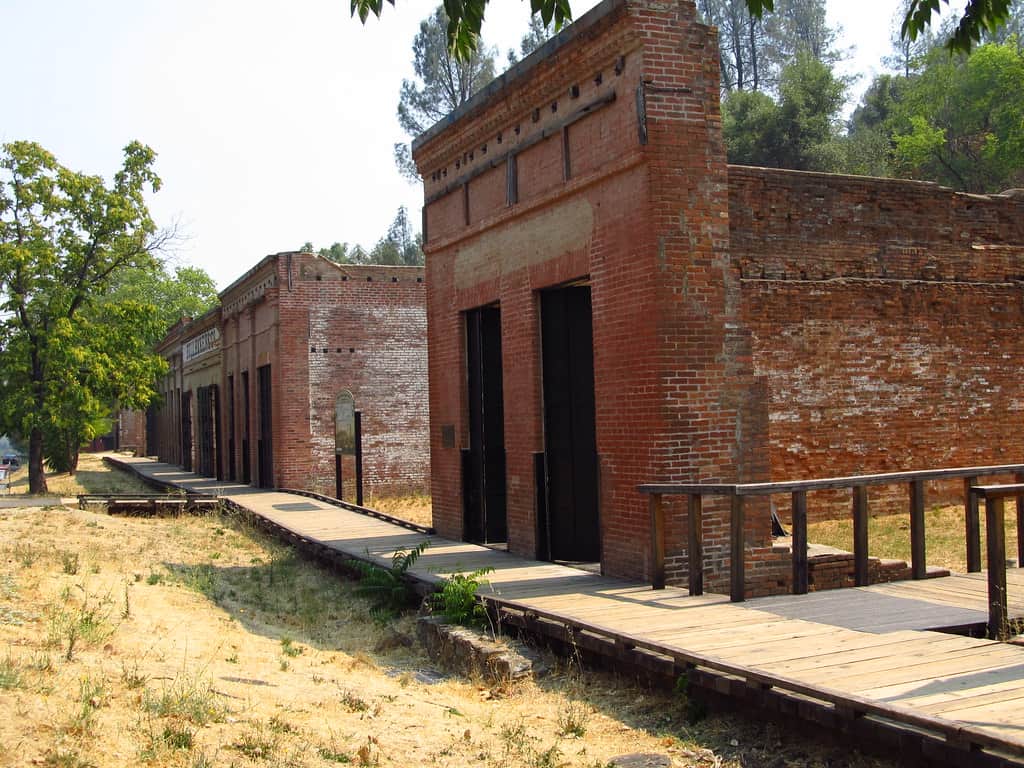
Shasta State Historic Park protects and preserves the remains of old Shasta City, a ghost town north of Redding. Shasta was founded during the California Gold Rush in the early 1850s. Gold was discovered in the area, leading to a rapid influx of settlers and the establishment of a mining and commercial community.
Shasta quickly became an important commercial and transportation hub in the region. It was known as the “Queen City of the Northern Mines” and served as a supply center for miners and travelers heading to the goldfields.
The town boasted numerous businesses including hotels, saloons, general stores, and a theater. The construction of a courthouse and jail reflected Shasta’s aspirations to become the county seat. The town was plagued by fires, once in December of 1852 and again six months later, but the residents quickly rebuilt.
Gold claims in the area were largely depleted in the late 1860s and the towns prominence further waned as other transportation routes, such as the railroad, bypassed the town. By 1888 the county seat was moved to Redding and many of the buildings were left abandoned.
Beginning in the 1920s, efforts were made to preserve the historic structures in Old Shasta. The California State Parks Commission began purchasing some of the old buildings, eventually forming Shasta State Historic Park, which covers over 300 acres.
The park preserves the historic district of Old Shasta, including the Litsch General Store, jail, blacksmith shop, and the Blumb Bakery. The ruins of the original brick courthouse, which burned down in 1861, has been rebuilt and is filled with historic exhibits. The park also offers interpretive programs, guided tours, and living history events.
Cerro Gordo
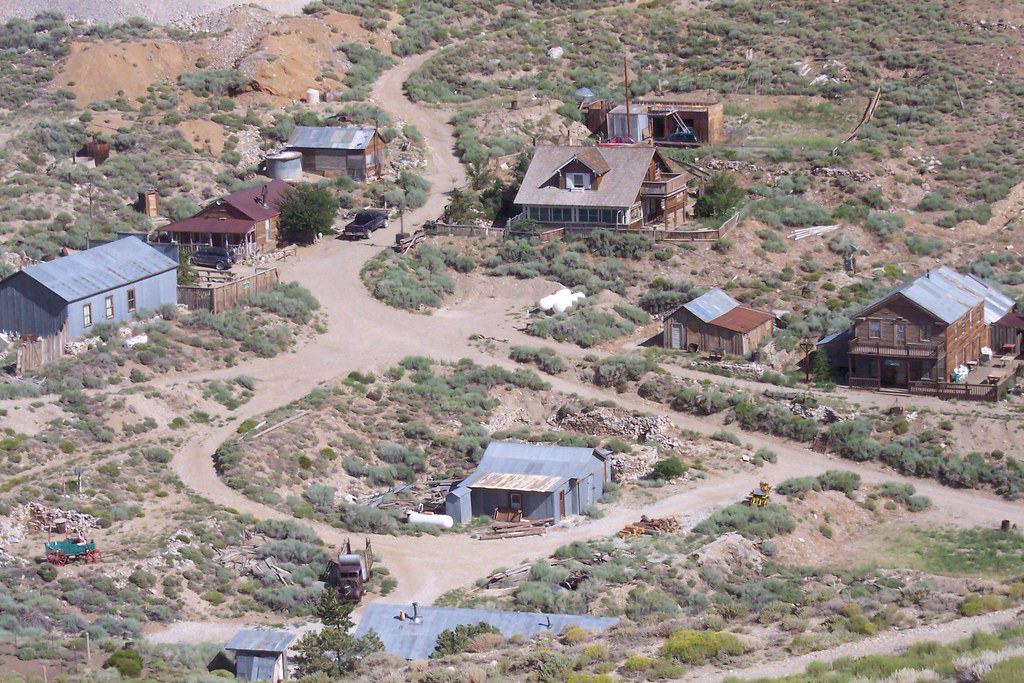
Cerro Gordo is a historic mining town located in the Inyo Mountains of eastern California, near the town of Lone Pine. It gained prominence after the discovery of rich veins of silver was made by Pablo Flores in 1865. By 1867, word had gotten out and people began flocking to the area.
By the mid-1870s, Cerro Gordo experienced a mining boom and the town quickly grew into a bustling mining community, attracting fortune-seekers from different parts of the country.
The mines in Cerro Gordo were known for their high-grade silver ore, and the town became one of the most significant silver producers in California. At its peak, it was producing millions of dollars’ worth of ore annually.
The town boasted a range of structures, including mines, mills, a general store, saloons, a hotel, and housing for the miners and their families. The town’s growth reflected the prosperity brought by mining activities. It was also quite lawless and at one point there was a murder a week!
Cerro Gordo’s remote location in the Inyo Mountains posed significant challenges for transportation and logistics. Supplies and ore had to be transported over difficult mountain roads, adding to the town’s isolation. There was also a lack of water and timber which added to the town’s challenges.
As the easy-to-access silver ore was depleted, Cerro Gordo experienced a decline in the late 19th century. The town went through periods of boom and bust over the years, with mining operations intermittently resuming. During the early 20th century, zinc became the towns’s main ore export.
These days, the town is privately owned. Cerro Gordo has gained notoriety in recent years since one of town’s owners, Brent Underwood, moved to the town in 2020 and began a very popular YouTube channel (over 1.6 million subscribers!) about life in the ghost town and his efforts to bring it back to life as a tourist destination.
The preservation efforts aimed at maintaining its historical integrity. Several of the town’s structures have been stabilized and restored, helping to preserve the town’s unique character. The American Hotel, which was built in 1871, burned down in 2020 and is currently being rebuilt for guests to enjoy.
Cerro Gordo is accessible by a rough mountain road, and visitors are advised to check conditions before attempting the journey. Most people who visit these days are volunteering to help restore the property. Hopefully in a few years it will be open for overnight stays. The best way to keep up with the town’s progress is to follow the YouTube channel.
]]>As a lifelong California resident, I have traveled up and down the state, searching out state parks with an aim to visit them all. Each has something special to offer, but some California State Parks are certianly better than others. Here are my picks for the best California State Parks, from the redwood studded coastline in the north to the desert filled with life in the south.
The 30 Best California State Parks
Prairie Creek Redwoods State Park
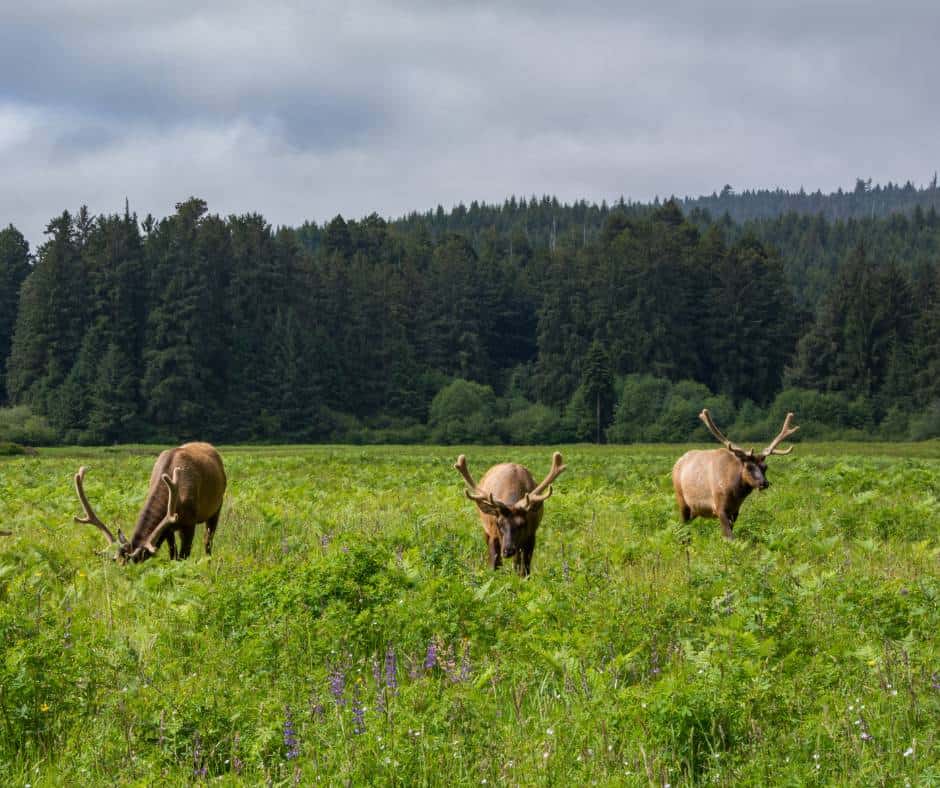
Why this park one of the best California State Parks: Elk, redwoods, and a lush canyon lined with ferns.
Best Time to Visit: Summer and fall. Winter brings rains which can make the road to Fern Canyon impassible.
Are Dogs Allowed? Yes, but dogs are not allowed on trails in this park.
Where to Stay: Gold Bluffs Beach Campground if you are camper. Stay in one of the many charming VRBOs near the park if you prefer four walls and a bed.
Located in the northwestern corner of the state north of Eureka is Prairie Creek Redwoods State Park, one of the four state parks that help make up the Redwood National and State Parks complex.
Prairie Creek is a special park not only for its towering trees, but also for its resident population of Roosevelt elk. In 1925, there were as few as 15 of these elk left in the California redwoods. Nearly 100 years later, the population has rebounded to 1,000.
The elk can be seen thoughout the park, but are most often seen on Elk Prairie near the park’s southern entrance, along Davidson Road west of Highway 101, and on Gold Bluffs Beach.
The road to Gold Bluff’s Beach is unpaved and there are a couple stream crossings, but it is usually quite easy to manage in the summer and fall, or when there haven’t been any recent rains.
After checking out the elk on the beach, head to Fern Canyon, one of the most beautiful places in the California State Parks system. Jurassic Park 2: The Lost World was filmed in this 50-foot fortress of walls, covered in ferns. It is lush and shady, with a creek running through.
It is only one mile in length, making it an easy hike where you will want to take your time and enjoy the spectacular scenery. During the summer months, wooden slats act as footbridges to help keep your shoes dry.
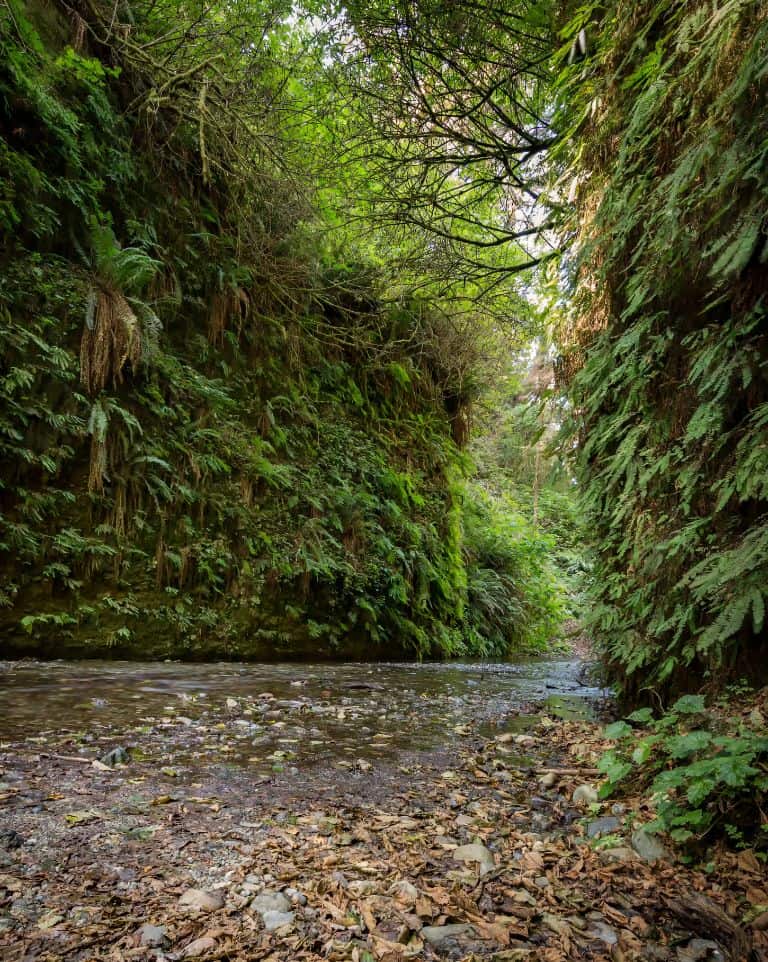
After checking out the elk on the beach, head to Fern Canyon, one of the most beautiful places in the California State Parks system. Jurassic Park 2: The Lost World was filmed in this 50-foot fortress of walls, covered in ferns. It is lush and shady, with a creek running through.
It is only one mile in length, making it an easy hike where you will want to take your time and enjoy the spectacular scenery. During the summer months, wooden slats act as footbridges to help keep your shoes dry.
Note: This park now requires Day Use Permits to access Gold Bluffs Beach and Fern Canyon from May 1st – September 30th. Permits for the 2023 season can be reserved by the public beginning April 15th.
Prairie Creek Redwoods State Park is also one of our favorite Northern California weekend getaways.
Jedediah Smith Redwoods State Park
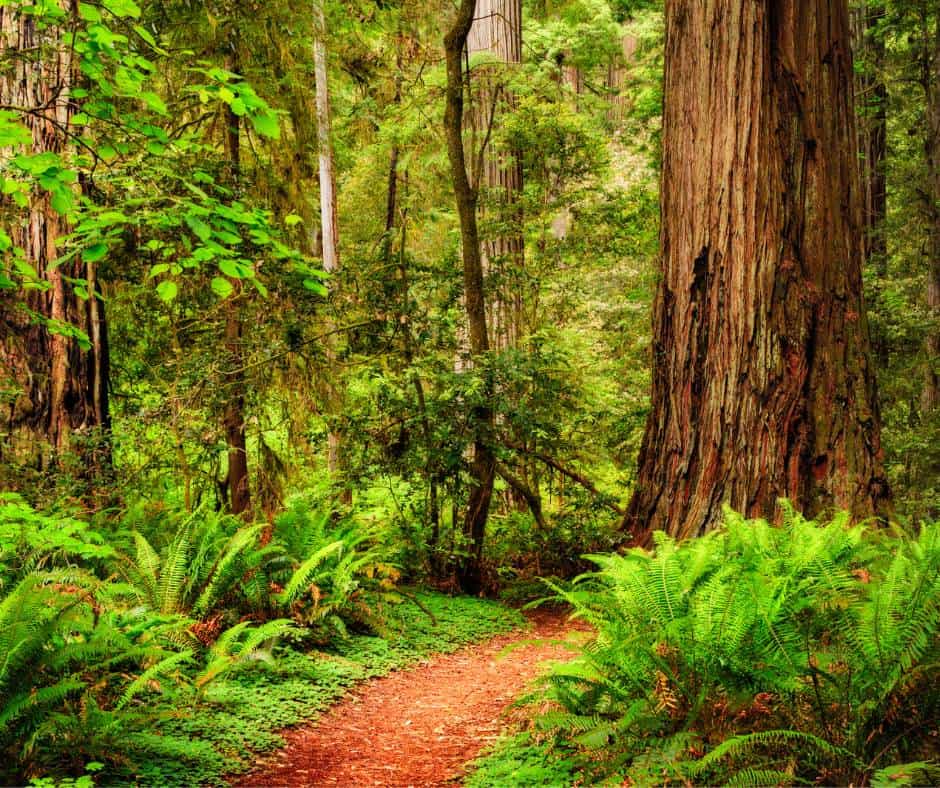
Why this park one of the best California State Parks: It preserves old growth redwoods and offers great camping along the crystal-clear Smith River.
Best Time to Visit: Spring through fall
Are Dogs Allowed? Yes, but dogs are not allowed on trails in this park.
Where to Stay: Campers will love staying at the Jedediah Smith Redwoods Campground which sits along the tall trees alongside the Smith River. There are several hotel options in nearby Crescent City, including Oceanview Inn and Suites which has family suites with three beds!
The northernmost California State Park that protects old growth redwoods is Jedediah Smith Redwoods State Park. It located just 15 miles from the Oregon border, nine miles east of Crescent City. It is home to a lush rainforest and the crystal clear Smith River, the longest major free-flowing river in California.
Some of the trees that live in this park has been growing for over 1,000 years! Stout Grove is a great place to walk among these other-wordly trees. It is a one-mile loop trail through the towering trees which are hugged by the lush stands of ferns below. Fallen redwoods act as nursery trees for new life. You will see a variety of plants and even new redwood trees growing out of them.
Make time to enjoy the beauty of the Smith River. You can fish. kayak, and even snorkel in the river! Or, simply sit along its banks and enjoy a picnic surrounded by incredible scenery.
Did you know? California State Parks started a pilot program with a new FREE pass which allows access to 19 California State Parks to 4th graders and their families. Jedediah Smith Redwoods State Park is one of those parks.
Año Nuevo State Park
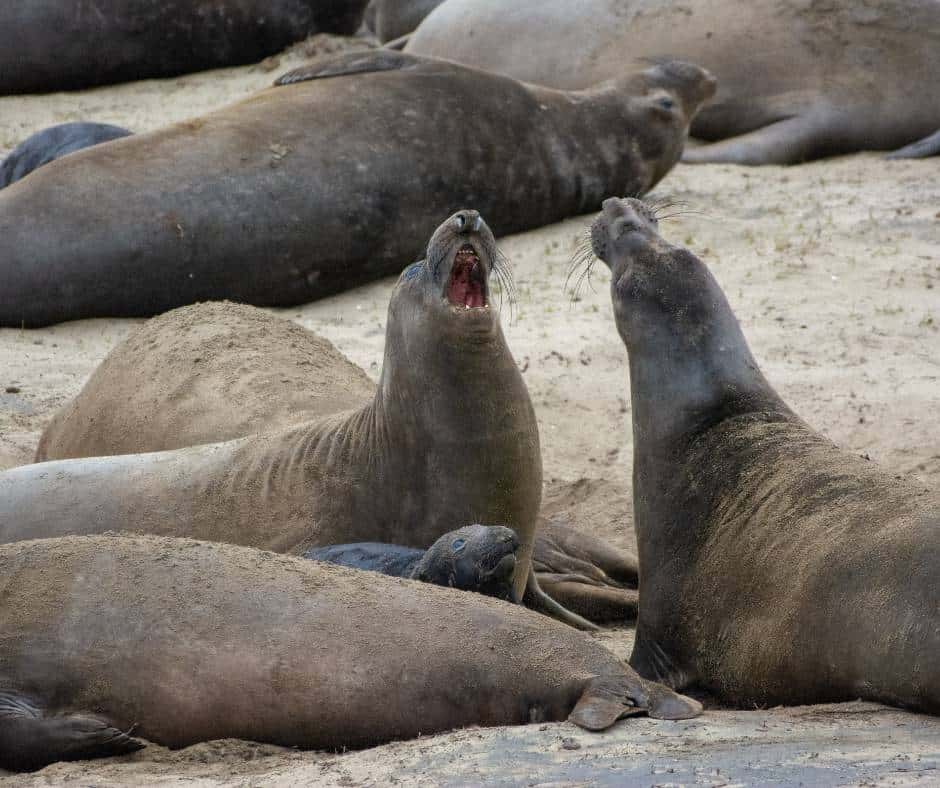
Why this park one of the best California State Parks: It protects a massive colony of elephant seals that are incredibly entertaining to watch.
Best Time to Visit: December 15th through March. December is peak time to watch mating battles and see brand new elephant seal babies.
Are Dogs Allowed? No
Where to Stay: Book an ocean-view cottage on VRBO or book an unforgettable stay in Pigeon Point Lighthouse Hostel.
Every December, up to 10,000 elephant seals come to breed on Año Nuevo Beach. Elephant seals spend most of their lives in the ocean, but they do come ashore every year to breed and give birth.
If you haven’t watched the raucous spectacle that is a colony of elephant seals before, you are really missing out! These creatures are endlessly entertaining as they grumble, argue, and waddle like a fibrating pile of blubber on the sand. Plus, the babies are adorable.
The elephant seals haven’t always lived at Año Nuevo. As a matter of fact, the first elephant seal wasn’t spotted on this beach until 1965 and the first pups weren’t born here until 1975. Clearly, the seals enjoyed their protected status at this beach because their impressive numbers continue to grow.
Accessing the viewing area for the sea lion colony involves a 3-4 mile walk over varied terrain, including sand dunes. From December 15 through March 31, you can only access the area via a 2½-hour, guided tour. You can begin booking reservations on October 20th each year.
CTL Tip: If a family member has a mobility disability, the park has an option to take an accessible version of the elephant seal tour.
There are elephant seals that can be viewed in this state park year round. If you visit April through November, you can pick a visitor permit at the Natural Preserve from 8:30 – 3:30pm daily. Your walk to the viewing area will be self-guided.
Mendocino Headlands State Park
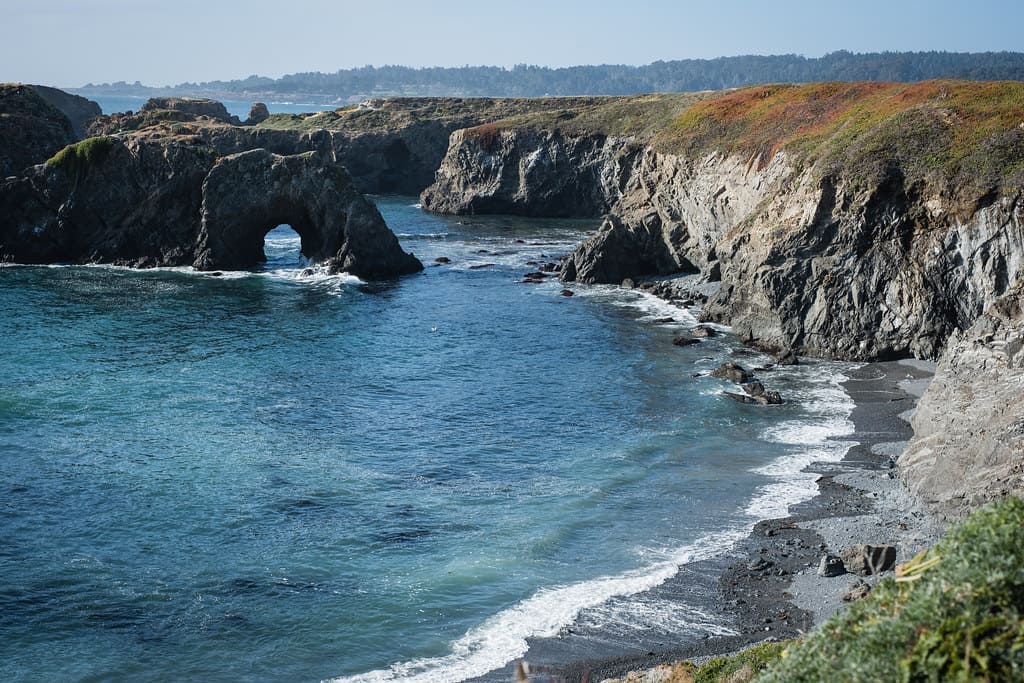
Why this park one of the best California State Parks: It protects the wild and dramatic Mendocino coast.
Best Time to Visit: Spring for wildflowers, fall for the best weather, and winter for gray whales.
Are Dogs Allowed? Yes
Where to Stay: You can camp at nearby Van Damme State Park or Russian Gulch State Park. There are several small inns and rentals in town. Headlands Inn Bed & Breakfast is a New England-style Victorian that serves up superb breakfasts and offers oceanview rooms.
Mendocino Headlands State Park wraps around three sides of the town of Mendocino on the remote, Northern California coast. The park has trails that follow the bluffs, giving visitors access to breathtaking views, that are especially breathaking during the golden hour near sunset when the cliffs of the headlands glow.
The 4.2-mile Mendocino Bluff Trail is an easy walk along the edge of the bluffs. You can take a spur trail down to Portuguese Beach which is riddled with ocean-tumbled logs.
Walk the entire trail along the bluffs or walk one way along the bluffs and then cut through town on the way back. There are brunch spots and a pub waiting for you.
Calaveras Big Trees State Park

Why this park one of the best California State Parks: It protects two groves of remarkable giant sequoia trees.
Best Time to Visit: Summer is the most popular but a spring and fall visit are equally enjoyable.
Are Dogs Allowed? Only in campgrounds an on fire roads.
Where to Stay: There is tent, RV, and even cabin camping inside this park. Make reservations early to secure your spot, especially in the summer and use those bear lockers! There are also several great VRBO cabins in the mountains surrounding the park.
As the name implies, Calaveras Big Trees State Park is home to some the largest giant sequoias in the world. The park is in Gold Country, east of Stockton up Highway 4, three miles from the little town of Arnold.
There are two groves of sequoias within the park- the aptly name North and South Groves- and the ancient trees here can grow over 300 feet high and 30 feet in diameter.
If you haven’t stood next to a sequoia, it is hard to believe just how gargantuan these trees are. Walk the 1.5-mile North Grove Trail to feel like an ant among giants. A five-mile hike will take you through the South Grove of giant sequoias left in their natural setting.
During the winter, snow is common as the park is close to 5,000 feet in elevation. This will close portions of the park, but open some areas to cross country skiing. In the summer, the weather warms up into the 80s and the Stanislaus River and Beaver Creek become popular places to cool off.
Portola Redwoods State Park
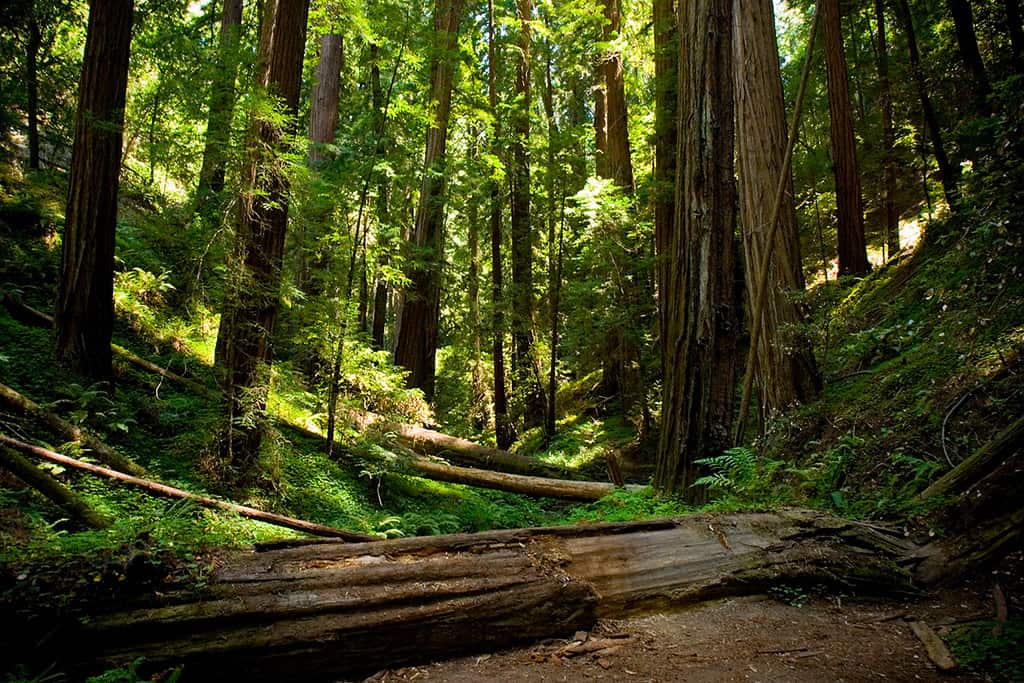
Why this park one of the best California State Parks: It protects a lush redwood forest 30 miles outside of San Jose.
Best Time to Visit: Anytime outside of the winter rainy season when winter storms can fall trees and cause temporary closures.
Are Dogs Allowed? Not on trails. Only on campsites and paved roads.
Where to Stay: There are 50 campsites within the park. A cozy VRBO cottage in the Santa Cruz Mountains is a great options as well.
In 2020 Big Basin Redwoods State Park, California’s oldest state park, was largely destroyed by the CZU Lightning Complex fire. It is one of our treasured state parks but the damage sustained will take generations to recover. Thankfully Portola Redwoods State Park is nearby and undamaged.
This park is located in the Santa Cruz mountains and protects one of the southern stands of redwood trees that is easily accessible to the Silicon Valley. It sits on 2,800 acres of lush forest with 18 miles of trails that follow creeks and wind through the trees.
An easy option at just 1.6 miles is the Iverson Trail to Tiptoe Falls. Keep your eyes open for banana slugs on the shaded, 4.6-mile Slate Creek Trail.
Point Lobos State Reserve

Why this park one of the best California State Parks: This park is home to tremendous coastal scenery and wildlife.
Best Time to Visit: Visit in spring to see baby animals or early fall to enjoy the most pleasant weather.
Are Dogs Allowed? No
Where to Stay: The park is located just south of Carmel-by-the-Sea, a charming village known for its upscale and dog-friendly atmosphere. We love the Hyatt Carmel Highlands which is located on a cliff facing the Pacific Ocean.
Deemed “the greatest meeting of land and water in the world” by Australian landscape artist Francis McComas, Point Lobos State Marine Reserve is a meeting of turquoise waters, craggy cliffs, and sculptural cypress trees.
Considered by many to be the “crown jewel” of California’s State Park system, Point Lobos is a wonderful place for hiking, wildlife viewing, and enjoying the splendid scenery of the Central California coastline.
During the spring months, you can often spot baby sea otters in the kelp beds offshore. Bluefin Cove and Whalers Cove are prime spots for viewing baby seals laying on the tiny beaches below. You can view both of these coves from above on the North Shore Trail which leads hikers through the forest to ocean cliffs with panoramic views.
Here are the best places to see wild sea otters in California.
A hike south to China Cove is a a fun option for beachfront rock scrambling and admiration of the brilliantly aquamarine waters. Scuba diving is a popular activity in the rich marine waters offshore but proof of certification and reservations are required.
Humbolt Redwoods State Park
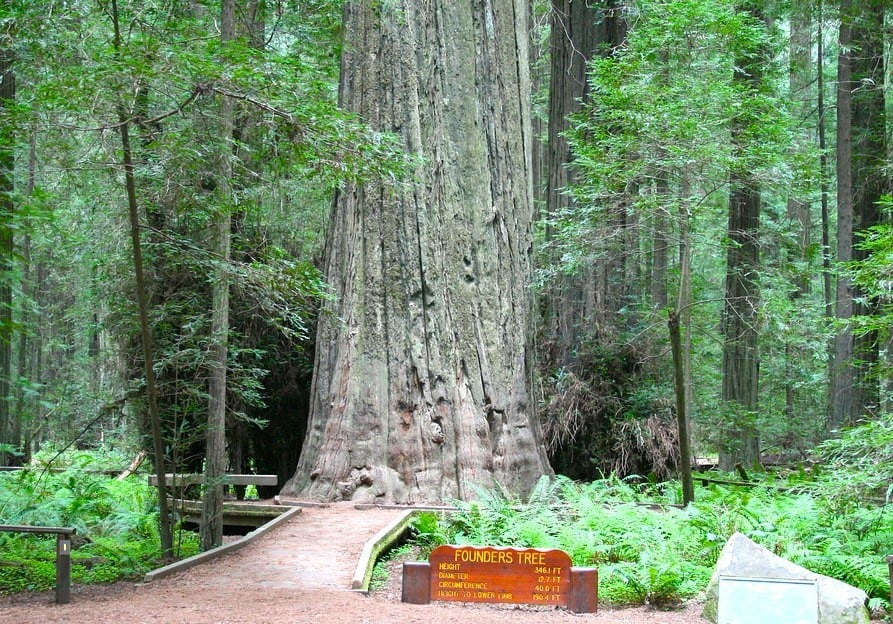
Why this park one of the best California State Parks: It is home to one of the largest stands of redwoods in the world and the impressive Avenue of the Giants.
Best Time to Visit: Spring through fall. Winter can bring temporary closures due to winter storm damage.
Are Dogs Allowed? Yes, but dogs aren’t allowed on trails.
Where to Stay: You can camp at one the 250 family campsites across three different campgrounds or stay in the city of Eureka which is 30 miles north. The Inn at 2nd & C is located in the historic district of town.
Humbolt Redwoods State Park is massive. It is 53,000 acres in size, making it the third largest California State Park, and protects 17,00 of old-growth redwoods. This park is home to some of the densest and most impressive redwood stands in the state.
One standout of this park is the Avenue of the Giants, a 32-mile scenic route with eight different stops to enjoy. There are over 100 miles of trails in the park. Highlights include the 1.3-mile Founders Trail which is home to the impressive Dyerville Giant is a 362-foot redwood that fell in 1991.
The Bull Creek Trail follows the namesake creek through old-growth redwood forest. Another nice hike is the north section of the River Trail which follows the South Fork Eel River 3.6 miles on a one-way route with a shuttle. Note: This trail is only accessible in the summer, when the bridges are installed.
Samuel P Taylor State Park
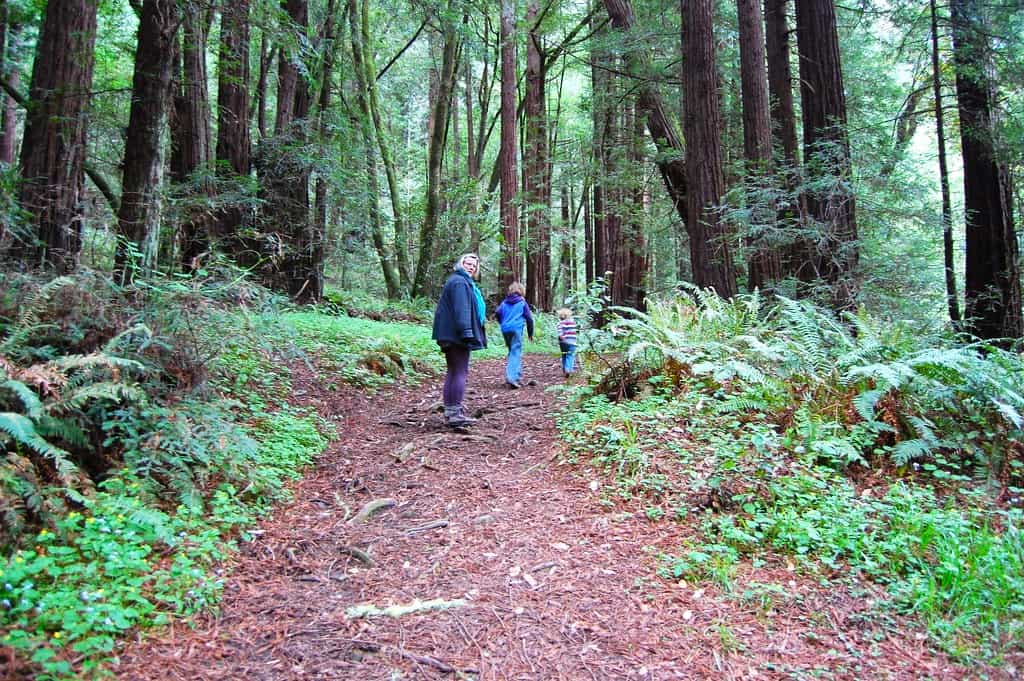
Why this park one of the best California State Parks: Easy access to nature and redwoods just 30 minutes north of San Francisco.
Best Time to Visit: I love visiting this park in the fall when the leaves are changing and falling onto the trails.
Are Dogs Allowed? Dogs are allowed in the picnic day-use area, campground, and on the Cross Marin Trail only.
Where to Stay: Samuel P Taylor Campground is very popular with families so book early. The Embassy Suites San Rafael is a nice option nearby with a great breakfast and complimentary evening cocktail reception.
Cross the Golden Gate Bridge into Marin County and head for the forests of Samuel P. Taylor State Park. This North Bay gem sits just outside of San Rafael and whisks you away from the hustle of Bay Area life.
There are hiking and bike trails which meander through redwoods and mixed forest. Wildlife such as deer, raccoons and foxes call this lovely park home. A spring visit is greeted with rolling green hills and wildflowers. During the fall, the deciduous foliage turns brilliant yellow which contrasts against the conifer greens.
The South Creek Trail follows Lagunitas Creek for 1.5 miles and in the rainy season, you should keep your eyes out for spawning salmon. In the summer months you will want to splash about in the shallow portions of the creek.
The Barnabe Peak loop trail is a beautiful hike. The views from the top of this six-mile trek are among the best in all of Marin County on a clear day. The Cross Marin Bike Path cuts into the park for three miles. It is a good place to bike, run, bringing your jogging strollers, and the only trail that welcomes Fido inside the park.
Good to know: Given this park’s proximity to a large urban area, it is quite popular. Expect parking lots to fill up by mid-morning on weekends.
Columbia State Historic Park
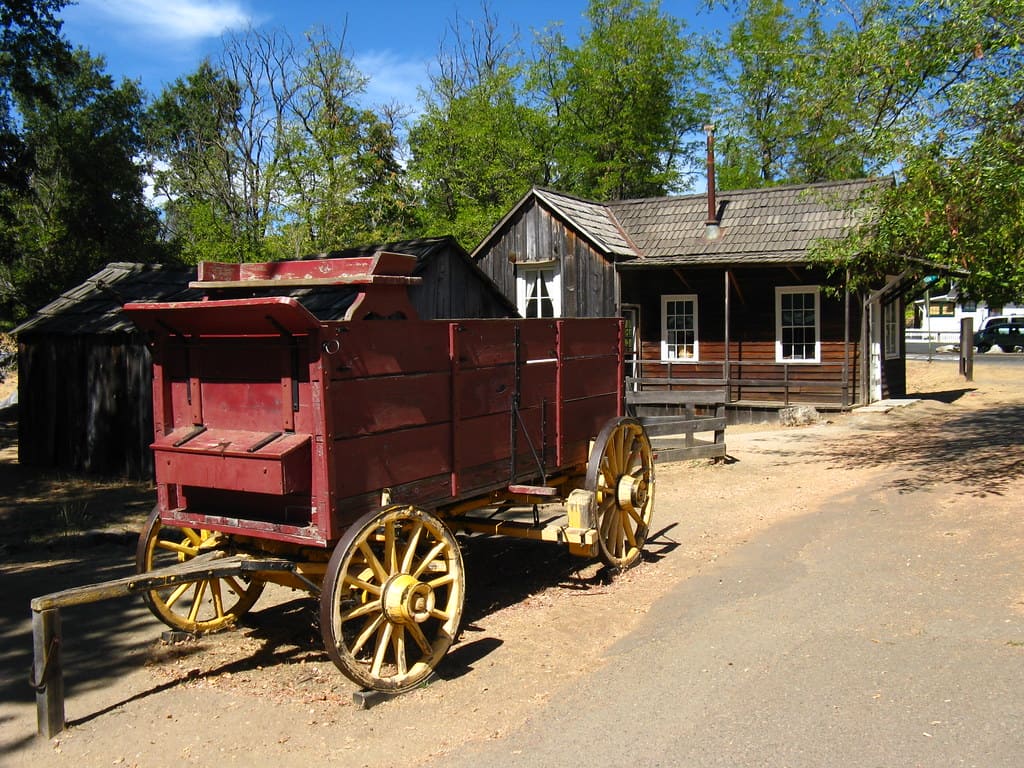
Why this park one of the best California State Parks: It is the best example of a California Gold Rush town.
Best Time to Visit: During the summer when there are daily town tours and more events occuring in town.
Are Dogs Allowed? Yes, but dogs are not allowed in the historic buildings.
Where to Stay: The Columbia City Hotel and the Fallon Hotel, are 19th-century country inns with Victorian touches that are located within the park.
45 minutes from Modesto, Columbia is a true Gold Rush town. It was founded in 1850 and quickly grew to be a boom town and became the second largest city in the state!
Much of the town has been preserved, and there are businesses where you can make candles, dress up for old fashioned photographs, grab an ice cream cone, and check out wooden toys. The most popular shop is the candy store where you find all sorts of sweet treats like homemade jelly candies and other old-fashioned treats.
There are also seasonal stage coach rides (complete with attempted stage coach robberies!) and a spot where you can pan for gold. Visit the school, cemetery, and jail.
Daily town tours take place June 15th through Labor Day but you should plan your visit during Gold Rush Days when special exhibits are open and docents dressed in period attire guide visitors through hands-on activities. Gold Rush Days are 1 – 4pm on the second Saturday of the month.
Gray Whale Cove State Beach
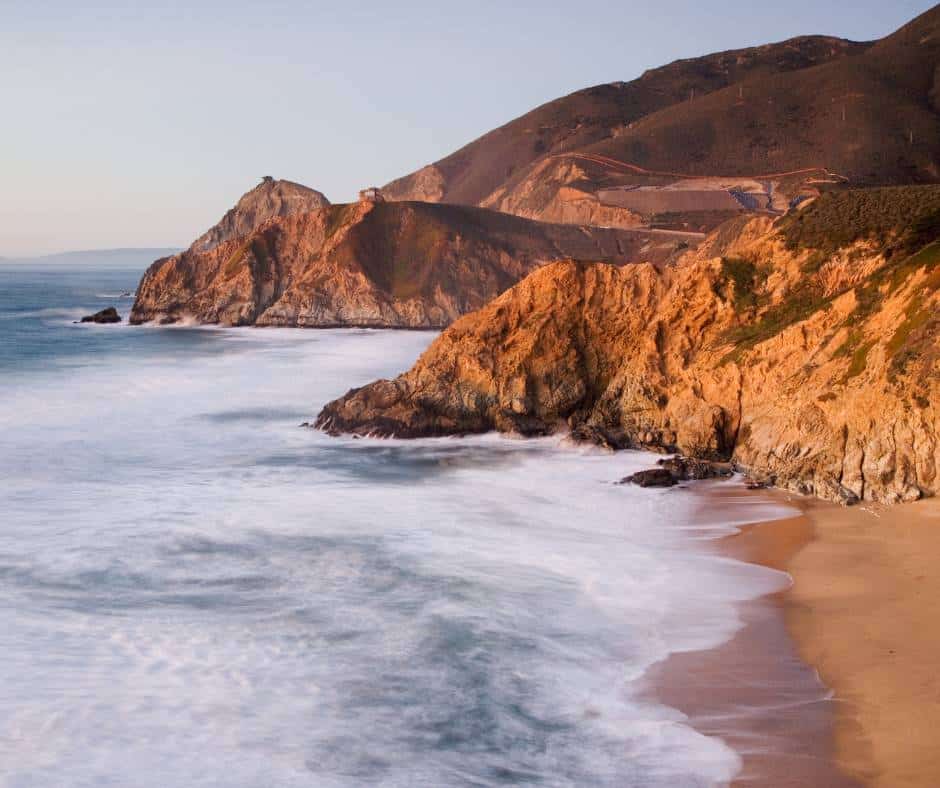
Why this park one of the best California State Parks: The views of the rugged San Mateo coastline are stunning.
Best Time to Visit: September and October are typically fog free and bring the warmest weather. This time of year is known as “San Francisco summer”.
Are Dogs Allowed? Dogs are allowed on the trails east of Highway 1 only. They are not allowed on the beach. They are, however, allowed on neighboring Montara State Beach.
Where to Stay: Splurge on the Ritz Carlton Half Moon Bay which is perched on an oceanfront cliff and home to two championsip golf courses, a world-class spa , and a wine bar with 5,000 bottle of vino on site.
Gray Whale Cove is known to many as Devil’s Slide, an area notorious for landslides and road closures. As a matter of fact, the area had so many landslides that in 2013, Highway 1 was rerouted away from the cliffs and replaced with the Tom Lantos Tunnels.
The good news is the former Highway 1 route has been replaced the paved, 1.3-mile Devil’s Slide Trail which is open to pedestrians and bicyclists. The views of the rugged coastline from this location are outstanding.
Gray Whale Cove isn’t just a clever name. During gray whale migration season (December through March), whales are commonly seen just offshore. Accessing this beach does involve walking down a steep trail, but the scenic rewards are worth your efforts.
The parking lot shares access with neighboring McNee Ranch and Montara State Beach as well. Two-mile San Pedro Mountain Trail connects Montara SB with Gray Whale Cove SB.
Important note: Gray Whale Cove is one of the few California State Parks that does not accept the Annual Day Use Pass.
Bodie State Historic Park
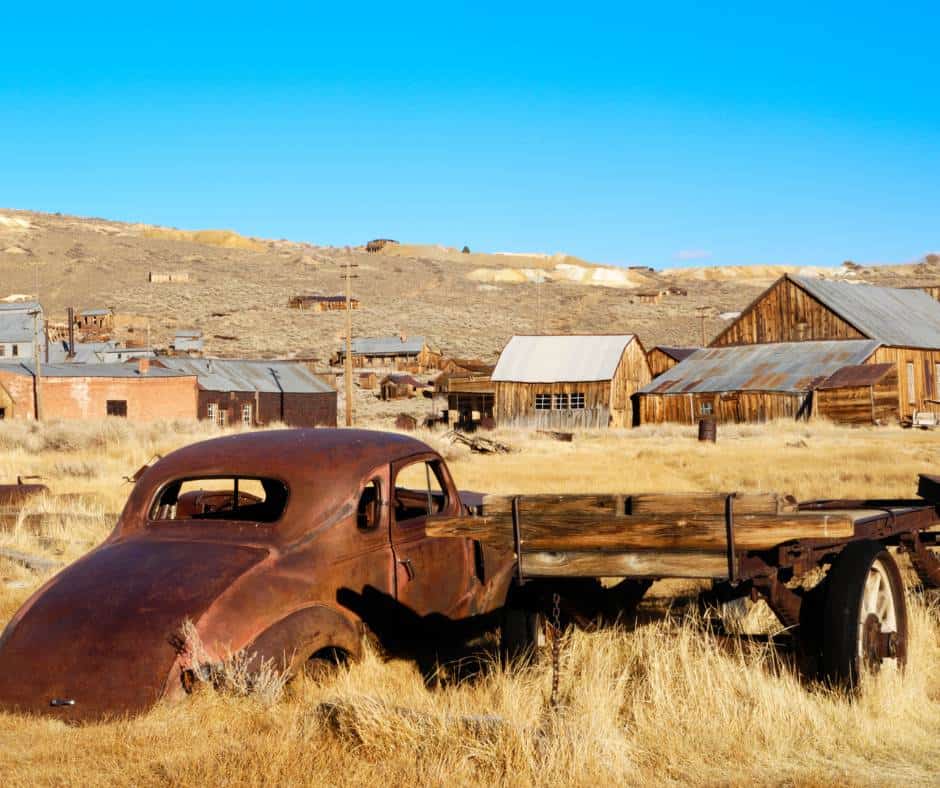
Why this park one of the best California State Parks: It is an example of a Gold Rush Ghost town.
Best Time to Visit: Summer brings the nicest weather though you can visit all year long. You must use skis or snowmobiles to access the park in winter.
Are Dogs Allowed? Dogs allowed in park but are not allowed in any of the historic buildings.
Where to Stay: The Virginia Creek Settlement in Bridgeport has everything from cottages with kitchenettes to tens for rent.
Bodie State Historic Park is located in Northern California east of the Sierra Nevada range near the Nevada border. It is 13 miles from Highway 395, and the last three miles of the trek to this ghost town are on a dirt road. Since the park is 8,375 feet in elevation, snow is common in the cold season.
Bodie was a mining town founded by four prospectors, one being W.S. Bodey, who found gold in the surrounding mountains. At its peak, Bodie had 10,000 residents for 60 saloons and dance halls lining its streets. This was truly the Wild West!
The mines were depleted by 1886 and the population declined to 1,500 people. Six years later, a major fire destroyed portions of the town. By the 1940s it was officially a ghost town. Today the remains of the town are left in “arrested decay”, looking like they did when the last residents left town.
Take a docent-led walk of the town to get the most out of your visit. Tour several of the town’s building such as the church, homes, and stores with all their items left behind, as well as the Stamp Mill where mountain ore was pulverized and gold was separated out.
Julia Pfeiffer Burns State Park
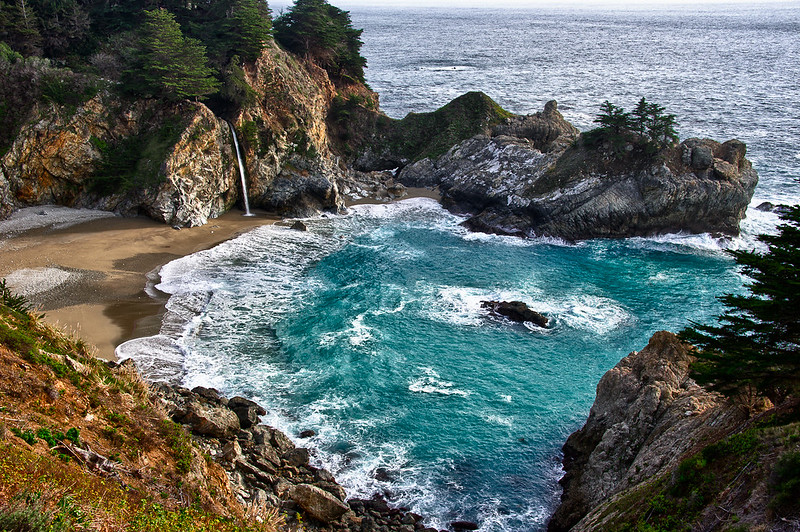
Why this park one of the best California State Parks: It is home to McWay Falls, one of the most beautiful waterfalls in the country.
Best Time to Visit: Winter is likely to bring the worst weather and road closures along Highway 1 are more likely. Spring through fall are better bets. Afternoons are better than mornings because the fog is more likely to have burned off.
Are Dogs Allowed? No
Where to Stay: The Ventana Campground offers traditional camping. Fernwood Resort offers tent camping, glamping tents, and forest cabins. Post Ranch Inn is a splurge-worthy luxury resort in Big Sur.
Julia Pfeiffer Burns State Park is named for an early pioneer of the Big Sur coast. It is most well known for McWay Falls, an 80-foot waterfall cascading onto a deserted beach.
The falls are visible from Highway 1, but it is safer to park inside the state park and take the short, 1/2-mile trail to the falls overlook.
You will also want to check out the Partington Creek Trail which heads through a canyon and 100-foot tunnel to Partington Cove Beach, a good spot to look sea otters in the kelp beds just offshore.
Hearst San Simeon State Historic Park

Why this park one of the best California State Parks: It preserves the extravagent and historic castle that belonged to publishing tycoon William Randolf Heart.
Best Time to Visit: Hearst Castle is a great destination any time of year.
Are Dogs Allowed? Only in the parking lot at the bottom of the hill.
Where to Stay: There are several lovely beach homes to rent on VRBO in the nearby resort town of Cambria. Camping can be found at Hearst San Simeon State Park on the beach nearby.
Hearst Castle is located high atop a hill in San Simeon, along the Central Coast. The extravagant castle belonged to famed publishing tycoon William Randolf Hearst and played host to countless celebrities during the 1920s and 30s.
The main house is 68,500 square feet with 38 bedrooms, 30 fireplaces, and 42 bathrooms. It is filled with art from all over the world, has a private theater, billiard room, library, and three guest houses. There are over 70,000 trees planted on the grounds.
The Neptune Pool, filled with beautiful intricate tiles, took over 15 years to build. Why? Because it took three different attempts before Hearst was finally satisfied with the design!
Cars park at the bottom of the hill on Hearst Ranch property and then board a bus to take the winding road up the hill that Hearst Castle sits upon. Visitors can remain on the hilltop to enjoy the gardens, pools, and views until closing time, or they are ready to come down.
Tour tickets can be reserved online up to 60 days in advance. There are several different tours available, allowing you to see different portions of the sprawling mansion. The Grand Rooms Tour is the tour recommended for first timers. It is 70 minutes long and an guides are great about telling the stories of famous visitors to the castle, as well as about the historic artwork and furniture.
CTL Tip: Keep your eyes out for zebras on the hillsides near Hearst Castle. They are descendants of those who were once part of Hearst’s private zoo.
Fort Tejon State Historic Park
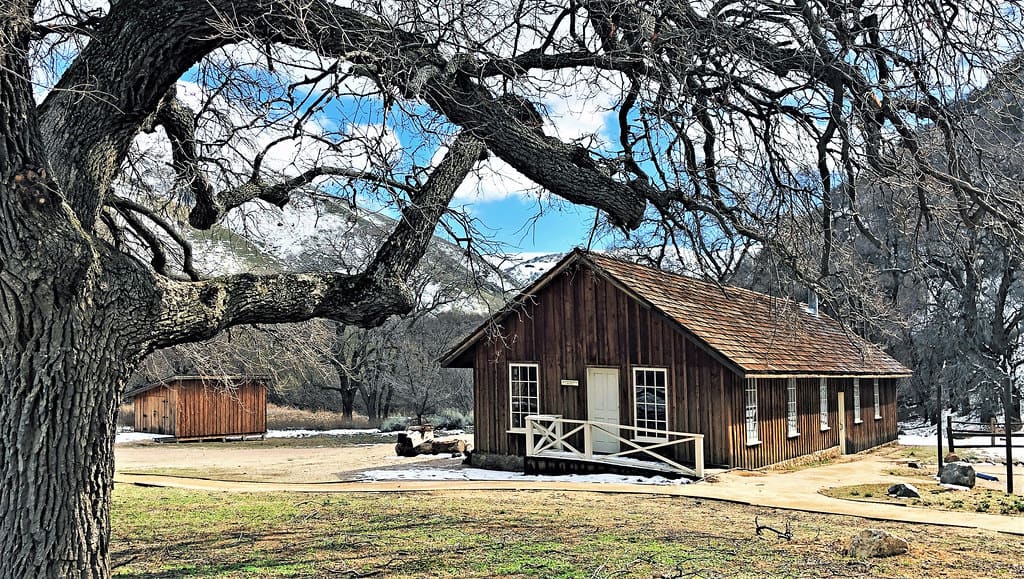
Why this park one of the best California State Parks: It preserves a part of California’s military and Native American history.
Best Time to Visit: Any time of year as long as winter weather hasn’t closed the road.
Are Dogs Allowed? Yes
Where to Stay: Most people visit Fort Tejon on their way to other destinations. There are, however, some small motels in Lebec and Gorman nearby.
Anyone who has driven up and down Interstate 5 from the Central Valley to Southern California is surely familiar with “the Grapevine”, a portion of the interstate that winds through the mountains and Tejon Pass. But did you know that there is a state park up there that is certainly worth your time?
Fort Tejon was established to protect and control Sebastian Indian Reservation and white settlers from raids by other Indian groups nearby. It was only occupied by the US Army for 10 years, from 1854 – 1864.
Today you can walk the 1/2-mile loop to check out the old adobe buildings and admire the 400-year-old Valley Oaks. During the loop you can visit the Captain’s quarters, barracks, and jail. A museum onsite houses exhibits on army life and local history.
Visit on a Saturday to catch the living history program or the 3rd Sunday of the month May to September for Civil War Re-enactments. During these programs you can talk with soldiers, visit craftsmen like the blacksmith and carpenter. There are also volunteers dressed cooks, servants, laborers and officers.
Leo Carillo State Park
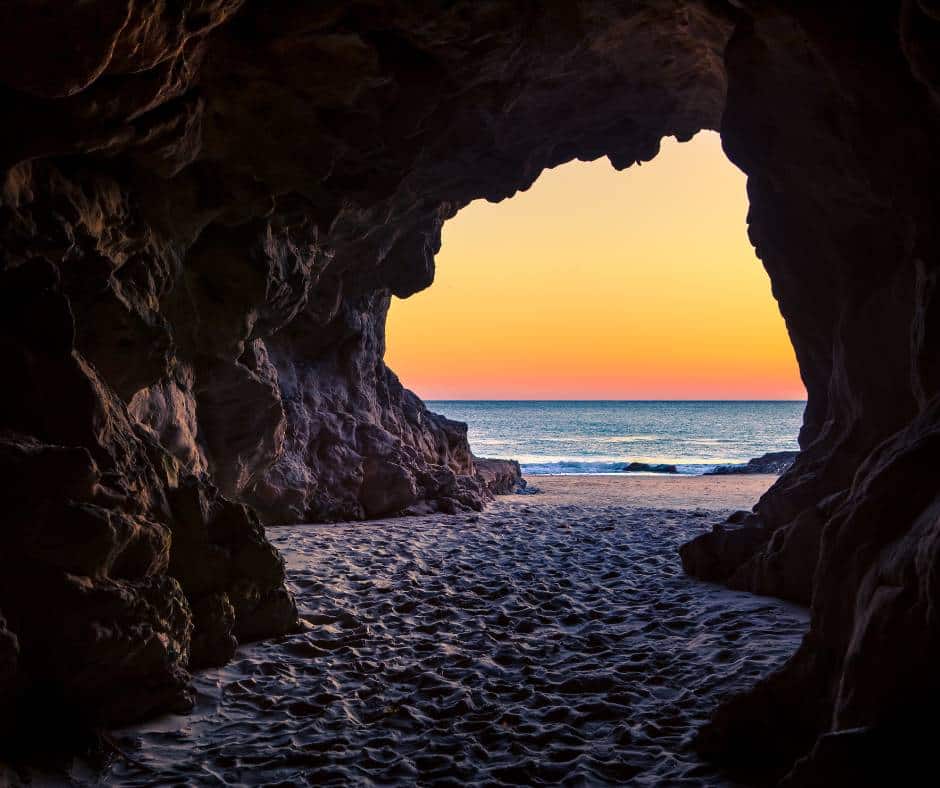
Why this park one of the best California State Parks: It offers a slice of Malibu to the masses.
Best Time to Visit: Enjoy a perfect beach day in the summer or early fall.
Are Dogs Allowed? Dogs are allowed only in day-use areas, North Beach, and the campgrounds.
Where to Stay: Camp at Leo Carrillo in one the Canyon Campground’s 135 sites. As you can imagine, reservations are necessary. Ready to feel like a star? Book a beachfront cottage in Malibu on VRBO.
Beaches, caves, tide pools, and hiking through the hills await visitors to Leo Carillo State Park. The park is located in Malibu, the scenic home of the rich and famous.
This stretch of coastline if the stuff dreams are made of, and tide pools are some of the best around. Plan for a low tide visit and you will spot sea anemones, sea stars, sea urchins, mussels, barnacles, and crabs. You can also surf, kayak, and windsurf in the waters offshore.
There is also a cool sea cave to explore. It is located at rocky point that separates North Beach from South Beach. It should be visited at low tide, and you should always be mindful of the tide as it begins to come in.
The cave at Leo Carillo is one of 25 caves in California you will want to visit.
Inland there are trails which lead you into the hills to locations with impressive views. The Yellow Hill Fire Trail leads to a viewpoint where you can see three islands that help make up Channel Islands National Park as well as up and down the coastline.
Crystal Cove State Park
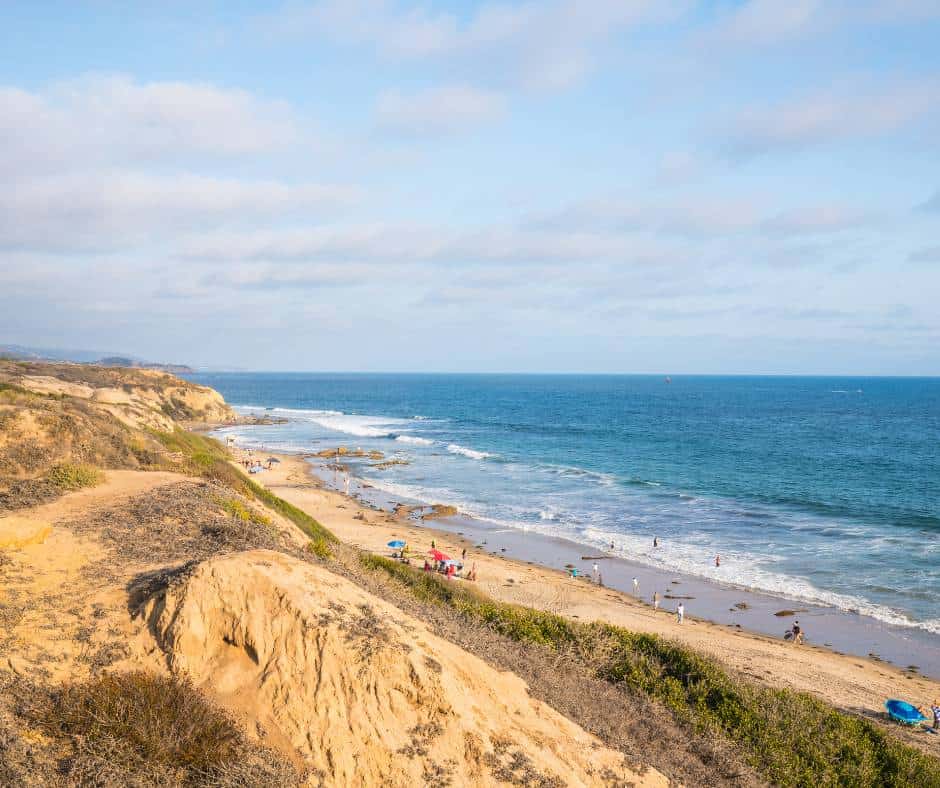
Why this park one of the best California State Parks: This park gives you a glimpse of what Southern California beaches were like long ago.
Best Time to Visit: This is a perfect destination year round.
Are Dogs Allowed? No
Where to Stay: Camp at the RV campground or stay in one of the cottages onsite. Both will require reservations well in advance. The Resort at Pelican Hill is a five star resort just a stone’s throw away as well.
One of my favorite beaches in all of California happens to be close to home. Crystal Cove State Park is a throwback to the Orange County of yesteryear. Large cliffs block the views of the masses of luxury homes on the hills up above, allowing you to enjoy the beach without the masses.
The beach can be busy right next to the historic district and The Beachcomber restaurant, but if you walk a couple hundred yards away you can find a peaceful spot all to yourself. This beach usually has small waves, making it great for families, and the tide pools along the shore are fun to explore. Dolphins are frequently spotted splashing about in the water.
This park also has several great hiking trails which head back into the hills and canyons on the other side of Pacific Coast Highway. The No Dogs/Moro Canyon loop (~ 3 miles) is one of my favorites. It begins with a climb up the rolling hills with ocean views and ends with an easy stroll through beautiful Moro Canyon. From there, you can celebrate with some beach time.
Crystal Cove is home to a historic district which is filled with restored bungalows that were built to house crew during movie filming from the 1920s-1940s. These cottages are reasonably priced and right on the beach, so that means they are also very popular. Cottage reservations are released daily, six months in advance. Be on the website at 8am if you want to snag one.
Torrey Pines State Beach and Reserve

Why this park one of the best California State Parks: It prefers the Torrey pines, the rarest pine trees in the world.
Best Time to Visit: This is a great destination year round.
Are Dogs Allowed? No
Where to Stay: The Lodge at Torrey Pines is a luxury resort that sits on the famed Torrey Pines Golf Course. San Elijo State Beach in Encinitas is the closest park with camping.
Torrey Pine State Reserve is located on the bluffs of northern San Diego and protects the rarest pine trees in North America. These trees only grow in and around the reserve and on Santa Rosa Island , one of the Channel Islands off the coast of California. The contrast between the forest on the bluffs and the sandy below is lovely.
The Guy Fleming Trail is the perfect introduction to what Torrey Pines has to offer. Its a one-mile, loop trail that takes allows you to walk amongst the pines and enjoy amazing views of the great blue yonder from bluffside viewpoints.
Its a place where you can watch birds having a blast surfing the updrafts while parasailers make their best attempts at being birds themselves.
After enjoying the trees head down the hill and spend time at Torrey Pines State Beach. The beach is a great place to enjoy a picnic and splash in the water.
Emerald Bay State Park
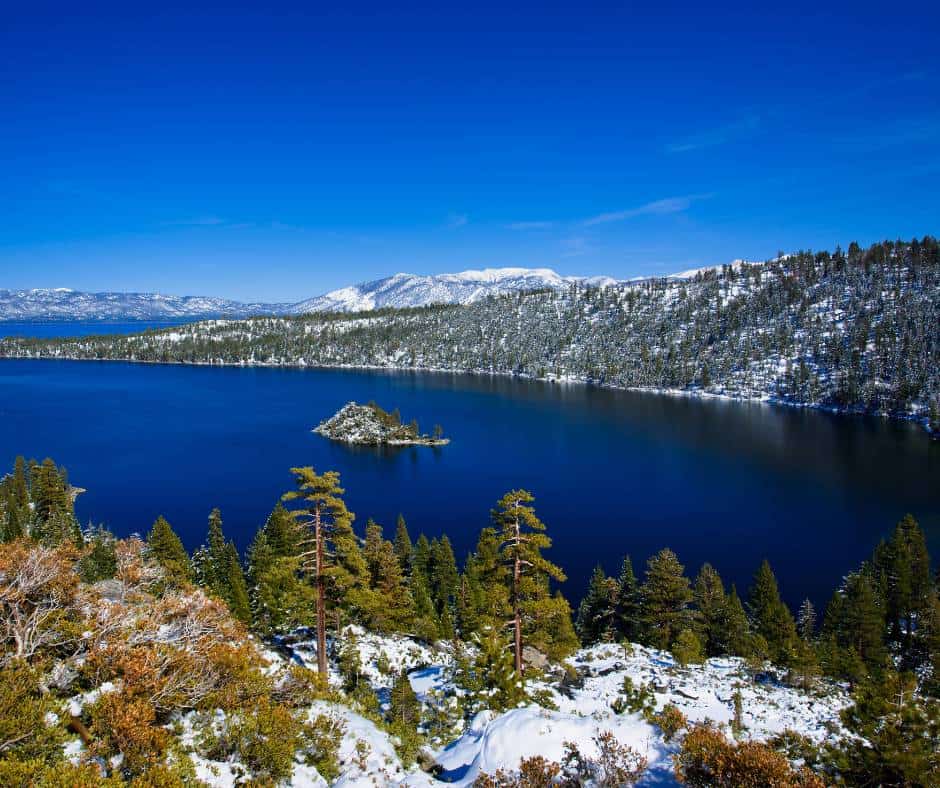
Why this park one of the best California State Parks:
Best Time to Visit: In the summer if you want to hike and spend time out on the water and in the winter if you want to enjoy the snowy landscape around the lake and world-class skiing nearby.
Are Dogs Allowed? No
Where to Stay: Eagle Point Campground is located just above Emerald Bay within the state park. It is open during the summer and early fall. Reservations can be made six months in advance. Camp Richardson is a great place to stay on Lake Tahoe as well with a variety of camping and lodging options.
Emerald Bay State Park is located at Lake Tahoe, one of the most beautiful lakes on the planet. The Rubicon Trail is a moderate trail that allows you to hike between Emerald Bay and DL Bliss State Park, enjoying the tremendous lake views along the way.
The trail also leads visitors to Vikingsholm, a 38-room mansion built in 1928 by Mrs. Lora Josephine Knigh. It’s considered to be one the finest examples of Scandinavian architecture in the western hemisphere.
Out in the water of Emerald Bay is Fanette Island which has a stone tea house that was used by Mrs. Josephine and her guests. Boat tours can give you a different perscpective of Emerald Bay than hiking. I suggest you do both.
Lake Tahoe is one of our favorite California mountain towns. See what other special places made the list.
McArthur-Burney Falls Memorial State Park
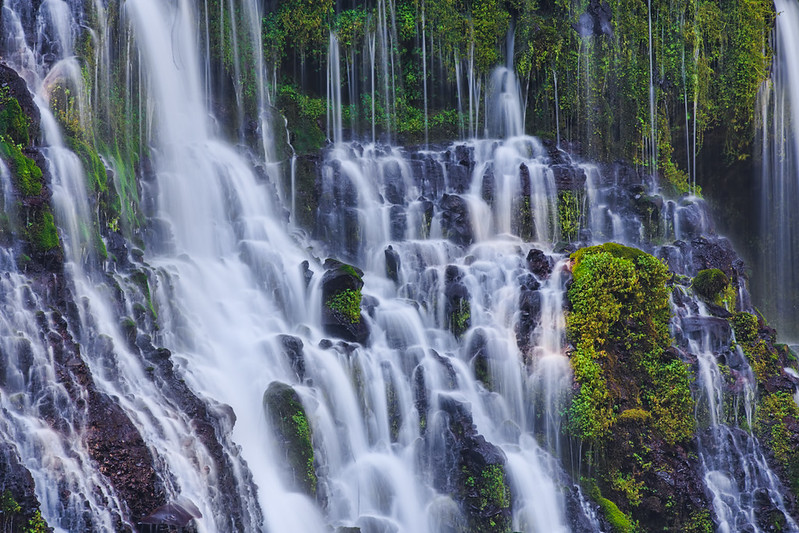
Why this park one of the best California State Parks: It protects Burney Falls, one of the most scenic falls in the country.
Best Time to Visit: Summer is the best time to enjoy the falls and Lake Britton nearby. Just arrive early to secure parking.
Are Dogs Allowed? Only in the parking lot and campground. Not on the trails or near the falls.
Where to Stay: There are campsites as well as rental cabins located within the park.
Burney Falls is not the tallest waterfall in California (that honor goes to Yosemite Falls) but it is definintely one of the most beautiful. It is located southeastern Cascade Mountain range in McArthur-Burney Falls Memorial State Park about 65 miles east of Redding.
The 129-foot waterfall is fed by underground springs, resulting in a weeping wall of water. It is a site so scenic that President Theodore Roosevelt once called it the “eighth wonder of the world”.
The Burney Falls Loop Trail is a great way to see the falls at different angles and also enjoy some of the surrounding forest. FIshing is popular in Burney Creek, especially during the October trout season and boating is a fun activity on Lake Britton. Boat and kayak rentals are available at the store and marina.
Love waterfalls? Here are 21 Northern California waterfalls to add to your bucket list.
Castle Crags State Park
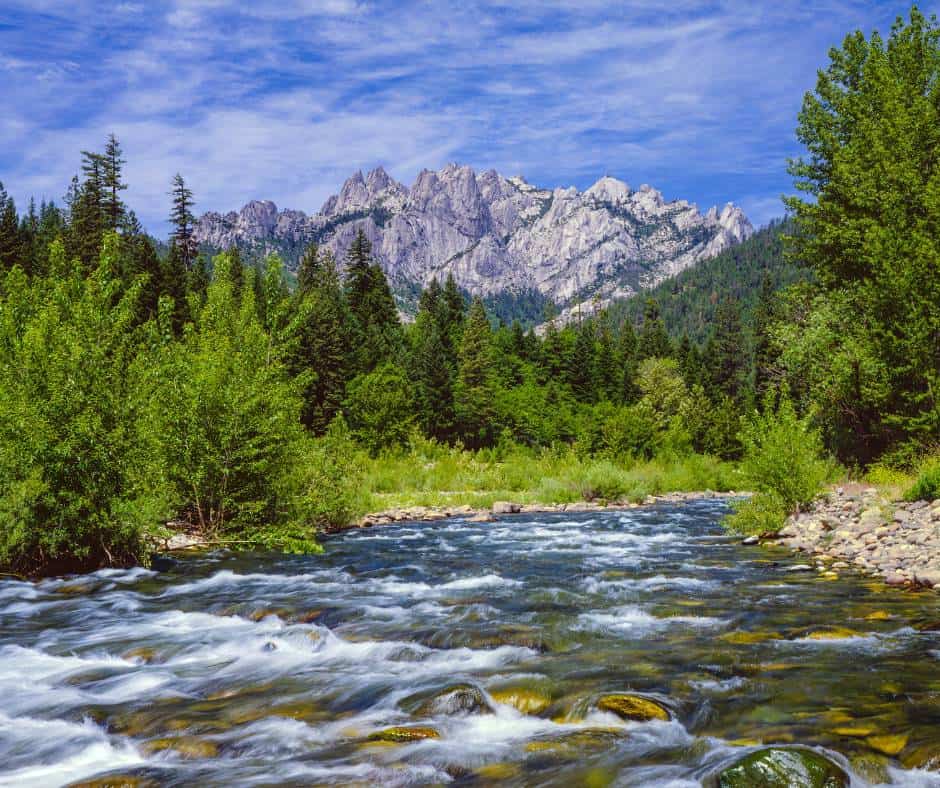
Why this park one of the best California State Parks: It protects the wilderness around the impressive Castle Crags State Park.
Best Time to Visit: Late spring through fall. Snow can limit activities in the winter.
Are Dogs Allowed? Only in the parking lot and campground. Not on trails.
Where to Stay: Camping is available inside the park. It is first come, first served October through April but reservations are required in the summer. If you are looking something unique, stay at the Railroad Park Resort. There are over a couple dozen cabooses that have been converted into quaint lodging with private bathrooms, mini fridges, and microwaves.
If you have driven Interstate 5 as it passes by Mount Shasta you have surely noticed the towering granite pillars on the opposite side of the highway. Castle Crags State Park is the home of steep, rocky spires that are 170 million years old and soar 6,000 feet in elevation.
Drive the winding, one-lane road up to the Vista Point and taking in the fantastic views of Castle Crags and Mount Shasta. More than 30 miles of trails wind through the park, including a portion of the famed Pacific Crest Trail.
If you are looking for a true challenge, take the 5.5-mile round-trip journey up to Castle Dome via the Crags Trail. It gains 2,000 feet in elevation in a relatively short distance but the scenery and views are worth it. You can climb Castle Dome but it is not recommended unless you have climbing gear.
Swimming in the Sacramento River is a fun option during the summer months. The river is much smaller here than it is down in Sacramento.
Anza-Borrego Desert State Park
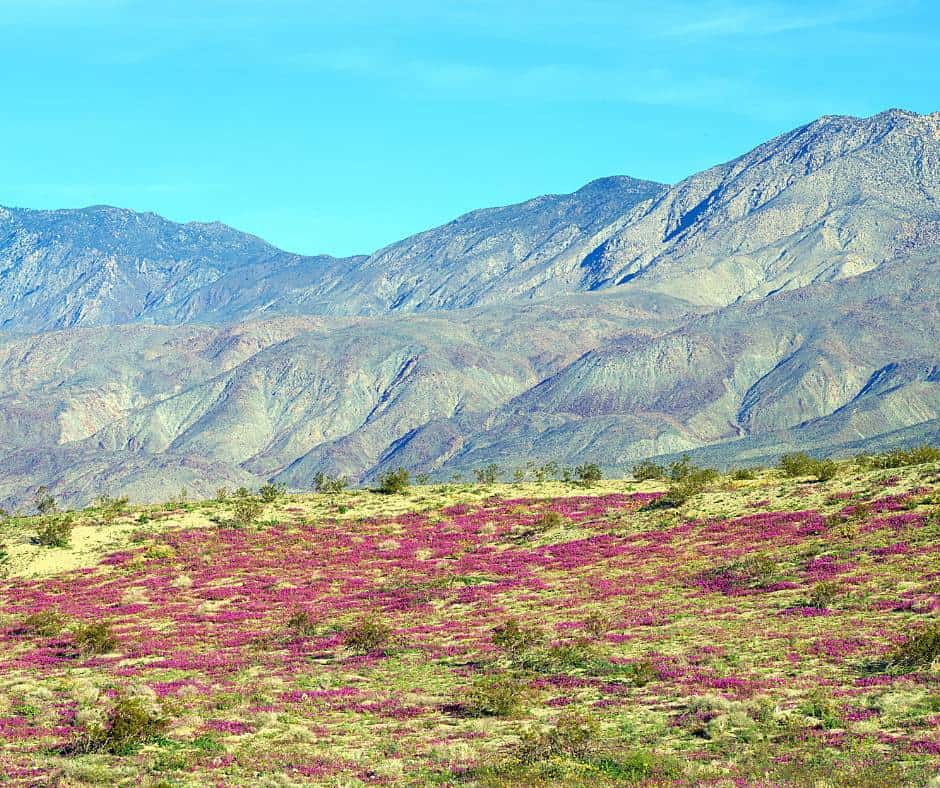
Why this park one of the best California State Parks: It is a great place to witness a desert wildflower bloom.
Best Time to Visit: Early spring during the wildflower bloom
Are Dogs Allowed? Dogs allowed in the campgrounds, on designated park roads, and the Visitor Center/Campground Trail. They are not allowed on other trails in the park.
Where to Stay: If you visit during the cool season, camping inside the park is a good option. Reservations are available October 1st through April 30th. There are several different resorts and inns in Borrego Springs, including the Borrego Springs Resort and Spa.
Anza-Borrego Desert State Park is the biggest state park in the United States, located in eastern San Diego County. With 600,000 acres of desert ranging in elevation from sea level to over 6,000 feet, this is a diverse landscape full of life.
Begin your visit at the visitor center which is built into a hillside. It is a great place to learn about the flora and fauna within the park, watch the park video, and get trail conditions and recommendations.
The biggest attraction at this park is the spring wildflower bloom. Some years are certainly more impressive than others, but during heavy rain years sections of the desert are dotted with all sorts of wildflowers.
Favorite hikes inside the park include the Borrego Palm Canyon Nature Trail, a three-mile round-trip hike which leads to a large palm oasis inside of a gorge. The Pygmy Trail is a quick, one-mile jaunt that to fifty short palm trees.
The Slot hike is accessed by driving a two-mile dirt road to the trailhead. It’s a short hike over the hill and then into the slot canyon. The further into the canyon you hike, the narrower it gets.
The budding geologist in your group will enjoy the Narrows Earth nature trail where you can learn about igneous, sedimentary, and metamorphic rock as well as earthquake faults in this geologically active portion of the state.
If you have a four-wheel drive vehicle, head out to Blair Valley to see Marshal South’s home where engaged in “primitive living” on his homestead at Ghost Mountain. The trail to the home is a steep mile but the views are amazing and exploring the homestead is fun. There are pictographs on a rock nearby as well.
Other park highlights include the Box Canyon Historical Monument, Coyote Canyon, the Culp Valley Overlook, the Elephant Tree Discovery Trail, the Mason Valley Cactus Garden, and the Vallecita Stagecoach Station.
Montaña de Oro State Park
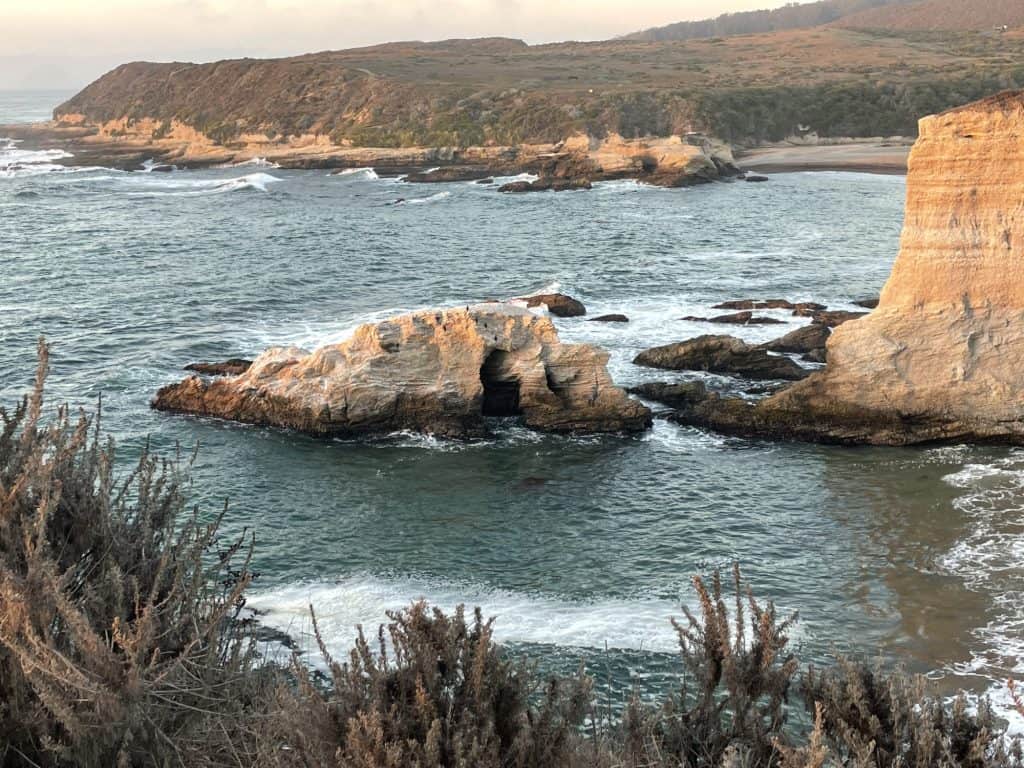
Why this park one of the best California State Parks: Incredible protected coastline and geotectonic evidence on display.
Best Time to Visit: Spring for wildflowers and summer and fall for warmer temps.
Are Dogs Allowed? Dogs allowed only in campgrounds, on roads, and Spooners Beach.
Where to Stay: Camp at Montaña de Oro State Park or stay in a nearby VRBO cottage with water views.
One of my favorite California State Parks that might be off the radar of those traveling up and down the central coast is Montaña de Oro State Park. This dramatic stretch of coastline is in Los Osos, a small town west of San Louis Obispo.
The park is named for its “mountains of gold”, referring to the coastal bluffs that are covered in wildflowers, like the California poppy, during the spring.
Montaña de Oro is a great place to witness the geologic ramifications of geotectonic action (aka: earthquakes), with tilted and exposed million-year-old rock formations and sea beds. You can see these exposed sea beds along the shore, many serving as tide pools filled with life.
Be sure to walk the Bluff Trail, an easy 3.4-mile out-and-back trail that hugs the coast. Admire the views and keep a look out for sea otters which float in the kelp beds just offshore. In the winter you may even see gray whales.
From the Bluff Trail take one of the spur paths that lead down to the water to explore the tide pools. Check the tide charts before you go and aim for a low tide visit.
Here is an awesome Central Coast Road Trip itinerary.
Mono Lake Tufa State Natural Reserve
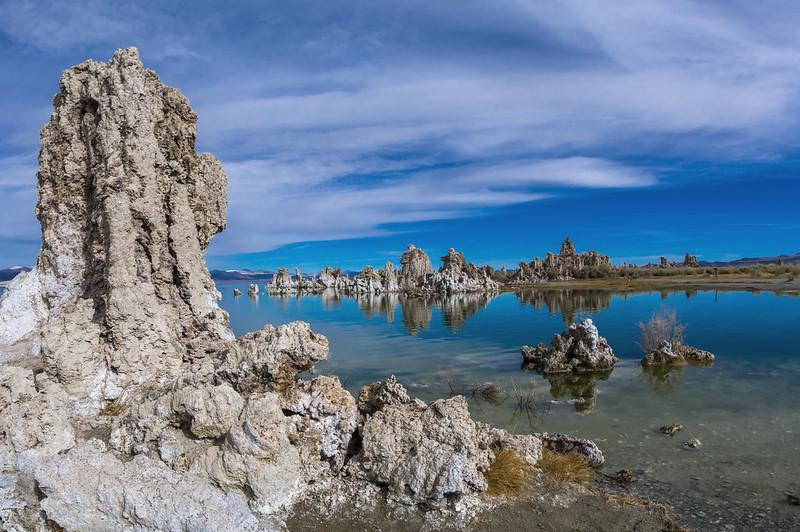
Why this park one of the best California State Parks: It protects an ancient lake that is known for its tufas.
Best Time to Visit: Summer if you want to swim or get out on the lake.
Are Dogs Allowed? Dogs are allowed in most areas of the State Reserve, except for the State Reserve Boardwalk. There is also a county park along a portion of the lake where dogs are not allowed.
Where to Stay: Camp in the Lee Vining area or up in the Tioga Pass of Yosemite National Park. You will find traditional lodging in Bridgeport.
Mono Lake is one of the most unusual places in California. It is an ancient lake (one million years old!) that is twice as salty as the ocean and it has these large, other-wordly tufa formations sprouting out of its waters. The lake is also an important nesting area for gulls and ospreys.
Tufas are calcium-carbonate pillars and knobs of varying heights and sizes that protrude from the lake’s surface. They’re formed by the interaction of freshwater springs and alkaline lake water.
The best way to experience the lake is to either take a free, guided tufa walk or a guided kayak tour. Both are led by naturalists which can answer all your questions about this unique spot, including those about the massive migratory bird population that calls the lake home seasonally.
You can swim in Mono Lake, but make sure to keep the water out of your eyes or any cuts because it is very salty. You will find yourself quite boyant in these waters. If you are looking to stretch your legs a bit, take the one-mile nature trail in the South Tufa Area which has great views of the tufas.
Mount San Jacinto State Park
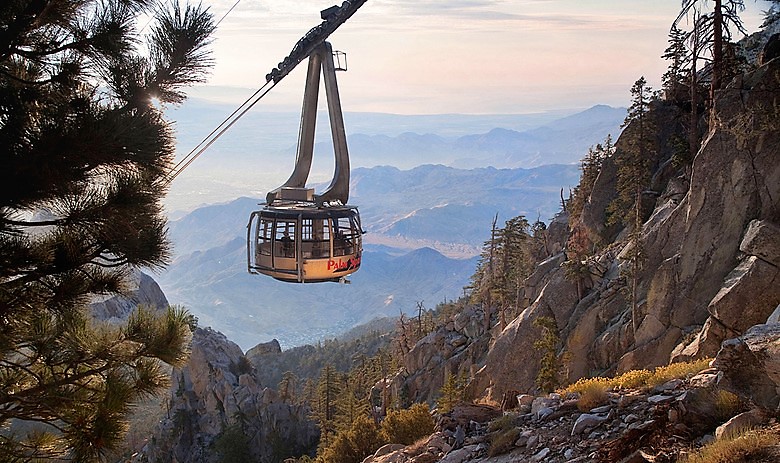
Why this park one of the best California State Parks: Going from 75 degrees in Palm Springs to snow atop San Jacinto in about 30 minutes is unforgettable.
Best Time to Visit: Winter for snow play, summer for hiking.
Are Dogs Allowed? Only in the Idyllwild and Stone Creek Campground. They aren’t allowed on the trails or the aerial tram.
Where to Stay: Camp or rent a VRBO if you are coming from Idyllwild. If you are taking the tram stay at one of the many luxury resorts in the Palm Springs area, like Omni Rancho Las Palmas.
You can visit Mount San Jacinto State Park two ways- via Highway 243 from the mountain town of Idyllwild or via the Palm Springs Aerial Tramway.
The Palm Springs Aerial Tramway is the world’s largest rotating tramcar. It begins at the base of Chino Canyon at 2,643 feet and carries passengers up the steep mountainside to the Mountain Station at 8,561 feet in just 10 minutes! The views from the top are incredible!
The weather at the Mountain Station is 30-40 degrees cooler than on the valley floor, making it a really fun and unique experience. Where else can you trade sun-kissed palm trees for snow-blanketed white firs in just 10 minutes?
During the winter and early spring months, snowshoes and cross country skis can be rented from the Adventure Center. You can also bring your own sleds, find a hill, and have at it.
In the summer, escape the desert heat and discover a wildly different environment complete with 50 miles of hiking trails including a stretch of the Pacific Crest Trail and the hike to the top of San Jacinto Peak which rises 10,834 feet above sea level.
Palm Springs is one of our favorite weekend getaways in Southern California. See what else made the list.
Huntington State Beach

Why this park one of the best California State Parks: It offers the classic Southern California beach experience.
Best Time to Visit: During the summer if you want to swim, and any other time of the year if you want most of the beach to yourself.
Are Dogs Allowed? Only on the bike path, not on the sand. Thankfully, the Huntington Dog Beach is just up the road.
Where to Stay: Camp at neighboring Bolsa Chica State Beach or stay in a beachfront hotel like the Hyatt Regency Huntington Beach Resort and Spa.
When visitors come from other states and countries and ask for the classic Southern California Beach experience, we head to Huntington State Beach. There you will find wide sprawls of sand filled with umbrellas, mats, and families. Tourists ride on the bicycles path that runs along the cost and food shacks serve up hamburgers and shakes.
During the summer there are typicallly street performers gathering money from eager audience members to perform some sort of feat of athleticism or entertainment.
Huntington Beach is known as Surf City USA, and hosts the US Open of Surfing every year at the end of July and beginning of August. Throughout the year you will see surfers in the water, especially by the pier, and there are a few different surf schools teaching newbies as well.
Popular activities include swimming, sunbathing, playing beach volleyball, renting bikes or surreys and pedaling the bike path, and fishing off the Huntington Beach Pier. Sitting around one of the 200 firepits at the beach is a fun evening activity, but you better get there early in the day to claim one because they are very popular.
Marshall Gold Discovery State Park

Why this park one of the best California State Parks: It preserves the site that launched the California Gold Rush.
Best Time to Visit: Fall and spring for the best weather. Summer if you want to add river rafting to your itinerary.
Are Dogs Allowed? Yes! Dogs are allowed on trails and in the river but not inside the buildings.
Where to Stay: Camp with OARS if you are going rafting or at the Coloma Resort which has cabins, tent sites, and RV sites.
One of the most important moments in California history was when James Marshall found some gold flecks in the tailrace of a sawmill he was building for himself and John Sutter. This discovery in the town of Coloma lead to the California Gold Rush which created a boom in the population and quick establishment of California as a state.
The original mill was destroyed by flooding but a replica now stands in it place along with over 20 historic buildings in the old mining town of Coloma. Take the Gold Discovery Tour (not offered when temps exceed 92 degrees) to learn about the fascinating history of this site and following it up with gold panning lessons.
There are several sites to visit including the blacksmith shop, schoolhouse, a miner’s cabin, nature center, jail ruins, the grange, and the beer garden.
Coloma is also the launching point for rafting trips down the South Fork of the American River. OARS offers half-day and one-day trips that are guided and include a tasty lunch. They even have two-day trips and a great campsite in Coloma that includes dinner and activities. I have done both the one day and two day trips and highly recommend them.
Mount Diablo State Park
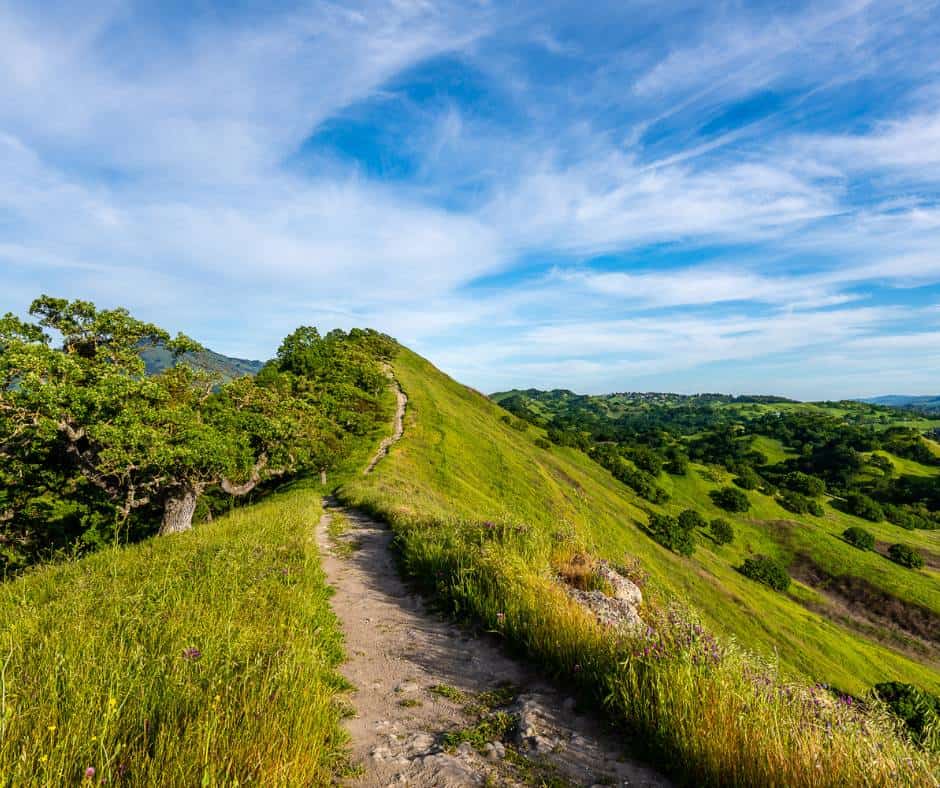
Why this park one of the best California State Parks: Mount Diablo is a great place for natural recreation in the busy Bay Area.
Best Time to Visit: Spring is a beautiful time of year to visit when the mountain is covered in green.
Are Dogs Allowed? Dogs are not allowed on trails, buildings, or fire roads. They are allowed at the campground.
Where to Stay: There are 50 campsites at Mount Diablo State Park. There are lots of great hotels in nearby Walnut Creek, including Embassy Suites.
If you have ever been in Sacramento, Stockton, or the Bay Area you have surely seen it. Mount Diablo stands alone. An icon in its own right, taking up over 20,000 acres of valuable East Bay real estate. An island of wilderness in a sea of humanity.
At 3,849 feet, Mt Diablo offers hiking, biking, camping, horseback riding, rock climbing, star gazing and wildlife viewing. There are 520 miles of hiking, mountain biking, and equestrian trails inside the park. My favorite spot on the mountain is Rock City, an area of the park with large sandstone formations and small caves.
No trip to Mt. Diablo is complete without a trip to the summit, which can be reached by car. There is a visitor center at the top and the views from the observation deck are amazing. Just below the summit is the 0.7-mile Mary Bowerman Trail, a great little family hike with plenty of views.
Mount Tamalpais State Park
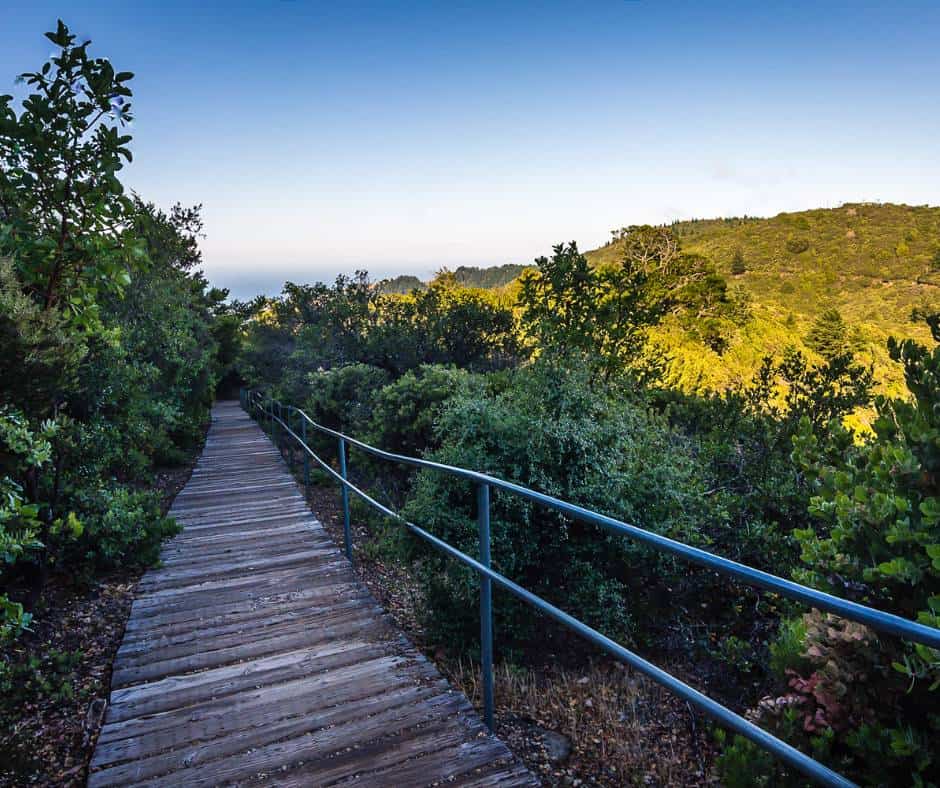
Why this park one of the best California State Parks: This park protects important natural resources near an urban area, including redwoods and coastline.
Best Time to Visit: Late summer and early fall so the fog is less likely to impede your views.
Are Dogs Allowed? Only at the campsite.
Where to Stay: There are a few different reservable campgrounds within the park but they book up fast. There is lodging available in Mill Valley and the surrounding towns.
Mount Tamalpais, or as the locals call it- Mount Tam, is a 2,571-foot peak rising over Marin County that begging to be explored. From atop Mount Tam you can see San Francisco, the East Bay, and the Farollon Islands 25 miles offshore.
Mount Tam has been used by Californians for recreation ever since the Gold Rush. In 1896, the Mount Tamalpais Scenic Railroad was built and billed as the “crookedest railroad in the world”. There were 281 curves on the ride from Mill Valley to the summit. Eventually cars replaced the railroad.
For generations, the redwood forests and coastal trails have provided a great escape from urban and suburban life. Bikiing is allowed on all roads, fire roads, and the Coast View Trail. There are 60 miles of hiking trails within the park, several of which connect to trails in neighboring Muir Woods National Monument and the Golden Gate National Recreation Area.
Since this park is within a major metropolitan area, it can be very busy, especially on weekends and holidays. The early bird most certainly gets the worm when it comes to parking.
Antelope Valley California Poppy State Natural Reserve
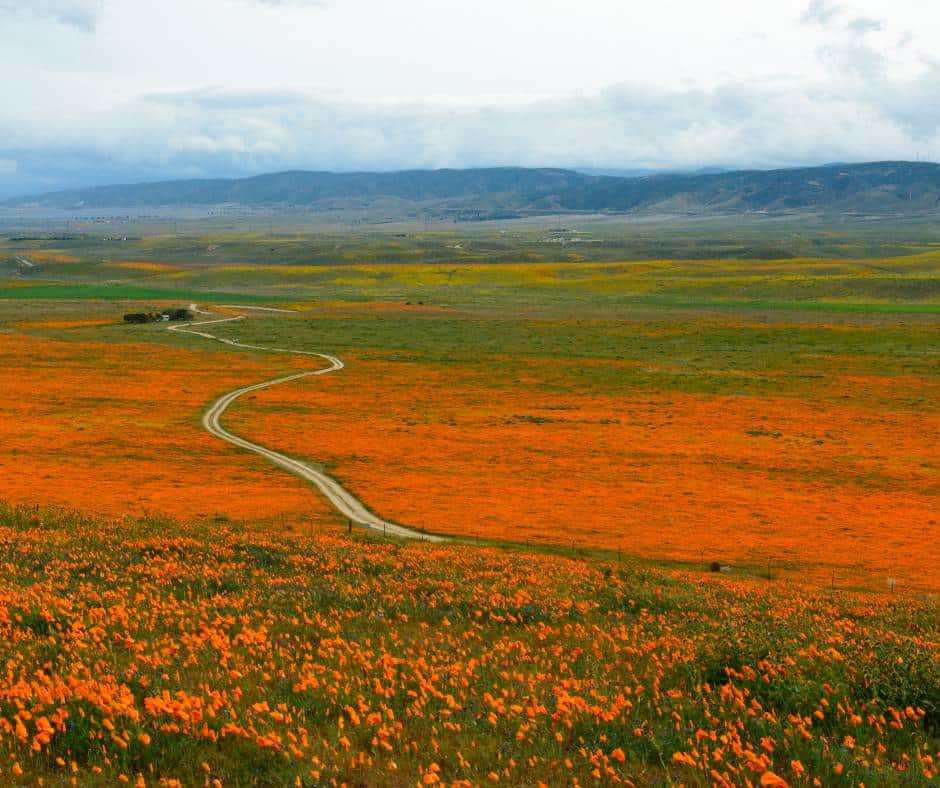
Why this park one of the best California State Parks: It provides protection to wild fields of California poppies.
Best Time to Visit: During the spring wildflower bloom after a strong rainy season.
Are Dogs Allowed? No
Where to Stay: There are a number of hotels nearby in Lancaster like the Best Western Plus Desert Poppy Inn.
The California poppy is our state flower, and it also happens to be my favorite flower. Once you see it bloom in mass, it will take your breath away. I love poppies so much we named our dog, Poppy!
One of the best places to see acre upon acre of bright orange poppies is at the Antelope Valley California Poppy Reserve during the spring bloom. The wildflower blooming season is dependent on rainfall, but typically take place mid-March through April.
Before you head out to the poppy fields, check out the small interpretive center, where kids can see taxidermied versions of the wildlife that call this area home. There are educational displays highlighting plants & wildlife, a short video, as well as a gift shop.
There are eight miles of trails to enjoy and several benches to stop at along the way. Besides poppies visitors can see lupines, goldfields, clover, and cream cups. Remember, look at but don’t touch these delicate flowers. Call the Poppy Hotline for flowering updates: (661) 724-1180.
CTL Tip: Arrive at the Reserve near opening in order to secure a parking spot, especially during big bloom years. Keep in mind the poppies will close if there is no sun. Though you are in the desert, the weather can often be windy and chilly.
]]>Of course, we highlight popular destinations like South Lake Tahoe in the north and Big Bear in the south, but there are so many other California mountain towns worth visiting and endless things to do once you arrive, especially if you enjoy being outside. These are our picks for the 25 best mountain towns in California, along with what to do and where to stay while you are visiting.
Best Mountain Towns in California
1. South Lake Tahoe

Elevation: 6,237′
Population: 22,535
Can’t-miss highlight of this California mountain town: World-class skiing and one of the most beautiful lakes in the world.
Perhaps the most well-known mountain town in California and certainly one of the largest, South Lake Tahoe is a major vacation destination for ski enthusiasts, hikers, water sports aficionados, and even gamblers, thanks to its location straddling the California/Nevada state line.
South Lake Tahoe is a place where you can either stay in a luxury cabin on the lake or tent camp among the towering pines and curious black bears, making it a destination for all budgets.
Visiting Emerald Bay State Park, skiing at Heavenly Mountain Resort, picnicking at Fallen Leaf Lake, and a day cruising on the lake are among our favorite things to do in South Lake Tahoe.
Insider tip: If you love miniature golf, you will definitely want to visit Magic Carpet Golf which has two, 19-hole courses and one 28-hole course filled with great hazards and structures to enjoy. It is definitely one of the best mini-golf spots in the state.
Stay Here: Camp Richardson is a beloved historic resort just outside of town with a beach, marina, camping, and lodging. Even if you don’t stay here you will want to stop in and visit the Beacon Bar and Grill, a restaurant on the water that is well-known for its Rum Runners and the best calamari strips in the state!
Lake Tahoe is one of our favorite Northern California weekend getaways. See what else made our list!
2. Tahoe City
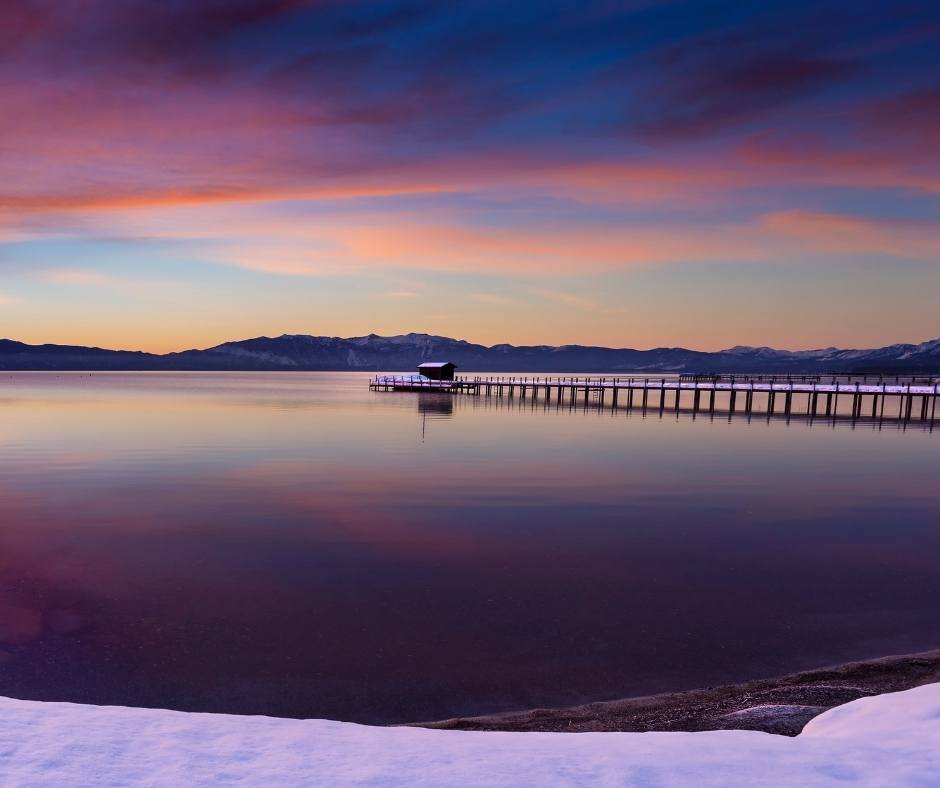
Elevation: 6,250′
Population: 1,555
Can’t-Miss Highlight of this California Mountain Town: Skiing at a former Olympic venue, Palisades Tahoe (formerly Squaw Valley).
The north shore of Lake Tahoe is much quieter than the bustling south shore, and home to the much smaller town of Tahoe City. The small downtown strip is lined with quaint shops and restaurants, and has a nice walking path along the shore.
This side of Lake Tahoe is closer to Interstate 80, and just 45 minutes from Reno. It is close to a few great ski resorts- Palisades Tahoe, Alpine Meadows, and Northstar. They all have varied terrain and offer some of the best sking in the country.
In the summer, popular activities include floating down the Truckee River, beach days at the lake, hiking on trails such as the Tahoe Rim Trail, and rides aboard the Tahoe Gal, a ship that cruises Lake Tahoe from Tahoe City. The sunset dinner cruises are especially nice.
Insider Tip: If you have newbies or young kids with you, check out Granlibakken, which is great for beginning skiers and snow boarders. It is also a popular spot to go sledding, snowshoe, and even cross country ski.
Stay Here: Granlibakken Tahoe is situated on 74 acres in Tahoe City and is filled with onsite activities no matter the season. Mourelatos Lakeshore Resort has a 275-foot private beachfront and each room features a lake view and a full kitchen over in the Tahoe Vista area.
3. Truckee
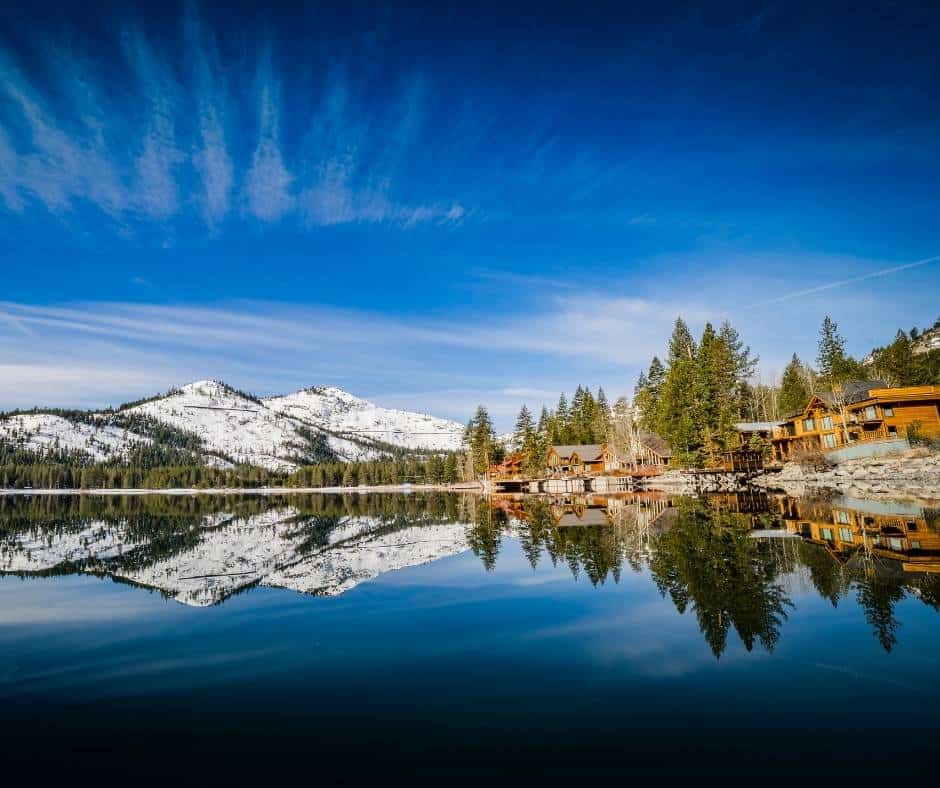
Elevation: 5817′
Population: 16,666
Can’t-Miss Highlight of this California Mountain Town: Donner Memorial State Park, home to Donner Lake and site of the Donner Party tragedy.
The largest mountain town in California along bustling Interstate 80, Truckee is home a great home base for exploring the Tahoe region, taking day trips to Reno, or vacationing at Donner Lake.
In the winter, Truckee is often snow-covered, and the many vacation homes in the area serve families well who are looking to visit a local ski resort- Tahoe Donner, Boreal, Sugar Bowl, Soda Springs, Northstar, Palisades Tahoe, and Alpine Meadows are all within 30 minutes.
Truckee is a town filled with history and a great frontier-vibe with a cute downtown. It is also home to Donner Memorial State Park. While many people stop at this park to learn about the Donner Party, there are also eight miles of hiking trails which are great to explore once the snow has melted.
In the summer, Donner Lake becomes the main attraction for vacationers enjoying fishing, boating, and water sports.
If you are looking to take a unique hike, check out the Donner Summit Tunnels. They were built by Chinese laborers in the 1800s and abandoned in 1993 when a new route was established. They are are very cool to walk through as part of an easy, 4.5-mile round-trip hike. Be sure to bring a flashlight!
Insider Tip: Wake up early to enjoy breakfast at Squeeze Inn, a beloved cafe that is well-known for serving up 60 different specialty omelettes.
Stay Here: The only hotel lodging on the lake, Donner Lake Village has its own private beach and marina, as well as plenty of lake-view rooms. Also check out VRBO or AirBnB for cabin rentals.
4. Big Bear Lake

Elevation: 6,752′
Population: 5,302
Can’t-Miss Highlight of this California Mountain Town: Strolling through Big Bear Lake Village. This charming little downtown district is filled with cute little shops and fun restaurants. You can even take a horse-drawn carriage ride through town!
Big Bear has been one of the most popular weekend getaways in Southern California for generations. My great grandfather built a cabin up near Big Bear Lake nearly 100 years ago and since then, the word has definitely gotten out about this special place!
After a winter storm you will find Big Bear jam-packed with Southern California residents eager to see and play in the white stuff. If you want to avoid a traffic jam, try to time your winter visits for mid-week.
You can ski at either Bear Mountain or Snow Summit, enjoy snow tubing at Magic Mountain, and even joining snowshoeing tours with the folks at Big Bear Discovery Center.
In the warm season, Big Bear is still an ideal weekend getaway for those who want to enjoy some cool mountain air. There are several hiking trails in the area as well as Big Bear Lake to enjoy. Rent a pontoon boat, go fishing, or just have a picnic by the water.
Insider Tip: Fall is a great time to visit Big Bear Lake if you want to enjoy changing leaves, pleasant temperatures, and few crowds.
Stay Here: Big Bear is a great place to rent a cabin. Big Bear Vacations has a great inventory of cabins at various size and price points.
5. Lake Arrowhead
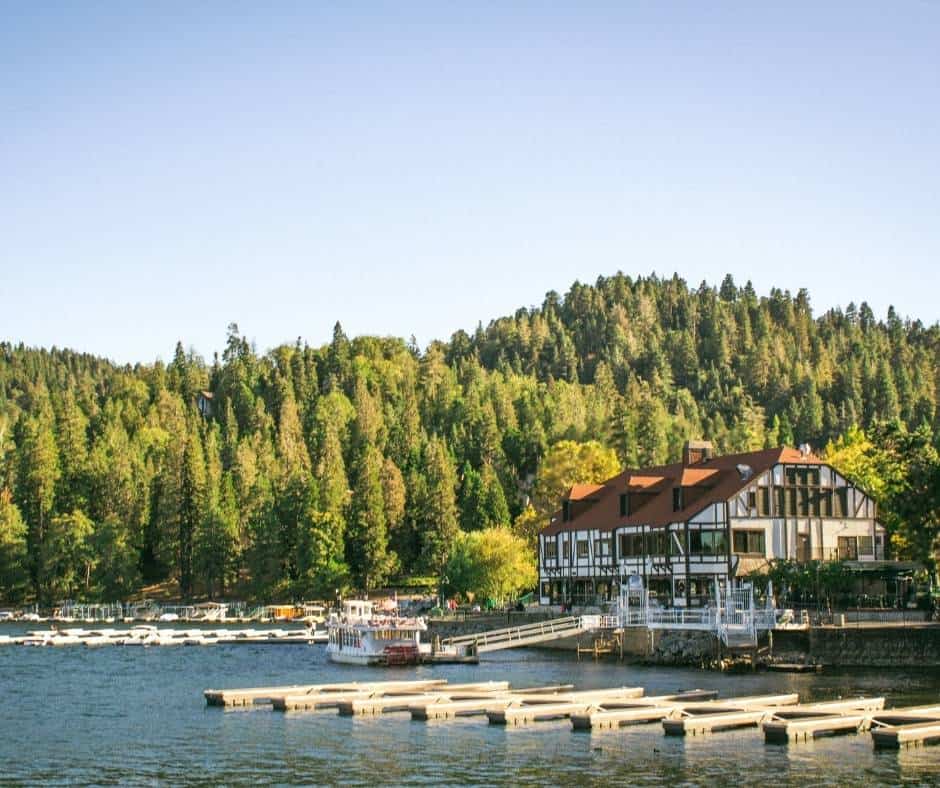
Elevation: 5,174′
Population: 9,741
Can’t-Miss Highlight of this California Mountain Town: Admiring all the beautiful homes that line the lake from a boat or paddleboard.
Just 80 miles from Los Angeles, Lake Arrowhead might as well be a world away. Originally known as Little Bear Lake when it was created as a reservoir in the 1890s, Lake Arrowhead has been a resort community for 100 years.
Access to the lake is reserved for residents or guests staying at Lake Arrowhead Resort & Spa. It is warm for a high elevation lake, and great for waterskiing, paddleboarding, boating, fishing, and kayaking. You can also embark on the Arrowhead Queen‘s one-hour boat tour around the lake and catch views of celebrity homes.
Lake Arrowhead Village is both charming and dog friendly. It plays hosts to several events and festivals like concerts in the summer and a bonfire in the winter.
SkyPark Bike Park at Santa’s Village is a popular spot for mountain bikers when there isn’t snow on the ground and Santa’s Village is a great family destination no matter the season. In addition to the bike park and village there is archery, rock climbing, axe throwing, a train ride, zip line, and more.
Insider Tip: Grab a beer from Lake Arrowhead Brewing Company and head to Lou Eddies Pizza, a little pizza joint in the forest that is winning awards and was even been named one of Yelp’s 100 top restaurants in the United States!
Stay Here: Lake Arrowhead Resort & Spa is where you will want to stay if you want to enjoy all the lake perks, and a spa. Ask for a lakeside room with a balcony to full take advantage of location, location, location.
6. Oak Glen
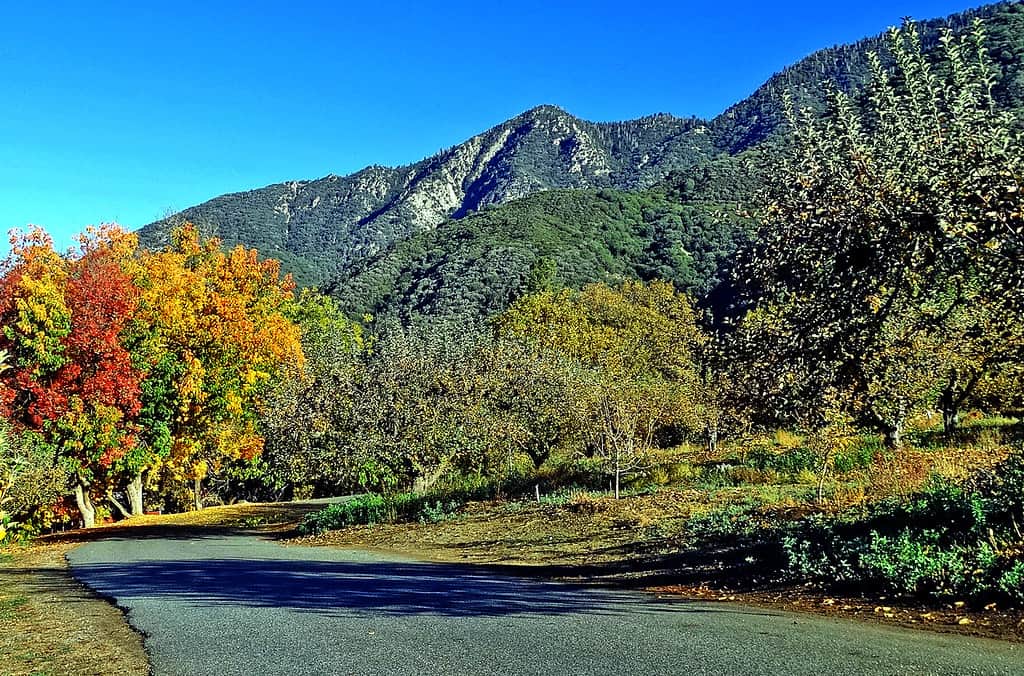
Elevation: 4,734
Population: 307
Can’t-Miss Highlight of this California Mountain Town: Apple picking in September and October.
Set right at the snowline in the San Bernardino Mountains, Oak Glen is a tiny hamlet that is well-known for being the premier apple picking destination for the LA metropolitan area.
For most of the year, things are relatively quiet but come autumn, Oak Glen becomes quite the bustling destination, especially on the weekends. In all, there six seasonal u-pick apple farms to visit.
Los Rios Rancho Apple Farm is the largest apple farm in all of Southern California, and quite historic as well; it was has been in operation for nearly 115 years! In addition to growing 32 different varieties of apples, they also have u-pick strawberries and raspberries in the summer, pumpkins in October, and chestnuts in November and December.
In addition to the apple farms and cider mills, you will also want to make time to visit the Oak Glen Preserve which protects 900 acres and is home to the Southern California Montane Botanic Garden. The Montane Garden features a couple ponds, a wetlands boardwalk, a section dedicated to the conifers of California, a deciduous forest, seasonal wildflowers, and a Children’s Outdoor Discovery Center.
Insider Tip: Oak Glen is a great place to enjoy fall foliage in Southern California. Colors tend to peak late October through mid November. The colors of the deciduous trees really pop against the oaks and evergreens.
Stay Here: Most people visit Oak Glen as a day trip but there are a couple cute AirBnb options in the area.
7. Mammoth Lakes
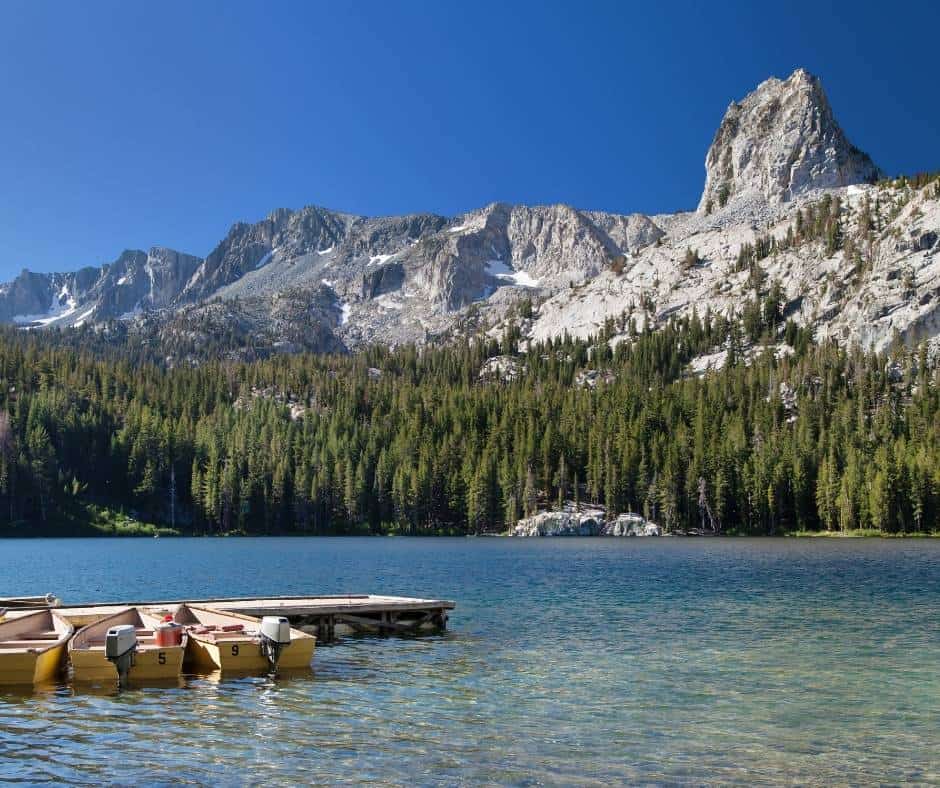
,Elevation: 7,881′
Population: 8,263
Can’t-Miss Highlight of this California Mountain Town: Epic skiing in the winter and epic hiking in the summer.
Mammoth Lakes is the most popular ski destination in the Eastern Sierra. Though it is about equidistant from Los Angeles and San Francisco, it is much more popular with Southern California residents because NorCal folks have to drive past so many of the Tahoe-area resorts in order to reach Mammoth.
Mammoth Lakes is just on the other side of the Sierras from Yosemite National Park, and receives well over 200 inches of snow per year on average. On especially snowy years, Mammoth can receive over 600 inches of snow!
Mammoth Mountain Resort has one of the longest ski seasons in country. It typically begins in early November and runs through Memorial Day, though there has been skiing until the 4th of July on more than one occassion!
Mammoth Lakes may be known as a ski resort town, but during the warm months, there are even more things to do in Mammoth!
Mammoth Mountain Resort becomes a mountain biking destination, with 80 miles of trails that traverse the mountain. If mountain biking isn’t your thing, you can still take a scenic gondola ride up to the summit and enjoy the views.
There is also via ferrata and the Mammoth Mountain Adventure Center where kids can tackle climbing walls, a junior zip line, bounce on the bungee trampoline, and complete a ropes course.
One of the main attractions near Mammoth is Devils Postpile National Monument, an impressive and extremely rare example of columnar basalt. The national monument is also home to Rainbow Falls, a 100-foot waterfall.
Devils Postpile is one of 75 California Landmarks you should see before you die!
There is no official “Mammoth Lake”, but there are several wonderful lakes in the Mammoth Lakes Basin. Twin Lakes, Lake Mary, Lake George, Lake Mamie, and Horseshoe Lake are all connected via a paved bike path. If you are looking for a workout with plenty of views of Mammoth Lakes along the way, take the series of switchbacks up to Crystal Lake.
Insider Tip: Mammoth Lakes is a great home base for several day trips. Tioga Road is open during the summer, making a day trip to Yosemite National Park an easy option when the road is open. Mono Lake, an other-wordly saline soda lake is less than an hour from Mammoth Lakes as well.
Stay Here: Mammoth Mountain Resort has several lodging options including luxury homes, condos, and standard hotel rooms.
8. June Lake
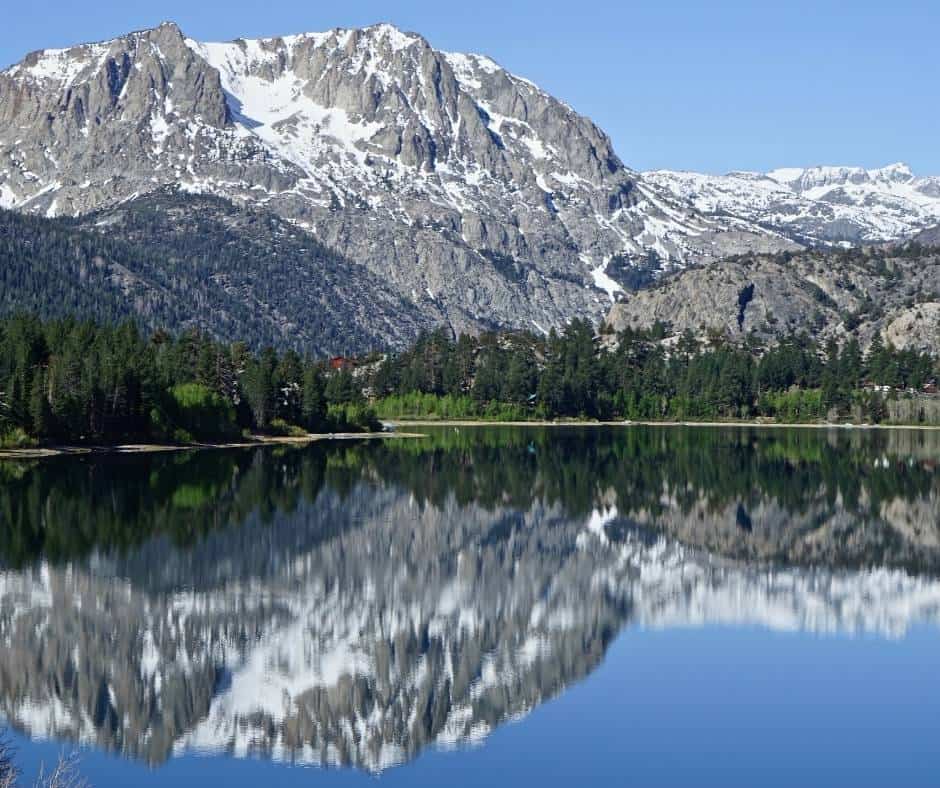
Elevation: 7,654′
Population: 413
Can’t-Miss Highlight of this California Mountain Town: Fall foliage season along the famed June Lake Loop.
June Lake is a small mountain resort town just north of Mammoth Lakes. It is home to June Mountain, a less expensive and less crowded alternative to Mammoth Mountain Resort. Families like this resort because kids under 12 ski for free, and beginners generally feel more comfortable on a mountain which caters to them.
Outside of ski season, people love to visit June Lake to enjoy hiking, fishing, camping, and just enjoying nature. Besides the namesake lake, the area is also home to several other lovely lakes like Gull Lake, Grant Lake, and Silver Lake.
June Lake is also a premier leaf-peeping destination. Quaking aspens flanking June Lake seem to glow as the sunlight penetrates their leaves. Granite mountainsides reflect in the lake’s waters with fiery trees highlighting the foreground. Foliage tends to peak in mid-October along the June Lake Loop.
Insider Tip: Parker Lake is an easy and excellent day hike near June Lake. The hike is just over 3.5 miles round trip and the reward is a peaceful lake framed by 12,000-foot peaks. Parker Creek runs along a portion of the trail, and brook trout and brown trout in the both lake and creek, so don’t forget your fishing poles!
Stay Here: Double Eagle Resort and Spa has a beautiful location at the base of Carson Peak. Choose from hotel rooms or two-bedroom cabins with fully equipped kitchens, fireplaces, and decks overlooking Ron’s Pond. They also have a large spa and fitness center.
9. Wrightwood

Elevation: 5,900′
Population: 4,362
Can’t-Miss Highlight of this California Mountain Town: Boasting the closest ski resort to Los Angeles, Mountain High Resort, Wrightwood also features some of the easiest mountain driving in the country, which is especially helpful for family members who get car sick.
Just 90 minutes from LA, Wrightwood is a small town that also features plenty of hiking, mountain biking, and snowshoeing trails; a local brewery with outdoor seating and regular live music; a thrilling zipline tour (with a line over 1500 feet long!); and plenty of local restaurants.
Speaking of a quick bite, don’t miss the pizza at Mile High Pizza, the wine cellar and tasting room at Village Grind, the breakfasts at The Grizzly Cafe, fine dining at The Blue Ridge Inn, and a bowl of healthy (or not so healthy) deliciousness at Bigfoot Bowls.
Insider Tip: The Pacific Crest Trail runs just above Wrightwood, so don’t miss the chance to walk a few steps on the famous trail that runs from Mexico to Canada. Head to the Grassy Hollow Visitor Center to hit the trail or take a few pictures at Inspiration Point nearby. On a clear day, you can see Catalina Island in the Pacific Ocean. The Big Horn Mine Trail is another best bet that ends at a mine that originally opened in 1895!
Stay Here: There are no major hotels or resorts in Wrightwood, but there are plenty of amazing cabins, inns, Bed and Breakfasts, AirBnBs and VRBOs in town with easy access to the town’s perks and the ski resort. Two best bets include the newly renovated Grand Pine Cabins and Wrightwood Sunshine Loft, an in-town AirBnB.
10. Pinecrest
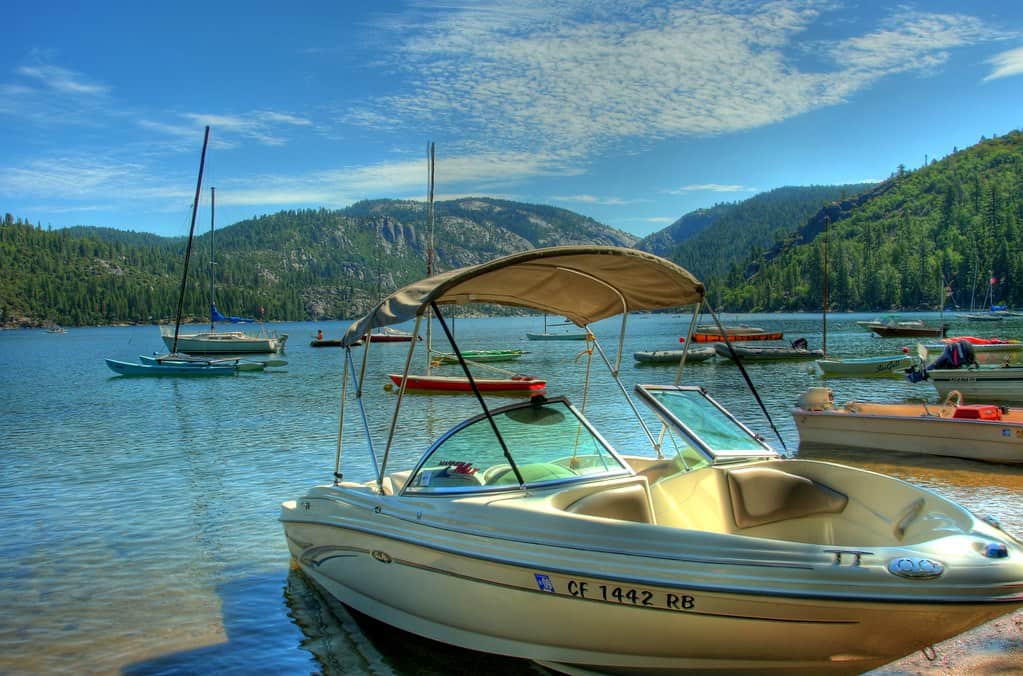
Elevation: 5,679′
Population: 150
Can’t-Miss Highlight of this California Mountain Town: Enjoying a day on Pinecrest Lake.
Pinecrest is a Sierra Nevada resort town located 30 miles east of Sonora off Highway 108. It home to Pinecrest Lake, a 300-acre lake owned and operated by Pacific, Gas and Electric Company.
The lake is a picture-perfect outdoor destination no matter the season. During the summer it is popular with boaters, campers, fisherman, and families looking to enjoy a day splashing by the shore. There is also a four-mile hiking trail, Pinecrest National Recreation Trail, which winds around the lake.
During the winter, Pinecrest is a popular place for snowplay as well as skiing at Dodge Ridge Ski Resort. Dodge Ridge is a smaller, family-focused resort, making it a more affordable option than the Tahoe resorts to the north. In recent years, Dodge Ridge has also been welcoming summer guests to enjoy mountain biking and disc golf as well.
Kennedy Meadows is close by and a great place to enjoy a horseback ride. They have a wide range of trip options, ranging from one hour to multiple days.
Insider Tip: If you are looking for some adventure and a great hike to a swimming hole, head to Cleo’s Bath. It involves a four-mile hike and some rock scrambling, but the rewards are worth your efforts. This is best experienced in the summer.
Stay Here: Pinecrest Lake Resort has a variety of lodging options- motel rooms, townhouses, and cabins. It also operates the Pinecrest Marina which rents party boats, kayaks, paddleboats, and motor boats.
11. Twain Harte
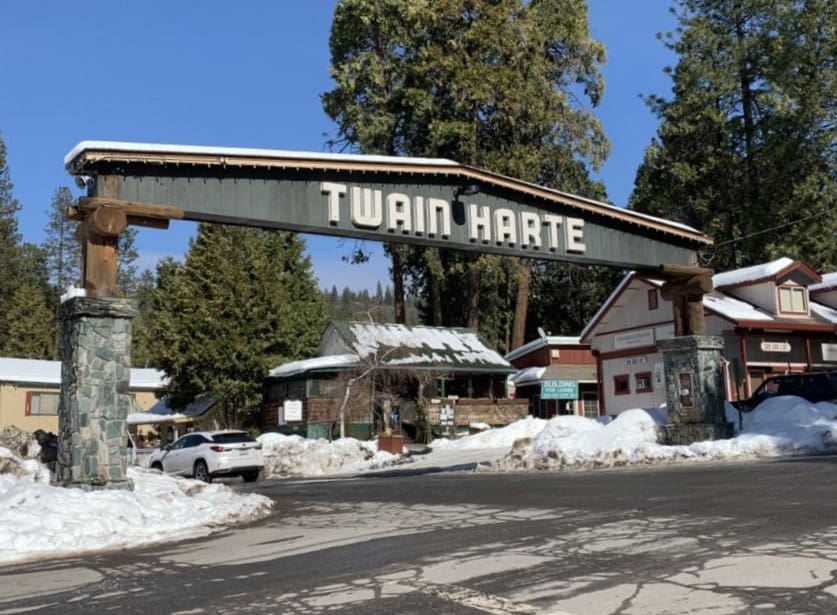
Elevation: 3,648′
Population: 2,502
Can’t-Miss Highlight of this California Mountain Town: Twain Harte Lake, a private lake that offers summer fun for families like swimming, picnicking, fishing, and paddleboarding.
Named for two authors that once lived in California, Mark Twain and Bret Harte, Twain Harte is a wonderful home base for exploring the Sierra Nevadas east of Sonora. It is no wonder that many Bay Area folks have vacation homes in Twain Harte.
Day trips to Yosemite are only about 90 minutes, so it is easy to explore the park and then return back to a spacious rental cabin. In the summer, Don Pedro Reservoir and New Melones Lake are popular destinations as well. Both lakes are great for water sports like boating, water skiing, and even house boating.
Head into Jamestown, just 20 minutes away, for a scenic ride on the historic Sierra Railway and a visit to Railtown 1897 State Historic Park.
Insider Tip: Head out on the Main Tuolumne Ditch Trail, a dirt single track trail with wooden water flumes ranging from several yards to one mile in length. These flumes have 2 x 12″ planks in place for maintenance workers so you can use them to walk across the flumes (or go around them if you don’t like heights). It is five miles from Twain Harte to Lyons Lake.
Stay Here: There are a few inns and bed and breakfasts in town, but if you want lake access you will want to rent a cabin with lake priviledges.
12. Dunsmuir
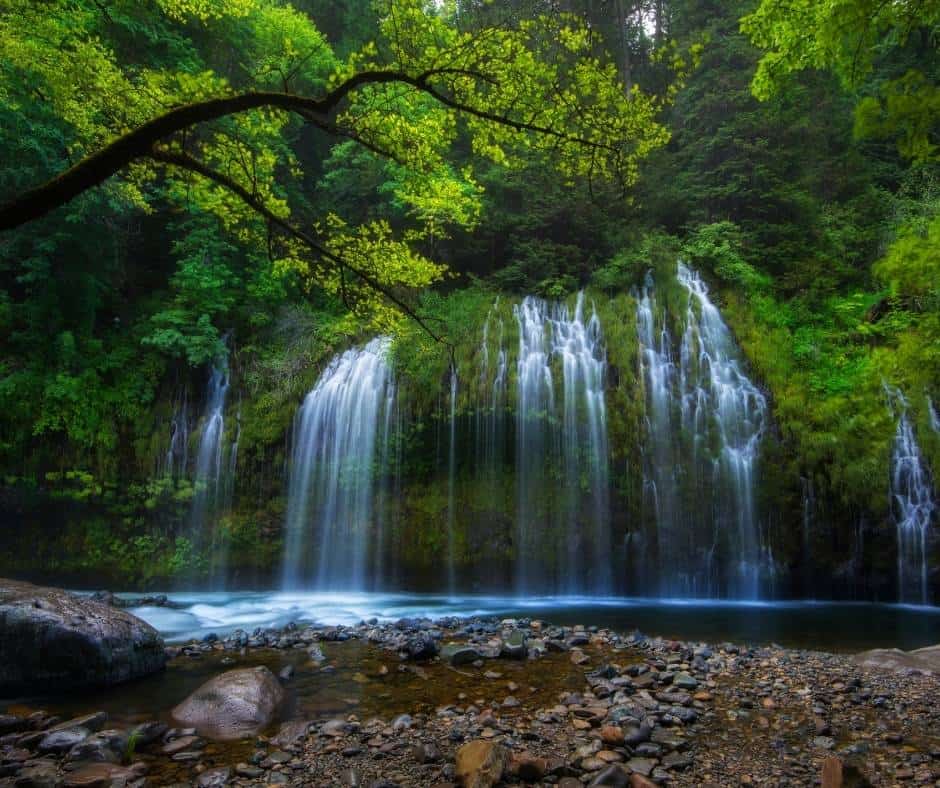
Elevation: 2,290′
Population: 1,870
Can’t-Miss Highlight of this California Mountain Town: Mossbrae Falls, one of the best waterfalls in Northern California.
Dunsmuir is located in the Trinity Mountains along the Upper Sacramento River, located just off Interstate 5. It is rugged and outdoorsy, with a rich railroad history.
Castle Crags State Park is located just outside of town. These 170-million-year-old formations are popular with hikers and rock climbers. There is also great fishing along the Sacramento River which passes through both the town and park.
There are a couple different waterfalls you will want to visit while in Dunsmuir. Hedge Creek Falls are located by the Sacamento River. Mosbrae Falls is a lush and elegant waterfall formed when pure spring water pours out of the moss-covered cliffside into the Sacramento River.
Mosbrae Falls is certainly the more impressive waterfall but it requires that people walk along the train tracks (which are private property) in order to access them, and this is considered trespassing.
Thousands of people do walk along the tracks to Mosbrae Falls every year, but thankfully the city of Dusnmuir has been working with the Mount Shasta Trail Association to build a trail that connects Hedge Creek Falls with Mosbrae Falls. They are actively taking steps forward to build the trail, but it seems like it is still in the “red tape phase”.
Insider Tip: This town is known for its great local water which plays a role in crafting tasty brews at Dunsmuir Brewery Works. Great beer is best accompanied by a great burger, and the brewery has those as well, including a popular elk burger.
Stay Here: If you are looking something unique and in line with the towns railroad history, stay at the Railroad Park Resort. There are over a couple dozen cabooses that have been converted into quaint lodging with private bathrooms, mini fridges, microwaves. The Castle Crags provide the perfect natural backdrop. There is even a restaurant on property in a coverted dining car!
13. Mount Shasta
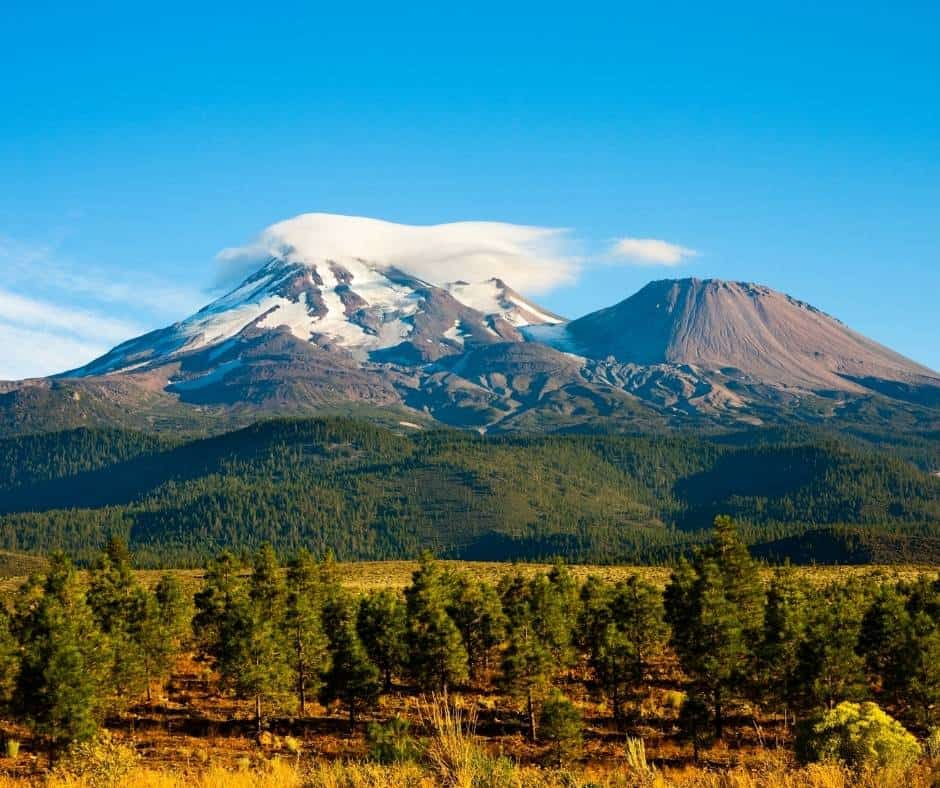
Elevation: 3,586′
Population: 3,250
Can’t-Miss Highlight of this California Mountain Town: Iconic Mount Shasta looming 14,163 feet above town.
Less than 10 miles north of Dunsmuir up Interstate 5 you will come to the town of Mount Shasta, the gateaway to the Shasta-Trinity National Forest and its namesake volcanic behemoth. This is a great destination for enjoying some of the amazing outdoor adventures that can be found in the northern reaches of the state.
The McCloud River Recreation Area is outside of town and home to McCloud Falls, a set of three waterfalls (Lower, Middle, and Upper McCloud Falls) interconnected by an easy, four-mile (round trip) trail. During the summer months, the pools below these waterfalls are fun places to swim.
Lake Siskiyou is less than three miles from downtown Mount Shasta. It is a popular spot for fishing, swimming, and walking or cycling the seven-mile Lake Siskiyou Trail which circumnavigates the lake. In the summer there is a beach with roped-off swim area, hourly SUP board and kayak rentals, and a Splash Zone with inflatable toys to play on in the lake.
Castle Lake is another great destination nearby. This lake is filled with pure water and has been studied by UC Davis for decades. I suggest taking the two-mile hike from Castle Lake up to Heart Lake, and enjoying the great views of Mount Shasta.
If it is caves you crave, Pluto’s Cave is not far from Mount Shasta and made our list of 25 Amazing Caves in California You Can Visit.
If you visit Mount Shasta in the winter you can enjoy the 32 downhill trails and terrain parks of Mt. Shasta Ski Park. There is also Mt. Shasta Nordic Center which has cross country trails.
Insider Tip: Interested in checking out the headwaters of the Sacramento River, the largest and most important river in California? Then head to Mount Shasta City Park, home to Headwaters Spring, the source crystal clear origin of the Upper Sacramento River.
Stay Here: Mount Shasta Resort is a great year-round destination set on over 125 acres at the base of Mount Shasta. There are one-and-two-bedroom chalets and some are lakeside. There is also a golf course and spa on property.
14. Chester
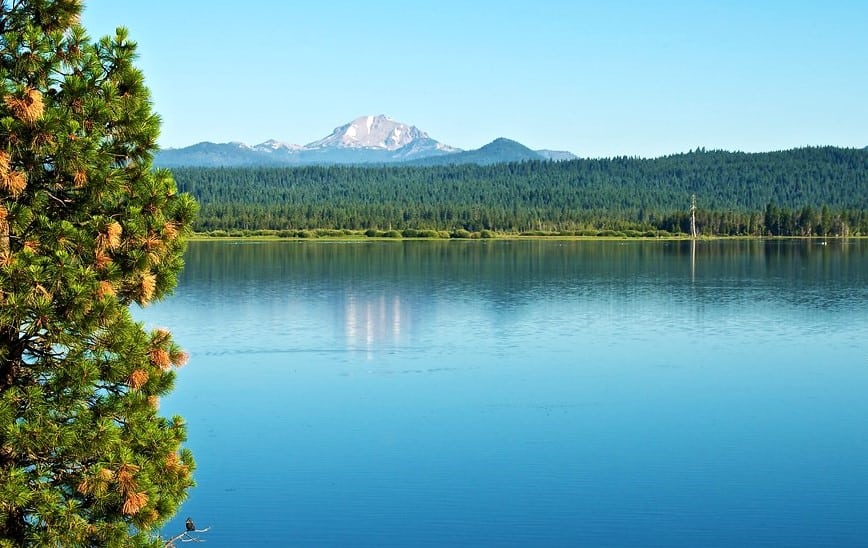
Elevation: 4,534′
Population: 2,088
Can’t-Miss Highlight of this California Mountain Town: Lake Almanor, the centerpiece of town and a popular vacation destination.
Chester serves as the gatewat to both Lake Almanor and Lassen Volcanic National Park, two major vacation destinations in northeastern California, especially during the summer. The road between Quincy and Lake Almanor is also a good place to enjoy fall foliage.
Lassen Volcanic National Park is just 30 minutes from Chester, and a great spot for those who want to experience an active volcano in the state of California. Lassen last erupted 100 years ago but it is still very much alive.
One of the best places to enjoy some geothermal action is on the Bumpass Hell Trail. This region is filled with bubbling mud pots and plenty of (stinky) sulfur steamworks which are accessed via a three-mile-round-trip trail that leads to a boardwalk which cuts through this active volcanic area.
Other trails in the area which are filled with volcanic features that you won’t want to miss include the three-mile trail to Boiling Spring Lake, a lake that remains at 120 degrees and 4.2-mile Devil’s Kitchen which second largest hydrothermal area.
Insider Tip: The road between Quincy and Lake Almanor is a great place to enjoy fall foliage.
Stay Here: There are several great vacation homes to rent around the lake, golf course, or forest but if you are looking for traditional lodging, Best Western Rose Quartz Inn is highly rated and includes breakfast.
15. Happy Camp
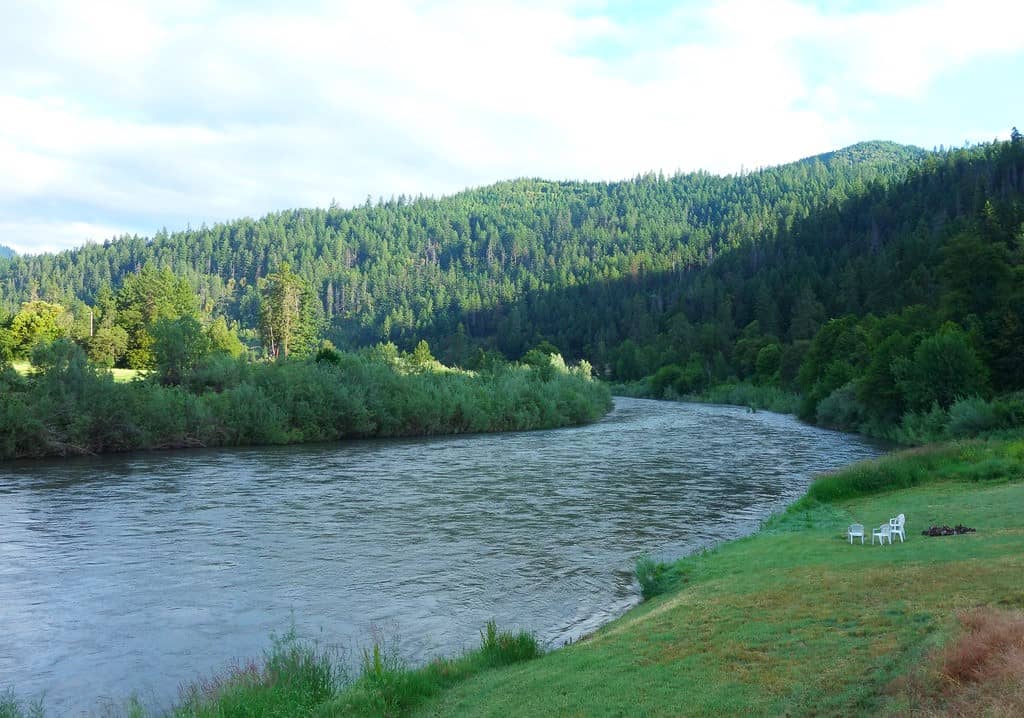
Elevation: 1,660′
Population: 861
Can’t-Miss Highlight of this California Mountain Town: The rugged Klamath Mountain Wilderness surrounding town.
Happy Camp is one of the most remote towns in California. It is located in far Northern California, about 30 miles from the Oregon border and 70 miles from the nearest major town of Yreka (and by “major” we mean a town of only 8,000 people).
It used to be a logging town but since the mills have shut down, it has become a haven for artists, outdoorsy folks, and those still embracing the desire to separate from California and form the State of Jefferson. You can even find State of Jefferson flags and shirts for sale around town.
Happy Camp is a popular destination for fishing Steelhead trout in the Klamath River, the second largest river in California. As a matter of fact, the town has deemed itself to be the “Steelhead Capital of the World”.
It is also a popular place to enjoy river rafting with three-day rafting trips on the Lower Klamath originating in town. This trip is a great option for beginners. There is also great mountain biking, camping, and hiking in this area.
Happy Camp is also known as “Bigfoot Country” and Bigfoot hunters come from all around with hopes of spotting this mythical beast. There is even a large Bigfoot sculpture created by local artists on Highway 96 on the eastern side of town!
Insider Tip: The Marble Mountain Wilderness portion of the Pacific Crest Trail passes near Happy Camp, a great backpacking destination.
Stay Here: Klamath River Resort Inn is a nice place to stay along the Klamath River. The property has a lovely lawn with chairs by the river, and it is a splendid spot to slow down and enjoy nature.
16. Groveland

Elevation: 3,136′
Population: 528
Can’t-Miss Highlight of this California Mountain Town: Exploring the Hetch Hetchy portion of Yosemite National Park, a region often missed by visitors.
Groveland is one of the gateway towns for Yosemite National Park, located off Highway 120. It has a rich California Gold Rush past and has been the center plenty of controversy revolving around its role as the base of operations for the nearby Hetch Hetchy Dam which supplies water to San Francisco.
Hetch Hetchy Valley is located inside of Yosemite National Park, about 35 minutes outside of town. The Tuolumne River winds through this valley which is said to be as beautiful as Yosemite Valley. Unfortunately it was flooded once the 430-foot-tall O’Shaughnessy Dam was built in the 1930s.
There has been a long campaign to remove the dam and return the valley to its natural state, but since it is the primary source of water for 2.5 million people and there is currently a water shortage in the state, these efforts haven’t been successful thus far.
This region is still very nice to hike, and the five-mile, round-trip hike to Wapama Falls shouldn’t be missed. The trail follows the shore of Hetch Hetchy Reservoir and is especially lovely during wildflower season.
Groveland was founded in 1848 (originally named “Big Oak Flat”) and is home to Iron Door Saloon, the longest continually operating saloon which opened back in 1852. The vibe at this bar and along Main Street definitely is reminiscent of the town’s Gold Rush past.
Groveland is home to Pine Mountain Lake, a private community with its own lake and golf course. It is a gated community but you can book a stay at a vacation rental and enjoy the ammenities.
Insider Tip: If you want more California history check out the Groveland Yosemite Gateway Museum which has exhibit on the Gold Rush, Hetch Hetchy, and exhibits highlighting local plants and animals, including a huge, stuffed 565-pound California Black Bear
Stay Here: Rush Creek Lodge is resort-style lodging within a short drive to Yosemite National Park. It has rooms, suites, and even hillside villas, as well as a spa. During the summer months you won’t want to miss their Poolside Summer BBQ which is perfect for families.
17. Wawona
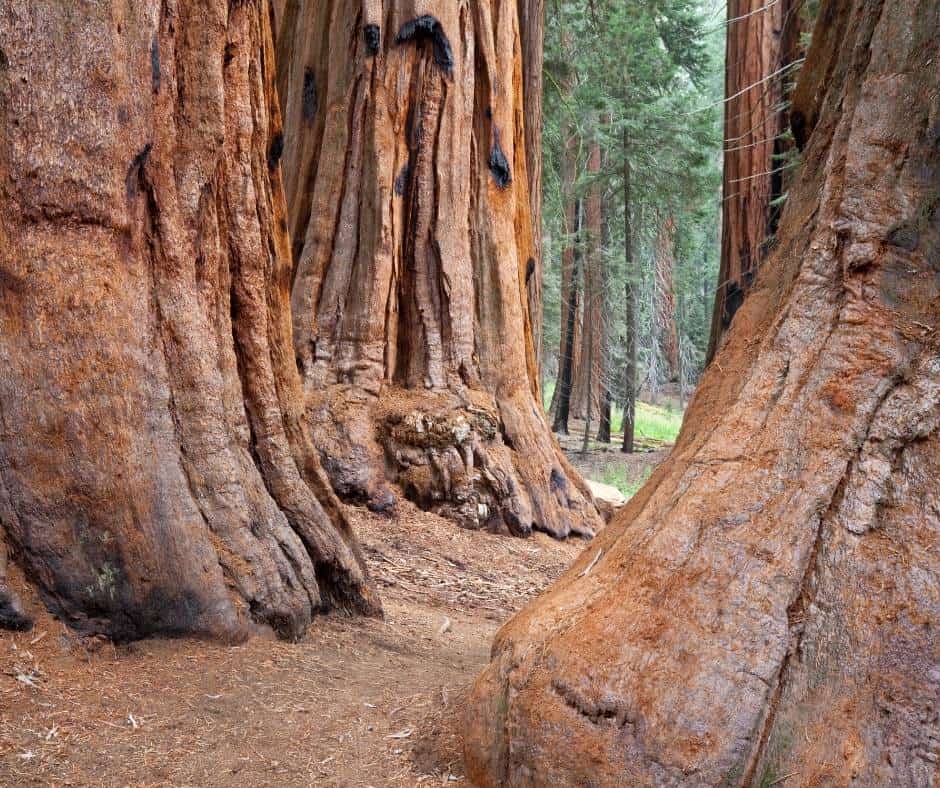
Elevation: 3,999′
Population: 166
Can’t-Miss Highlight of this California Mountain Town: The Mariposa Grove of Giant Sequoias.
Wawona is a historic town located entirely within Yosemite National Park at its southern entrance. It is one of the only places where you can rent a vacation home inside the park, and the only spot inside the park to enjoy horse-drawn wagon rides and see a covered bridge.
The biggest attraction in the area is probably the Mariposa Grove of Giant Sequoias, a magnificent forest of 500 mature Sequoias first protected by President Lincoln in 1864. Some of its most famous trees are the Grizzly Giant, Fallen Monarch, and the California Tunnel Tree.
You will also want to check out the Yosemite Mountain Sugar Pine Railroad in nearby Fish Camp. They offer narrated steam train rides which can include lunch or dinner. These scenic rides are in the Sierra National Forest, just outside of Yosemite.
Insider Tip: The Chilnualna Falls Trail is a strenuous one with 2,400 feet of elevation gained over 4 miles, but if you hike it along the creek for the first half mile, you can still enjoy some of the trail’s highlights and beauty without all the effort.
Stay Here: The Redwoods in Yosemite is a collection of vacation cabins inside the national park. They come in a variety of sizes and price points, and some are pet friendly.
18. Pine Mountain Club
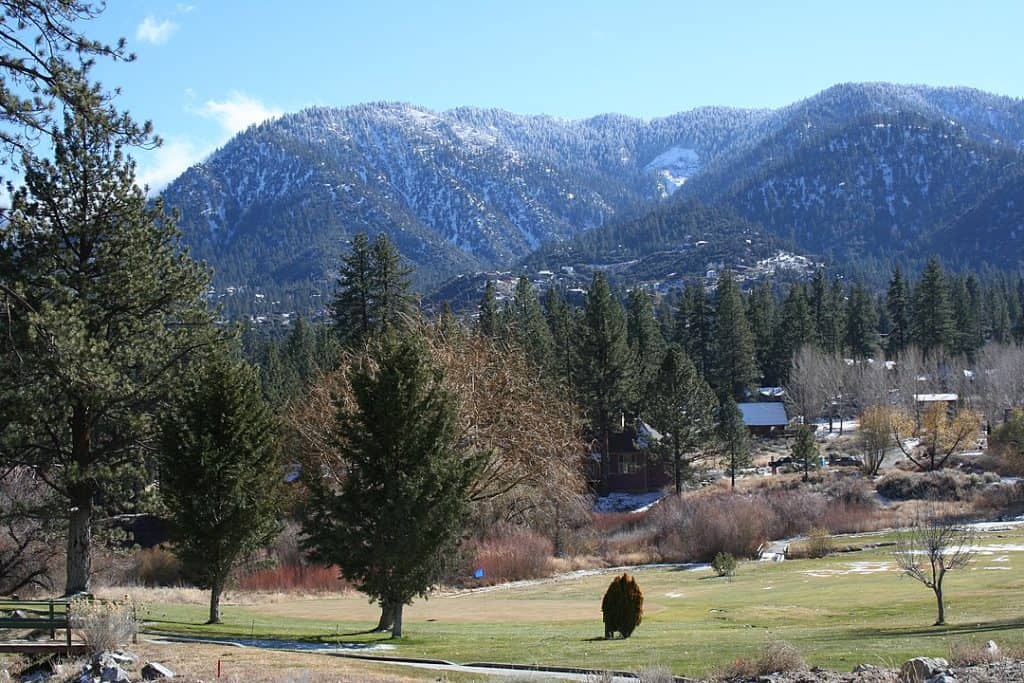
Elevation: 5,554′
Population: 2,315
Can’t-Miss Highlight of this California Mountain Town: Spotting rare birds of prey up on Mount Pinos.
Anyone who has driven the infamous “Grapevine” up Interstate 5 north of Los Angeles has driven past a few different Southern California mountain towns, but most don’t stop and explore. Believe it or not, there is plenty to enjoy once you get off the interstate.
Pine Mountain Club sits in the shadow of Mount Pinos, a 8,847′ peak dotted with Jefferey pines which sits on the border of Ventura and Kern Counties in the Los Padres National Forest. During the winter, this is a popular place to enjoy snow play, sledding, backcountry skiing, and even snow camping.
In the summer, the weather is a mild escape from the heat of the surrounding lower elevation cities of LA Metro and Bakersfield, and Pine Mountain Club is a great place to be outside. Hiking and bird watching are two great activities, especially since the areas is home to several birds of prey, including endangered California condors.
Hiking trail options include Eagle Pass Ridge which leads you to a scarf joint of the San Andreas Fault and the trail to Silverville Mine which is still being worked by the claimholder.
Insider Tip: Pine Mountain is a fun home base for ATVing. There are several trails in the area including ATV trails including Caballo, Marin, Toad Springs, Campo Alto, Mesa Springs, Sheep, Chula Vista, McGill, and Mt. Pinos.
Stay Here: Pine Mountain Inn is a charming inn close to all the perks of living in Pine Mountain Club. Each room has its own theme and decor.
19. Kernville
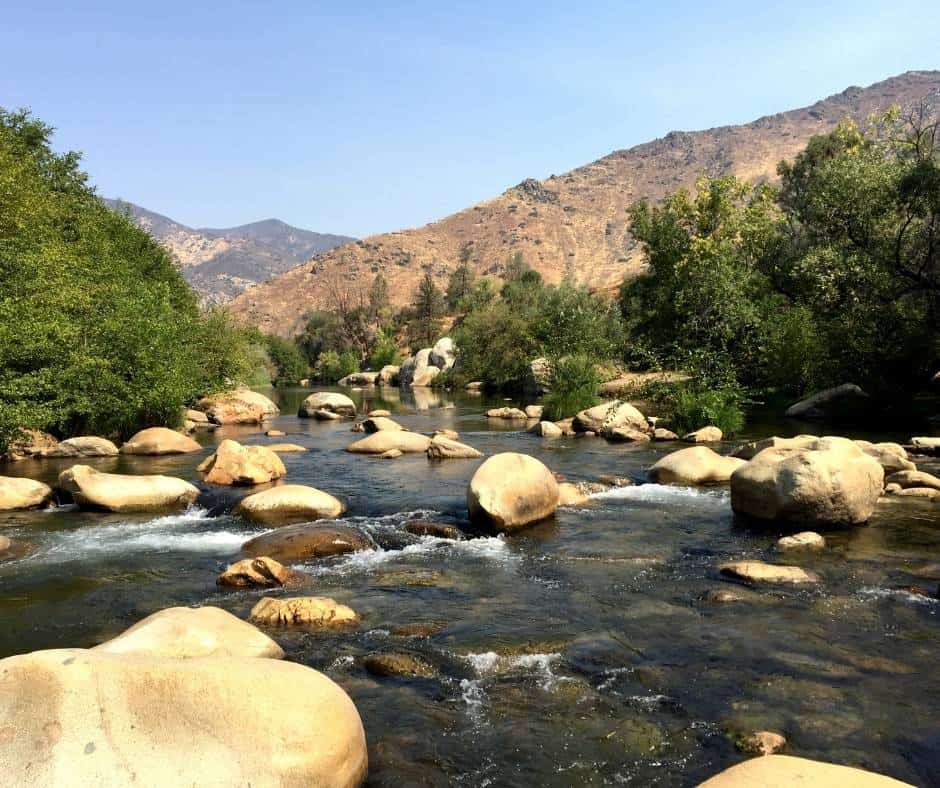
Elevation: 2,667′
Population: 791
Can’t-Miss Highlight of this California Mountain Town: Rafting the Kern River.
Kernville was founded as the mining settlement known as Whiskey Flat back in the mid-1800s. It was named after a whiskey saloon that was built to serve gold miners and outlaws that were attracted to the area.
Today, you can visit Silver City Ghost Town which is home to historical buildings from Whiskey Flat.
Today, Kernville attracts outdoor enthusiasts looking to go white water rafting, hiking, mountain biking, fishing, and climbing in the summer as well as skiing and snowboarding in the winter.
This town serves as the gateway to the southern Sierra Nevada mountains, as well as Sequoia National Forest. It is at a lower elevation than some other mountain towns in California, but since it is such an important gateway to the southern end of the Sierras, we wanted to include it.
The Kern River is a very popular destination for whitewater rafting. There is Class II and III whitewater in town, and Class IV and V whitewater further up the river. If you aren’t interesting in rafting but want to catch a glimpse of it, head to the deck Ewings Restaurant where you will see close to 100 rafts floating by per day during peak season.
One of the most popular day trips from Kernville is to the Trail of 100 Giants in Sequoia National Monument. This sequoia grove is located on the Western Divide Highway about an hour from town. It is home to 125 giant sequoias that are up to 20 feet in diameter and soar over 200 feet tall.
There is a 1.3-mile loop trail that winds through the grove which is a great alternative to the busy groves in Sequoia, Kings Canyon, and Yosemite National Parks.
If you visit Kernville during the winter and like to ski, head to Alta Sierra, a small ski resort that serves the communities in the southern Central Valley. They also have snow tubing.
Insider Tip: Visit the Kern River Brewing Company. It is owned by two former Olympic kayakers and was named the best small brewery in the country in 2019.
Stay Here: Corral Creek Lodge is small lodge along the Kern River outside of town that is a great central hub for enjoying outdoor adventure as well as pursuits in town.
20. Idyllwild

Elevation: 5,413′
Population: 2,963
Can’t-Miss Highlight of this California Mountain Town: Hiking one of the numerous trails in the area, including the Pacific Crest Trail.
Palm Springs and the rest of the Coachella are backed by the towering San Jacinto mountain range. While life in the valley is filled with scorching temps and palm trees, things change rapidly once you start climbing in elevation.
Idyllwild is a land of pine trees and boulders, making it an ideal Southern California mountain town escape. Most access the town on the Palms to Pines Scenic Byway, which winds its way through several different ecosystems as it climbs.
Idyllwild is one of those towns that doesn’t allow big chains to set up shop, so you will have the joy of patronizing a bunch of cute mom and pop shops. The heart of town is very walkable and has a definite mountain town vibe. It is also very welcoming to artists and hosts Idyllwild Art in the Park during several weekends throughout the year.
This is another one of those mountain towns in California that serves as a great home base for hiking or rock climbing. Mt. San Jacinto State Park has several great hikes, including the one to San Jacinto Peak, but many of them are strenuous since these mountains are so steep.
If you are looking for something more tame, head to the Idyllwild Nature Center which is the jumping off point for several easier-but-still-scenic trails in the area, including one that leads to Idyllwild Regional Park.
Insider Tip: If you are an animal lover, stop by the Living Free Animal Sanctuary. It is set on 155 acres and rescues cats, dogs, horses, and donkeys. Behind-the-scenes tours allow you to visit the cattery, dog kennel, and meet some of the horses and donkeys.
Stay Here: Most people who visit Idyllwild either camp or rent a cabin.
21. Pollock Pines
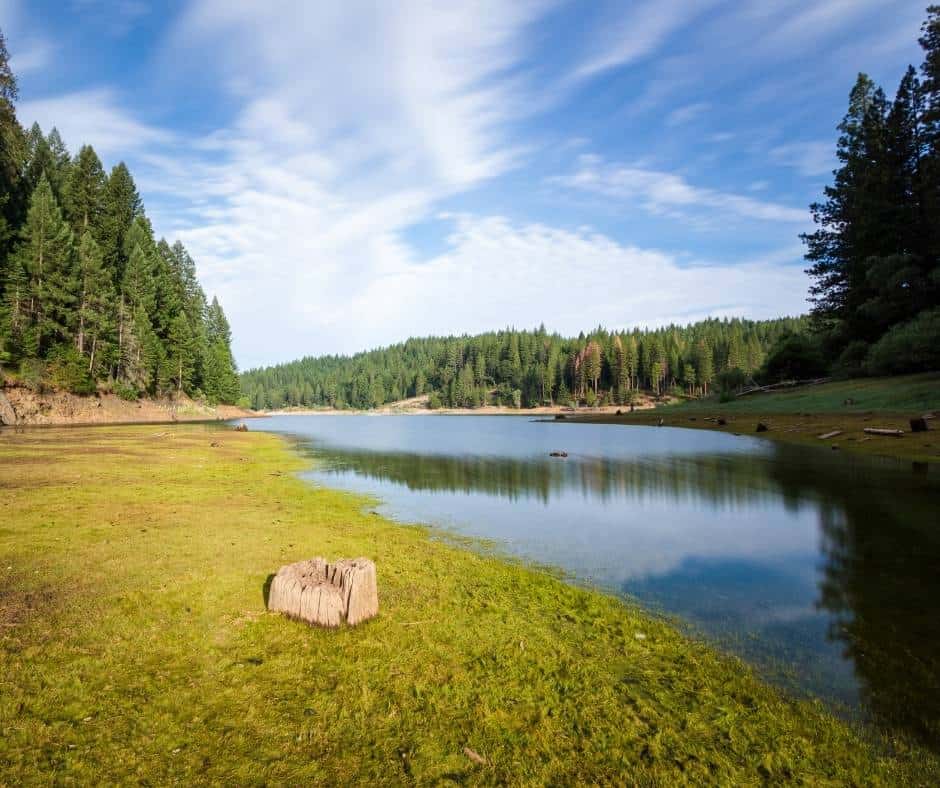
Elevation: 3,980′
Population: 6,480
Can’t-Miss Highlight of this California Mountain Town: Sly Park Recreation Area, home to Jenkinson Lake.
Pollock Pines is the largest mountain town along Highway 50 as it climbs in between Placerville and South Lake Tahoe. It sits in the El Dorado National Forest and is surrounded by dense pine forest and gets anywhere between six inches and six feet of snow per season.
Sly Park Recreation Area is located just outside of town. It is home to Jenkinson Lake, a fun spot to water ski, kayak, peddle boat, and fish. There are also nine miles of trails around the lake which can be hiked, biked, or ridden on horseback.
The town is close to Apple Hill, a collection of 50 family farms, most of which have wonderful apple orchards. During the fall, this region is bustling with tourists from the Sacramento area eager to pick apples, visit cider mills, select pumpkins, and experience all the booths and attractions that many of these farms have to offer. During December, it is also a major cut-your-own Christmas tree destination.
Insider Tip: Pollock Pines was one of the original stops on the Pony Express. Sportsman’s Hall, which served as the Pony Express station, is still in operation and serves up three meals daily.
Stay Here: The Best Western Stagecoach Inn is the best bet in town.
22. Meyers (+Twin Bridges)
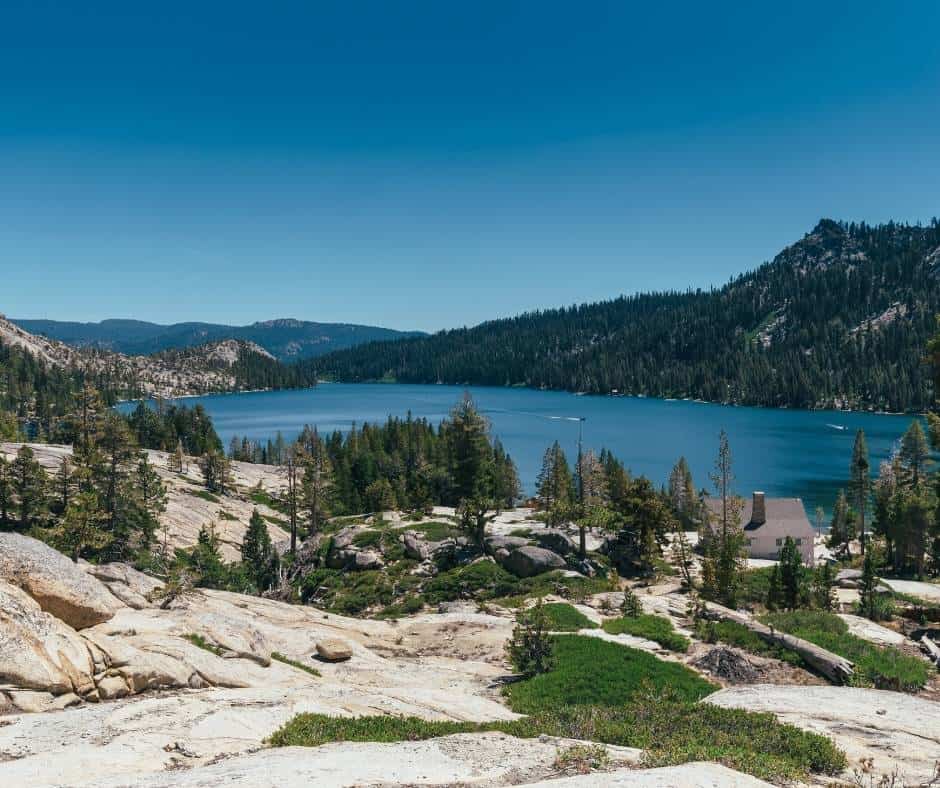
Elevation: 6,352′
Population: 2,396
Can’t-Miss Highlight of this California Mountain Town: Skiing at Sierra-at-Tahoe or hiking in nearby Echo Lake.
Another Pony Express stop in the mid-1800’s, Meyers is now known as the junction point for Highways 50 and 89, as well as a western suburb (if you can call it that) of South Lake Tahoe. Most people who visit Meyers use it as a homebase to explore the Lake Tahoe Region, including its many ski resorts.
Sierra-at-Tahoe Ski Resort is less than 10 miles away, just off Highway 50 in the tiny 30-person hamlet of Twin Bridges. Echo Lake Snow Park is five miles away and a popular place for snow play. If you want to try snowmobiling, Lake Tahoe Adventures operates in town and will take you out on a tour of nearby Hope Valley.
In the summer, hiking along the Echo Lakes is a popular activity. The Pyramid Creek Trail to Horsetail Falls is another popular destination as well.
Insider Tip: Enjoy a 5.8-mile, round-trip hike to Tamarack Lake by taking advantage of the water taxi to Echo Lake Chalet on Upper Echo Lake. Use the taxi on the outbound leg and then return by walking past the northern shore of the glacially carved Echo Lakes.
Stay Here: Most people visiting this portion of the Sierras either rent cabins or stay in South Lake Tahoe.
23. Julian
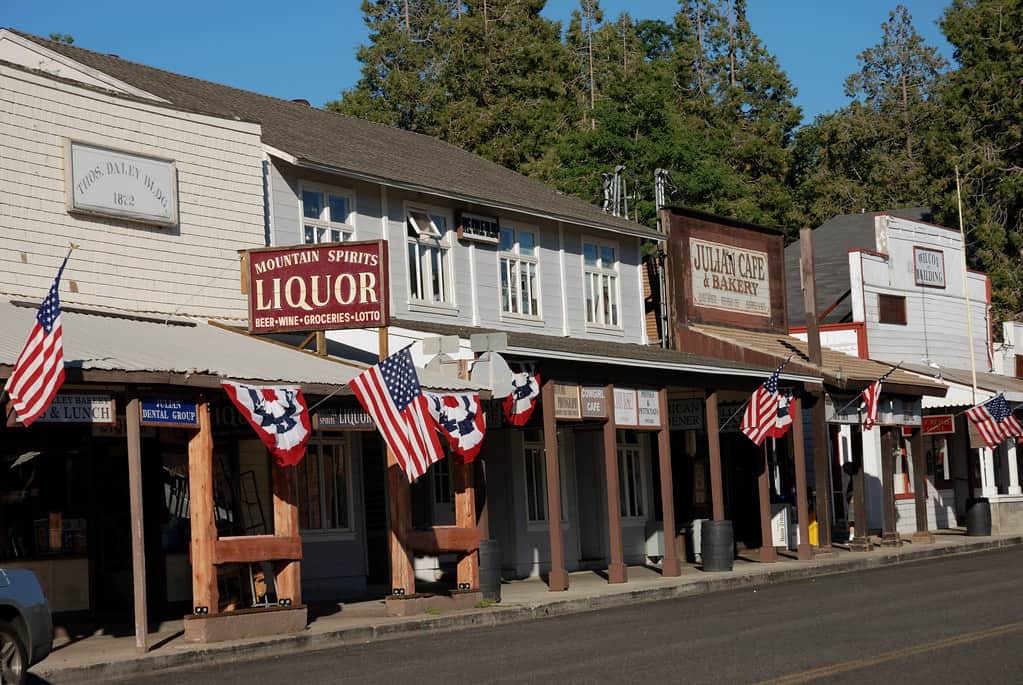
Elevation: 4,226′
Population: 1,318
Can’t-Miss Highlight of this California Mountain Town: Apple picking at one of the area orchards.
The southermost of all of the featured mountain towns in California is Julian, a cute and historic hamlet in the Cuyamaca Mountains east of San Diego. It was home to a gold rush which was sparked after gold was discovered in a nearby creek in 1870.
The gold rush only lasted 30 years, but you can still tour two of the original mines, Eagle and High Peak Mines, today.
Julian is also well known for its apple orchards, and you can pick your own apples straight from the trees during the fall. Local orchards and businesses also sell fresh-pressed apple cider, pies, and a variety of other seasonal goods. Stop in the Julian Pie Company on Main Street for delicious pies in flavors like Apple Mountain Berry and Caramel Apple.
Animal lovers will certainly want to visit the California Wolf Center which a nonprofit dedicated to returning wild wolves to their natural habitat through capitve breeding. They have been successful at breeding critically endangered Mexican gray wolves. Public tours are offered Friday through Sunday.
Insider Tip: Stop in Miner’s Diner to eat at the old-fashioned soda fountain which was originally installed in 1928. Try classic drinks like sarsparilla and phosphate or go big with a banana split or rootbeer float.
Stay Here: Embrace the town’s history and stay at the Julian Gold Rush Inn. This historic landmark hotel was built in the 1890s. Rooms are tastefully decorated with vintage decor and feature touches like claw-foot tubs and cast-iron fireplaces.
24. Placerville
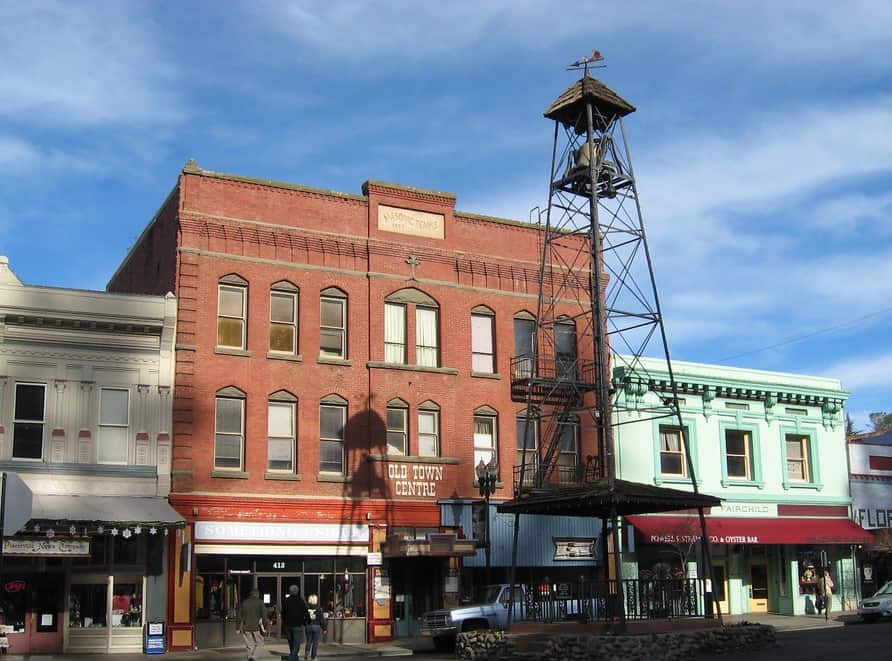
Elevation: 1,867′
Population: 10,869
Can’t-Miss Highlight of this California Mountain Town: Gold Bug Park and Mine, an authentic gold mine from the Gold Rush era.
Placerville is a Gold Rush town east of Sacramento that serves as a gateway to the Tahoe country, El Dorado Wine Country, as well as Gold Country. The town comes with a past common to the wild and wooly 1850s. As a matter of fact it was once known as Hang Town due to the fact that five men were once hung on the same day from the same tree.
Historic dowtown Placerville is the Fountain-Tallman Museum, where you can learn more about the town’s Wild West history, as well as “the oldest hardware store west of the Mississippi”- Placerville Hardware Strore, and lots of antique shops, galleries, stores, and restaurants. If you plan well, you can even take advantage of the free stagecoach rides offered once a month.
If you want to dive deeper into the town’s mining history, head to Gold Bug Park and Mine which offers tours and has a museum, historic stamp mill, blacksmith shop, and gem panning trough.
Insider Tip: Head up HIghway 50 to Apple Hill, a community of farmers that grow Christmas trees, pumpkins, and plenty of apples. During the fall and holiday seasons, this region is bustling with tourists visit the farms to enjoy festivals, food, apple picking, and plenty of fun.
Stay Here: Embrace the history of this California mountain town and by staying at the Historic Cary House Hotel. The property has plenty of antiques, some dating back to the 1850s, and is a short walk to all that Placerville’s Main Street has to offer.
25. Nevada City

Elevation: 2,477′
Population: 3,114
Can’t-Miss Highlight of this California Mountain Town: Lots of Gold Rush history and the Nevada City Winery, the oldest winery in the region.
Nevada CIty is yet another California mountain town with Gold Rush roots. It was settled in 1849 and the first mine, Gold Tunnel, was built in 1850.
Much of Nevada City’s downtown area has been deemed a historic district, with several buildings deemed California Historical Landmarks or on the National Register of Historic Places such as Nevada Theater (California’s oldest theater) and the National Hotel which is one of the oldest continuously operating hotels in the West.
If you love historic bridges, there are several which cross the numerous creeks and rivers in the area such as Edwards Crossing Bridge, Purdon Crossing, Hoyt’s Crossing, and South Yuba River Bridge.
Nevada City serves as the headquarters for the Tahoe National Forest, and there are several great hiking trails in the national forest as well as around town. The Independence Trail, a five-mile round-trip trail, is the nation’s first handicapped-accessible wilderness trail which was created by transforming a historic gold mine ditch!
Malakoff Diggins State Historic Park is another great place to visit. There, gorgeous red and white cliffs are exposed among the evergreens thanks to hydraulic mining generations ago. The park offers tours of the resident ghost town as well as guided gold panning.
Insider Tip: Visit during December to enjoy the town’s Victorian Christmas celebration. Enjoy wandering carolers dressed in Victorian attire, over 100 artisan vendors, visits with Father Christmas, and fresh roasted chestnuts.
Stay Here: The National Exchange is a historic hotel built in 1856 which has been recently renovated and is home to the National Bar (also historic with great ambiance) and fine dining at Lola, the hotel’s restaurant.
]]>